Sites: news | india | latam | brasil | indonesia
Feeds: news | india | latam | brasil | indonesia
topic: Invertebrates
Social media activity version | Lean version
Tanzania’s ‘mountain of millipedes’ yields six new species
- Scientists have recently described six new species of millipedes found in Tanzania’s Udzungwa Mountains.
- The six were among thousands of specimens collected by researchers studying forest ecology there and in the nearby Magombera Nature Reserve.
- Magombera was damaged by commercial logging in the 1970s-80s, and affected areas have been overrun by woody vines known as lianas.
- But teams working on the ground think that millipede diversity and abundance in liana thickets is equal to that of undisturbed forests, suggesting they may be dynamic places poised for forest regeneration with minimal human intervention.
In PNG, researchers record 9 new species of predatory hermaphroditic land snails
- A new study describes nine new species of land snails lurking in leaf litter across PNG. The discovery results from an extensive countrywide survey undertaken after a gap of 60 years.
- The newly identified snails, all grouped under the genus Torresiropa, are predatory hermaphrodites and about the size of a fingernail. They are restricted to single islands or mountain ranges.
- The discovery adds to the little-known biodiversity of mollusks in the country, and scientists expect to find many more new species in the future.
- As logging, road construction and other human activities threaten the rainforests of PNG, experts warn that human-mediated activities could drive many land snail species to extinction before they are even known to science.
Kenyan villagers show how to harvest more octopus by fishing less
- Residents of Munje, a fishing village south of the Kenyan port of Mombasa, have established an octopus closure to ensure sustainable fishing.
- Octopus catches in the reefs just offshore had been declining as larger numbers of fishers, often using damaging techniques, hunted this profitable species.
- Previous attempts to regulate the octopus fishery had failed, but the village’s beach management unit enlisted support from an NGO to replicate successful strategies from elsewhere.
- Clearer communication and patient consensus-building have secured buy-in from the community, and the village is anticipating a second successful harvest period in February.
Indonesian village forms coast guard to protect octopus in Mentawai Islands
- An island community in Indonesia’s Mentawai archipelago has responded to dwindling octopus stocks with a seasonal fishing closure to enable recovery.
- Global demand for octopus is expected to outpace supply over the medium term, implying higher dockside prices for many artisanal fishers, if stocks can be managed sustainably.
- Maintenance of local fishing grounds also offers crucial nutritional benefits for remote coastal communities in the Mentawais, where rates of child stunting exceed Indonesia’s national average.
Counterintuitive conservation: Fire boosts aquatic crustaceans in U.S. savannas
- In an interesting twist, two kinds of rare American freshwater crustaceans have been found to thrive after prescribed burns in their habitats.
- Populations of vernal pool fairy shrimp in Oregon and several species of threatened crayfish on the Gulf Coast increased after the removal of invasive plants, woody shrubs and trees from their habitats using fire or mechanical means.
- Fairy shrimp populations were shown to increase more than fivefold following habitat treatments that featured fire, while speckled burrowing crayfish also responded positively following fires set to favor nesting of sandhill cranes (whose own population has soared since).
- Both areas are savanna ecosystems that have relied on frequent fires over millennia — whether naturally occurring or intentionally set by Indigenous peoples — to maintain the open habitats to which myriad organisms have adapted.
The Socorro isopod: Endangered but important (commentary)
- The Socorro isopod is an endangered crustacean endemic to the thermal water of a spring in the state of New Mexico.
- Its population is relegated to just three small habitats, like a concrete pool built by the state to collect the hot water the isopods live in.
- “There is lot of attention paid to what are called charismatic megafauna [but] the Socorro isopod that is native to a spring that is smaller than most people’s offices doesn’t get the news or the attention grabbing headlines that some of the others do. But their plight is the same.”
- This article is a commentary. The views expressed are those of the author, not necessarily of Mongabay.
Can we save the spiky yellow woodlouse, one of the most endangered isopods? (commentary)
- Saint Helena Island’s spiky yellow woodlouse is a striking, critically endangered isopod that lives on tree ferns and black cabbage trees, high up in the peaks of Saint Helena’s cloud forests.
- The flax industry destroyed and fragmented most of the forests that the woodlouse depends on. Invasive species and climate change continue to affect them.
- The population of spiky yellow woodlouse is estimated to be at 980 individuals, so the Saint Helena National Trust is working to restore the forests on the island by clearing away the flax plants that were left behind and replanting more native flora.
- This article is a commentary. The views expressed are those of the author, not necessarily of Mongabay.
Winds of change: Detecting species from airborne DNA just got real
- In recent years, environmental DNA has enabled conservationists and citizen scientists to study entire ecosystems and to monitor elusive species that would otherwise evade detection.
- A suite of new research studies demonstrates that eDNA extracted from thin air can be used to identify a variety of plants and animals.
- Airborne DNA technology is potentially a valuable new tool for monitoring biodiversity, with particularly promising applications for monitoring rare and endangered species and providing early warning of invasive organisms.
- While a lot of work to hone the technique remains, experts are hopeful that prior advances in other eDNA technologies will help to accelerate the development of airborne DNA sampling so that it can be used in the field.
New assessment finds dragonflies and damselflies in trouble worldwide
- A global assessment of more than 6,000 dragonfly and damselfly species shows that 16% are at risk of extinction.
- The main threats to these insects are the human destruction of their wetland habitats, water pollution, and climate change.
- There are more dragonfly and damselfly species than there are mammals, yet they remain so understudied that the assessment failed to come up with enough data to determine a conservation status for more than 1,700 species.
- Researchers say better protecting the world’s wetlands would not only save the thousands of dragonflies and damselflies, but innumerable other species too, and provide us with better water quality and more carbon sequestration.
Extinction not only threatens primates—their parasites are in danger, too
- Primates threatened with extinction have highly specific parasites that will likely vanish if their hosts go extinct.
- Parasites play essential roles in ecosystems, but most are so understudied that scientists don’t understand the consequences of losing them.
- If in peril due to a diminishing number of hosts, parasites may try to jump to new host species—potentially triggering unforeseen infections.
Insects and other invertebrates on tropical islands face challenges as development and tourism expand
- Oceanic islands host 50 percent of the world’s endangered species, but human activities can greatly disturb these isolated ecosystems.
- The number and diversity of insects and other invertebrate species decrease on islands dedicated to urban development or tourism, according to a new study in the Maldives.
- Fragmented habitats take a toll on these species on urban islands, while pesticides are the suspected culprits on tourist islands.
Absorbent and yellow and … mobile? Sea sponges on the move in Arctic Ocean
- A new study suggests that sea sponges are moving across the seafloor of the Arctic Ocean, which challenges the idea that these creatures are primarily immobile.
- Previous research has shown that sponges can make limited movements in a laboratory setting, but this is the first time sea sponge trails have been observed in the ocean and attributed to sponge movement.
- The researchers hypothesize that the sponges are moving to find food or disperse juveniles, although further research is needed before conclusions can be drawn.
Here goes nothing: Male spiders found giving females silk-wrapped zilch
- Researchers describe how a South American spider species, Paradossenus longipes, uses silk-wrapped nuptial gifts in its courtship rituals.
- While other gift-wrapping spiders give potential mates edible prey or inedible leftovers, P. longipes surprised scientists by sometimes presenting females with empty gifts.
- The discovery of empty nuptial gifts in spiders raises questions about how the behavior evolved and the role it plays in sexual selection and mating success.
Invasion of the crayfish clones: Q&A with Ranja Andriantsoa
- An unusual invasive crayfish has been spreading in Madagascar, threatening aquatic biodiversity even as it helps nourish the country’s food-insecure population.
- The marbled crayfish (Procambarus virginalis) evolved only in recent decades as part of the German aquarium trade. It’s entirely female and reproduces clonally without males.
- Ranja Andriantsoa, a Malagasy biologist and epigenetics researcher, began studying marbled crayfish as a way to learn about cancerous tumors, which reproduce in a similar way.
- Andriantsoa’s ongoing research focuses on the social and health impacts of the marbled crayfish and aims to inform Madagascar’s strategy for managing the crayfish’s ecological impact.
New land snail species discovered in Hawaii offers ‘gem of hope’
- Scientists recently announced a new species of land snail, Auriculella gagneorum, which was found living in the Waianae Mountains in O‘ahu, Hawaii.
- There are three known populations of Auriculella perpusilla on O‘ahu, and a small number of snails were selected for a captive-breeding program to help conserve the species.
- Hawaii once had 752 species of land snails, but more than half of them are believed to have gone extinct due to habitat loss and invasive species.
Risking death and arrest, Madagascar fishers chase dwindling sea cucumbers
- For centuries, Chinese people have sought sea cucumbers as an ingredient in traditional medicine or as a high-status food.
- In recent decades, skyrocketing demand and prices have led to a marine gold rush for sea cucumbers around the world.
- In Madagascar, as elsewhere, wild sea cucumbers are declining.
- Fishers are venturing further out to sea and into deeper waters to pursue them illegally using unsafe SCUBA gear.
The sponge with the secret recipe: A cancer-fighting chemical
- Scientists have discovered that a common sea sponge growing in Indonesian waters produces a chemical called manzamine A that has been shown to fight cervical cancer cells in the lab.
- They say that if it can be produced at scale, manzamine A could be used to fight a wider variety of cancers as well as infectious diseases.
- Cultivating the sponge Acanthostrongylophora ingens at scale would also be beneficial to coastal communities and the Indonesian economy at large, the scientists say.
- And because the sponge has a high tolerance for poor-quality water, its cultivation can help purify contaminated water, buffer unspoiled reefs from pollution, and otherwise enhance the marine ecosystem.
An intrusive killer scorpion points the way to six new species in Sri Lanka
- A newly discovered endemic scorpion from Sri Lanka, Heterometrus yaleensis, has been named after the Indian Ocean island’s most popular wilderness area, Yala National Park.
- This is the sixth new scorpion species described from Sri Lanka by a research team that has carried out two surveys since 2015.
- Scorpions are a largely understudied group of invertebrates, but the present interest in Sri Lanka’s scorpions was sparked by a series of deaths caused by the invasive Indian red scorpion (Hottentotta tamulus) in the island’s north.
- Sri Lankan authorities foiled an attempt in January to smuggle 200 live scorpions out of the country by a Chinese national, highlighting the need for greater efforts to prevent scorpions falling prey to the illegal wildlife trade.
Predators disproportionately impacted by human land use changes, study finds
- New research looking at whether particular types of wildlife are more affected than others by habitat loss determined that predators are the most impacted, as was expected — but the study results held some surprises nonetheless.
- Because the loss of plant resources makes it harder for large predators to find sufficient food when land use changes occur within their range, researchers expected to find that these types of animals would be especially affected.
- The analysis showed that predators are indeed more affected by habitat loss than other groups — but that larger carnivores are not threatened with the largest declines. It was small invertebrates that were found to face the worst impacts.
Plastic trash kills half a million hermit crabs on remote islands each year
- An estimated 570,000 hermit crabs become trapped and die in plastic containers on the remote Cocos (Keeling) Islands and Henderson Island each year, according to a new study.
- Accumulated plastics on beaches could cause a serious decline in hermit crab populations, the study’s authors say.
- Hermit crabs are at risk on beaches globally where crabs and plastic pollution overlap.
Western monarch butterfly numbers critically low for second straight year
- The latest annual count of western monarch butterfly numbers at their overwintering sites on California’s Pacific coast has revealed a second consecutive tally of less than the critical threshold of 30,000.
- The group behind the count says that figure may be the tipping point for the species, below which the population decline would accelerate into a downward spiral.
- A major threat to the butterflies is the loss of suitable habitat; 20 of their overwintering sites have been damaged by human activity in the past five years, and the vast majority of the remaining 400 sites lack protection.
- Scientists are calling on farmers to minimize pesticide use and plant climate-adapted hedgerows; land managers to restore habitat by growing monarch-suited vegetation; and ordinary citizens to make their own small yet meaningful contributions.
Two deaths trigger alarm at Mexico’s Monarch Butterfly Biosphere Reserve
- The body of Homero Gómez González, passionate defender the monarch butterfly and a Mexican reserve designed to protect it, was found on Jan. 29, two weeks after his disappearance was reported.
- Three days later, Raúl Hernández Romero, a tourist guide in the area, was also found dead, with evidence of violence.
- Homero Gómez, like other land-collective members in the area, collaborated in the creation of a model that seeks to help communities make sustainable use of forests.
Feral horses gallop to the rescue of butterflies in distress
- A new study suggests that returning feral horses to grasslands in Czech Republic could increase populations of some threatened butterfly species.
- The research shows that the horses’ grazing creates and maintains short grasslands that some butterfly species thrive in.
- The research points to the importance of considering the impacts of species introductions on the restoration of natural ecosystems.
Biodiversity boosts crop pollinators and pest controllers, study finds
- A new study looks at the reliance on biodiversity of ecosystem services provided by pollinating and pest-controlling insects.
- Up to half of the detrimental impacts of the “landscape simplification” that monocropping entails come as a result of a diminished mix of ecosystem service-providing insects.
- The scientists found that the reduction in ecosystem services provided by these insects tended to lead to lower crop yields.
Wilderness cuts the risk of extinction for species in half
- Wilderness areas buffer species against the risk of extinction, reducing it by more than half, a new study shows.
- Places with lots of unique species and wilderness with the last remaining sections of good habitat for certain species had a more pronounced impact on extinction risk.
- The authors contend that safeguarding the last wild places should be a conservation priority alongside the protection and restoration of heavily impacted “hotspots.”
New eDNA sampling system aims for cleaner, more efficient field research
- Researchers tested a new self-preserving filter housing system that automatically preserves eDNA from water samples, while reducing the risk of DNA contamination and plastic waste.
- Scientists who use eDNA currently rely on cumbersome cold storage or liquid preservatives and single-use sampling equipment to preserve their eDNA samples, which are highly sensitive to degradation as well as contamination.
- The new system incorporates a hydrophilic plastic material in its filter housing that physically pulls water from the sample without having to add chemicals.
- In a six-month test, it allowed data collectors to preserve samples quickly and easily, at ambient temperature and with far reduced plastic waste, preventing degradation for weeks and with slightly higher amounts of captured DNA than a standard method.
Thousands of endangered snails raised in captivity returned to natural habitat in Bermuda
- Due mostly to predation by invasive species of carnivorous snails and flatworms, greater Bermuda land snails (Poecilozonites bermudensis) were driven nearly to extinction in their native habitat on the oceanic islands of Bermuda over the past several decades. In fact, the snails were believed to have disappeared altogether until 2014, when a small population was discovered.
- It’s believed that there are less than 200 of the snails remaining in the wild, but that population has now been joined by 4,000 individuals bred in captivity in the UK and reintroduced on Bermuda’s Nonsuch Island — a nature reserve with strict quarantine protocols designed to ensure that alien species detrimental to the snails will not be introduced to the island.
- Following the 2014 rediscovery of the greater Bermuda land snail, scientists at the UK’s Chester Zoo and the Zoological Society of London launched a collaborative captive breeding program for the snails at the request of the Bermudian government. Over the past three years, the breeding program has built up a population of the snails with sufficient numbers to begin reintroductions in the wild.
Primates lose ground to surging commodity production in their habitats
- “Forest risk” commodities, such as beef, palm oil, and fossil fuels, led to a significant proportion of the 1.8 million square kilometers (695,000 square miles) of forest that was cleared between 2001 and 2017 — an area almost the size of Mexico.
- A previous study found that 60 percent of primates face extinction and 75 percent of species’ numbers are declining.
- The authors say that addressing the loss of primate habitat due to the production of commodities is possible, though it will require a global effort to “green” the international trade in these commodities.
The health of penguin chicks points scientists to changes in the ocean
- A recent closure of commercial fishing around South Africa’s Robben Island gave scientists the chance to understand how fluctuations in prey fish populations affect endangered African penguins (Spheniscus demersus) absent pressure from humans.
- The researchers found that the more fish were available, the better the condition of the penguin chicks that rely on their parents for food.
- This link between prey abundance in the sea and the condition of penguin chicks on land could serve as an indicator of changes in the ecosystem.
Interest in protecting environment up since Pope’s 2015 encyclical
- New research into the usage of environmentally related search terms on Google suggests that interest in the environment has risen since Pope Francis released Laudato Si’ in 2015.
- Laudato Si’, a papal encyclical, argues that it is a moral imperative for humans to look after the environment.
- Researchers and scholars believe that the pope’s support for protecting the environment could ripple well beyond the 16 percent of the world’s population that is Catholic.
’Unprecedented’ loss of biodiversity threatens humanity, report finds
- The U.N.’s Intergovernmental Science-Policy Platform on Biodiversity and Ecosystem Services released a summary of far-reaching research on the threats to biodiversity on May 6.
- The findings are dire, indicating that around 1 million species of plants and animals face extinction.
- The full 1,500-page report, to be released later this year, raises concerns about the impacts of collapsing biodiversity on human well-being.
Waters off Galápagos have way more alien species than previously known
- The waters off the Galápagos Islands have nearly 10 times more alien marine invertebrates than previously recorded, a new study has found.
- The study recorded a total of 53 non-native marine invertebrates (animals that lack a backbone, such as marine worms, sea squirts or moss animals) in the waters off two islands in the archipelago, up from five that were previously known.
- Researchers suspect there are many more non-native species present in the Galápagos waters that remain to be discovered.
Scientists urge overhaul of the world’s parks to protect biodiversity
- A team of scientists argues that we should evaluate the effectiveness of protected areas based on the outcomes for biodiversity, not simple the area of land or ocean they protect.
- In a paper published April 11 in the journal Science, they outline the weaknesses of Aichi Biodiversity Target 11, which set goals of protecting 17 percent of the earth’s surface and 10 percent of its oceans by 2020.
- They propose monitoring the outcomes of protected areas that measure changes in biodiversity in comparison to agreed-upon “reference” levels and then using those figures to determine how well they are performing.
Hunting pumas to save deer could backfire, new research suggests
- A new study finds that the age of individual pumas near Jackson, Wyoming, had the greatest influence over the prey they chose to hunt.
- Older mountain lions went after elk, among the largest prey species in the study area, while the younger cats hunted small animals like raccoons as well as mule deer.
- The research calls into question the validity of recent wildlife management plans in the western United States to grow mule deer populations by culling mountain lions, the authors say.
Malaysian state chief: Highway construction must not destroy forest
- The chief minister of Sabah, one of two Malaysian states on the island of Borneo, said that the Pan Borneo Highway project should expand existing roads where possible to minimize environmental impact.
- A coalition of local NGOs and scientific organizations applauded the announcement, saying that it could usher in a new era of collaboration between the government and civil society to look out for Sabah’s people and forests.
- These groups have raised concerns about the impacts on wildlife and communities of the proposed path of the highway, which will cover some 5,300 kilometers (3,300 miles) in the states of Sabah and Sarawak.
New maps show where humans are pushing species closer to extinction
- A new study maps out how disruptive human changes to the environment affect the individual ranges of more than 5,400 mammal, bird and amphibian species around the world.
- Almost a quarter of the species are threatened by human impacts in more than 90 percent of their range, and at least one human impact occurred in an average of 38 percent of the range of a given species.
- The study also identified “cool” spots, where concentrations of species aren’t negatively impacted by humans.
- The researchers say these “refugia” are good targets for conservation efforts.
Video: scientists capture giant spider eating an opossum
- For the first time, researchers have documented a giant spider eating an opossum in the Amazon rainforest.
- Writing in the February 28th issue of the journal Amphibian & Reptile Conservation, a team of scientists describe several rarely observed cases of invertebrates eating various vertebrates, including frogs, lizards, snakes, and even a mammal — a mouse opossum.
- The mouse opossum incident occurred in 2016 in the Peruvian Amazon and was captured on film by biology students.
- The sighting was the first of a mygalomorph spider — a group of large spiders that includes tarantulas — preying on an opossum.
World’s largest bee filmed alive for the first time in Indonesia
- The world’s largest known bee, the Wallace’s giant bee, has been photographed and filmed in Indonesia’s North Maluku archipelago alive for the first time.
- Wallace’s giant bee is listed as data deficient on the IUCN Red List and researchers know very little about the species.
- But last year, researchers discovered listings of Wallace’s giant bee specimens up for auction on eBay. One specimen sold for $9,100, and another for $4,150.
- Given that collectors already know that the bee is out there, researchers hope that the publicity of the bee will renew both research efforts to understand the bee’s life history better, as well as government efforts to protect the species.
Octopus farming unsustainable, unethical, and unnecessary, scientists warn
- With efforts underway around the globe to develop commercial octopus farming operations, scientists from Australia, Spain, and the U.S. have penned an article, published in the journal Issues in Science and Technology this month, warning of the severe impacts octopus aquaculture would have on animal welfare and the environment.
- Some 550 different aquatic animal species are currently raised in captivity in about 190 countries, accounting for as much as half of the seafood market in many industrialized countries. Spain is leading the charge to farm species like the common octopus, Octopus vulgaris, employing a variety of experimental aquaculture practices while the Spanish Institute of Oceanography carries out and publishes major research on octopus farming.
- Even if a sustainable diet for captive octopus could be found, farming the cephalopods would still be unethical, researchers argue.
A ‘FitBit for squid’ could help track the ocean’s squishier species
- The ITAG, a neutrally buoyant sensor device for soft-bodied invertebrates, is currently in development through joint research at Woods Hole Oceanographic Institute and Monterey Bay Aquatic Research Institute.
- The device has shown success in tracking animals such as squid and jellyfish as they respond to environmental changes.
- The casing is 3D printable, and the electronics array will be open-sourced, so scientists may quickly develop tracking devices for other marine invertebrates previously difficult to monitor.
- The current ITAG versions are smaller and more easily retrievable than a 2015 prototype, but researchers are still working to bring the size down and the retrieval rates up.
Termites help to protect tropical forests during drought, study finds
- Researchers studying the effects of termites in an old-growth tropical forest in Malaysian Borneo found that both termite numbers and activity increased during the El Niño drought of 2015-2016, resulting in higher leaf litter decomposition and soil moisture compared to a test plot where the termite population had been artificially suppressed.
- These improvements in soil condition also resulted in an increase in seedling survival, suggesting that termites will have an important role to play in maintaining plant diversity in the future, given that the severity and frequency of droughts is predicted to increase with a changing climate.
- Why termite number and activity increase during drought is unclear at present, but researchers think that the conditions possibly made the termites’ tunnels drier and less water-logged, making moving through the environment easier.
George, the last known Hawaiian snail of his kind, dies at 14
- George, the last known member of the Hawaiian snail species Achatinella apexfulva, died on the first day of 2019.
- In 1997, researchers collected the last 10 known A. apexfulva specimens from the island of O‘ahu in a last-gasp bid to save the species through captive breeding. A few offspring did result from the program, but none survived, except George.
- George, who was 14 years old when he died, was emblematic of the plight of the Hawaiian land snails, which are threatened by habitat loss and the introduction of predatory species.
Cyclone harmed Fijian crab fishery in 2016, research finds
- Research published in the journal Climate and Development demonstrates that Tropical Cyclone Winston damaged mud-crab fisheries in Fiji in 2016.
- Surveys of the mostly women crab fishers in Bua province before and after Winston, one of the strongest storms ever recorded in the Southern Hemisphere, revealed that mud crabs were smaller and less numerous following the cyclone.
- The research could help government agencies address the lingering impacts of natural disasters to community fisheries.
Photos highlight evolving roles of AI, citizen science in species research
- A recent observation by an amateur naturalist of a fiddler crab species hundreds of kilometers north of its known range challenged the complementary strengths of computer vision and human expertise in mapping species distributions.
- The naturalist uploaded this record to the iNaturalist species database used by amateurs and experts to document sightings; expert input correctly identified the specimen after the platform’s computer vision algorithms did not acknowledge the species outside its documented range.
- Citizen naturalist observations can be used to document rapid changes in species distributions. They also can improve modeling and mapping work conducted by researchers and play an increasing prominent role in building environmental databases.
New picture of coral reef health opens avenues for saving them
- New research has identified five potential phases, or “regimes,” of coral reef health, helping scientists and ecosystem managers better assess the condition of reefs.
- The study also revealed that certain transitions from one phase to another were more likely to result from human-induced changes to the ocean.
- The authors of the study say the research could help identify new opportunities to save and improve the health of reefs.
17 new brilliantly colored species of sea slugs described
- Researchers have just described 17 stunning new species of sea slugs that live among coral reefs in the Indo-Pacific region.
- All the species belong to the genus Hypselodoris, and come in a wide variety of colors.
- Researchers reorganized the genus Hypselodoris, adding new-to-science species to the group, and revealing secrets of the evolution of their brilliant color patterns.
Online citizen science data platforms help scientists predict species ranges
- Researchers paired museum collection information for two species of spiders, dating back several decades, with more recent information from online citizen science databases and compared them to climate data to find areas with conditions suitable for each species.
- They developed maps of predicted geographic distributions for each species and, despite limited data, their findings suggest ranges of both species have shifted northward over time.
- The researchers highlight the importance of citizen science data in generating long-term data sets on species distributions.
Predatory coral bring down jellyfish by working together
- For the first time, scientists have demonstrated that corals can work cooperatively to capture jellyfish.
- The team observed the bright orange Astroides calycularis, which lives on sea walls and caves in the Mediterranean Sea, snagging mauve stinger jellyfish that became trapped by ocean currents.
- Coral polyps first grab onto a jellyfish’s bell, and then others will begin ingesting the jellyfish’s arms in a process that takes just a few minutes.
Study links malaria to deforestation in the Amazon
- A study published recently adds evidence to the argument that deforestation aids the spread of malaria.
- Researchers compared deforestation patterns to malaria rates in nine states in the Brazilian Amazon. They found that places with the highest incidences of malaria were impacted forest patches between 0.1 and 5 square kilometers in size.
- The researchers write that these forest patches contain the shaded, watery, forest-edge habitat preferred by the mosquitos that transmit malaria.
- To keep malaria from becoming an even bigger threat, the authors call for better monitoring of mosquito populations, land planning, and income generation schemes for forest-dwelling communities.
New species of ‘exploding ant’ discovered in Borneo
- Researchers have revealed a new species of exploding ant, which they discovered living in the rainforest canopy of Brunei on the island of Borneo.
- Named Colobopsis explodens, the new ant ruptures its abdomen when threatened, killing itself in the process. This rupturing releases a sticky, yellow, toxic goo that has a spicy smell.
- The researchers expect more exploding ant species will be described in the near future.
Global warming may poison monarch butterflies, study finds
- Monarch numbers have plummeted in recent decades and scientists think it’s due in large part to the reduction of milkweed in the U.S. and Canada from increased herbicide use, as well as deforestation of monarch overwintering grounds in Mexico.
- A recently published study finds a new threat: warming temperatures may be making milkweed, the only plant monarch caterpillars can eat, too toxic for the butterflies.
- The researchers estimate that at current warming rates in the southern U.S., tropical milkweed will be too toxic for monarchs within 40 years.
- Monarchs prefer tropical milkweed to native species and the plant is now widespread throughout the southern U.S.
Mysterious new butterfly named after YouTuber Emily Graslie
- Scientists have named a new species of butterfly for Emily Graslie, the writer, producer and host of the YouTube channel The Brain Scoop, and the chief curiosity correspondent of Chicago’s Field Museum.
- The postage stamp-sized butterfly Wahydra graslieae is dark rust-colored with jagged bands of silver scales on the underside of its hind wings.
- The scientists identified the butterfly from a single museum specimen collected by American biologist Harold Greeney from the Ecuadorian Andes in 2004. The specimen remained inside a Tupperware box until 2016.
Europe’s beetle species plummet as trees disappear
- A new report by the International Union for the Conservation of Nature (IUCN) finds nearly 18 percent of saproxylic beetles are threatened with extinction in Europe. That number goes up to almost 22 percent for the EU as a whole.
- Of Europe’s threatened species, the 2018 report finds five are critically endangered, up from two in 2010. Of these, four are endemic, meaning they are found nowhere else in the world. In the EU overall, the IUCN lists seven species as critically endangered, up from three in 2010.
- Saproxylic beetles live in and eat dead and decaying wood, and play important ecological roles such as nutrient recycling, pollination and as an important food source for birds and other wildlife.
- The IUCN says that to stave of greater declines and help saproxylic beetles bounce back, land management should make sure each square kilometer of land contains a mix of trees of different ages, including standing and fallen dead trees.
New ‘ghost’ scorpion among several species recorded for the first time in Malaysian rainforest
- For the first time ever, scientists have surveyed the rainforest of Penang Hill comprehensively. The 130-million-year old forest is believed to have never been cut before and has remained largely unexplored.
- Among the exciting discoveries is a potentially new species of “ghost” scorpion, and numerous first records for Penang Hill.
- With a more complete understanding of the forests of Penang Hill, the scientists hope to nominate Penang’s forest as a UNESCO biosphere reserve.
Brilliant blue tarantula among potentially new species discovered in Guyana
- In the forests of the Potaro plateau of Guyana, scientists have discovered a bright blue tarantula that is likely new to science.
- The discovery was part of a larger biodiversity assessment survey of the Kaieteur Plateau and Upper Potaro area of Guyana, within the Pakaraima Mountains range.
- Overall, the team uncovered more than 30 species that are potentially new to science, and found several species that are known only from the Kaieteur Plateau-Upper Potaro region and nowhere else.
Conserving habitat not enough to help species cope with climate change
- New research finds that habitat-based conservation strategies don’t adequately compensate for the range that species in three groups stand to lose due to climate change.
- The team of scientists based in Austria looked at the effects of climate change on 51 species of grasshoppers, butterflies and vascular plants living in central Europe.
- Habitat-based conservation can provide a lifeline, but their model predicts that it won’t be enough to prevent some species from regional extinction.
Catching the buzz: acoustic monitoring of bees could determine pollination services
- The services of pollinating animals are necessary for the reproduction of over 85 percent of flowering plants, and the majority of these pollinators are bees.
- Characteristics of individual bees, including their body size and tongue length, result in unique buzz signatures and allow for the study of the bee’s productivity.
- To help the productivity of bees’ pollination services, researchers have developed an inexpensive method of measuring each bee’s acoustics that will eventually be available for the public’s use.
Australian spider named for world champion surfer
- Pisauridae mickfanningi is a newly discovered species of water spider named in the surfer’s honor.
- The Queensland Museum actually let the public name the new species as part of the World Science Festival Brisbane, which took place in late March. The public was asked to submit names inspired by the science festival and its setting in Queensland.
- Brazilian arachnologist and surfing fan Hector Manuel Osório Gonzalez Filho submitted the name mickfanningi for the new water spider as a tribute to Fanning, whose favorite surfing spot is said to be Snapper Rocks in Queensland.
50 new spiders discovered in Australia
- The two-week expedition in Australia’s Cape York Peninsula involved 23 scientists, indigenous rangers and traditional owners.
- This expedition will likely result in the greatest number of new species of spiders discovered on a Bush Blitz research trip, scientists say.
- The researchers are now identifying and describing the spiders for formal scientific classification.
Testing the water: identifying marine communities through eDNA
- All organisms shed traces of their biological material, which contains their unique DNA, into the environment. Researchers using a technique called metabarcoding to sequence this environmental DNA (eDNA) in water can detect the presence of multiple taxa in a single sample.
- eDNA surveillance is already being used as a tool for detecting invasive species and confirming the presence of endangered or cryptic organisms in an area, thereby influencing management decisions.
- Recent studies suggest that eDNA metabarcoding has the potential to support conservation efforts as a biodiversity monitoring tool in the marine environment.
- eDNA metabarcoding of water samples has proven to be an effective, non-invasive survey technique that allows researchers to assess the biodiversity of an aquatic environment in a fraction of the time that traditional manual survey methods require.
Newly discovered beetle catches a ride on the backs of army ants to get around
- “From above it is difficult to detect the parasite, because the beetle closely resembles the ant’s abdomen,” von Beeren said in a statement. “When viewed from the side, however, it looks as if the ants had a second abdomen. To our surprise the odd looking ‘ant abdomens’ turned out to be beetles.”
- In a BMC Zoology article, von Beeren and his co-author, Alexey Tishechkin of the U.S. Department of Agriculture’s Systematic Entomology Laboratory, write that what they’d observed was an “exceptional mechanism of phoresy,” which is when two organisms form a symbiotic relationship in which one (in this case, the beetle) travels on the body of another.
- The new beetle, named Nymphister kronaueri after Daniel Kronauer, an army-ant researcher at The Rockefeller University in New York who first discovered the species, uses its strong mandibles to anchor itself to ants’ bodies during the nomadic army ants’ regular emigrations to new nesting sites.
‘Revolutionary’ new biodiversity maps reveal big gaps in conservation
- The research uses the chemical signals of tree communities to reveal their different survival strategies and identify priority areas for protection.
- Currently, the Carnegie Airborne Observatory’s airplane provides the only way to create these biodiversity maps. But the team is working to install the technology in an Earth-orbiting satellite.
- Once launched, the $200 million satellite would provide worldwide biodiversity mapping updated every month.
‘Casper’ the octopod threatened by deep-sea mining
- Casper the octopod lays its eggs on stalks of dead sponges attached to nodules rich in manganese on the ocean floor.
- The stalked sponges require the presence of manganese nodules as a substrate for their survival, and the removal of nodules can cause a collapse of the sponge populations.
- This would suggest that, like the sponges, the octopods would also be vulnerable to the removal of nodules by commercial exploitation, the researchers say.
This new spider looks like the sorting hat from Harry Potter
- The spider was collected from a small sacred grove — patches of forests preserved ancestrally by local communities — in Shivamogga district in the southern state of Karnataka, India.
- As fans of the Harry Potter franchise, the researchers chose to name the spider Eriovixia gryffindori after the magical sorting hat, owned by Godric Gryffindor.
- The tiny spider is an excellent mimic, and is adept at resembling dried foliage.
New species of pea-sized crab discovered — inside a mussel
- Scientists have discovered a new species of tiny pea crab within a large date mussel collected in the Solomon Islands.
- The crab has been named Serenotheres janus after Janus, the Roman two-faced god because of a large plate that covers its upper carapace, giving it the illusion of being two-faced.
- S. janus is the second known species within the pea crab genus Serenotheres, members of which parasitize rock-boring mussels of the subfamily Lithophaginae, the researchers write.
New millipede discovered in California has 414 legs, 4 penises
- Researchers have named the new species Illacme tobini after Ben Tobin, a cave specialist and hydrologist at Grand Canyon National Park who helped organize and carry out the cave survey that uncovered the only known specimen of the new species.
- The millipede has four legs that are modified into penises, and a body covered in silk-secreting hairs, and 200 poison glands.
- The new species has a small distribution, and appears to be restricted to the base of Yucca Mountain between the North and Marble forks of the Kaweah River in Sequoia National Park, California.
Two species of beetles go extinct in the US, one gets protection
- Two beetle species found only in the U.S — the Stephan’s riffle beetle and the Tatum Cave beetle — are now officially extinct, the U.S. Fish and Wildlife Service announced on October 5.
- The delay in listing these beetles for protection under the Endangered Species Act may have contributed to their extinction, according to the Center for Biological Diversity (CBD).
- The Miami tiger beetle from Florida has now been listed as “endangered” under the ESA, following a petition for its listing by CBD and other conservation groups.
For the first time, bees get added to US endangered species list
- The seven species — Hylaeus anthracinus, H. assimulans, H. facilis, H. hilaris, H. kuakea, H. longiceps, and H. mana — are native only to Hawaii and inhabit diverse habitats such as coasts, dry forests, and subalpine shrublands.
- These bees pollinate a variety of native plant species, including some of Hawaii’s most endangered plant species, which could become extinct if the bees were wiped out.
- However, like many other wild bees in North America that are on the decline, Hawaiian yellow-faced bee numbers too are dwindling and their populations are now very small and extremely vulnerable to slight habitat changes.
New crab species discovered in Chinese fish market
- Colorful freshwater crabs make attractive pets, and are being increasingly traded in South China’s pet fish markets, researchers say.
- At one such market, researchers collected a new species of maroon-brown crab with reddish-purple claws and legs, which belongs to both a new species and a new genus.
- The scientists have named the newly described crab Yuebeipotamon calciatile.
Endangered species often wait 12 years or more to be listed for protection
- Researchers analyzed the amount of time it took for 1,338 species to become listed for protection under the ESA between 1973 and 2014.
- The average processing time for species listing was 12 years, the study found, six times that of the mandated timeline. For some species, the processing time was even longer, taking more than 37 years.
- The processing time was also usually shorter for vertebrates (including reptiles, fish, birds, amphibians and mammals) than for invertebrates and flowering plants.
Sites targeted for deep-sea mining teeming with new species
- Using a Remotely Operated Vehicle, researchers identified more than 6,000 individuals belonging to over 170 tentative species in a small part of their study site in the eastern portion of the CCZ.
- Many of these species are rare or new to science, the team found.
- The study’s preliminary results also found that the polymetallic nodules have the highest diversity of megafuana, suggesting that mining could be disastrous for the deep-sea marine species in the CCZ.
Citizen science leads to snail rediscovery in Vietnam
- Scott Trageser took pictures of several species of invertebrates he encountered on Hon Cau island, part of an archipelago off the southeast coast of Vietnam, and posted them on citizen science website iNaturalist, hoping that an expert somewhere in the world might be able to identify the specimens and benefit from his observations.
- Then, in November 2015, that’s exactly what happened. Trageser was contacted by Junn Kitt Foon, a Malaysian malacologist who specializes in the snails of Southeast Asia.
- Junn had identified one of the species captured on film by Trageser as Myxostoma petiverianum, a snail that had not been seen in over a hundred years. No photo of a live specimen had ever even been taken before.
New tarantula named after Nobel Laureate Gabriel García Márquez
- Scientists discovered Kankuamo marquezi in the Sierra Nevada de Santa Maria mountain range in Colombia.
- The new tarantula has a unique way of subduing its enemies — it stabs its butt’s bristled hairs into the enemy directly instead of releasing a flying cloud of sharp hairs into the air as many other tarantulas do.
- The scientists have named the spider’s genus Kankuamo, which refers to a group of indigenous people of the Chibcha family from the Caribbean region of Colombia that live on the eastern slope of the Sierra Nevada de Santa Marta.
Did mining company drive 3 species to extinction?
- Limestone hills often harbor species that are found nowhere else in the world.
- By quarrying limestone hills for raw materials, cement companies are invariably destroying the only habitat of many snails, wiping out entire species at one go, conservationists allege.
- Conservationists are fairly confident that at least three species of snails on Gunung Tenggek and Gunung Sagu are now extinct due to quarrying activities by YTL Cement and other cement companies.
Sub-Saharan African countries most vulnerable to invasive crop pests
- In the first study of its kind, scientists looked at 1,300 insect and fungal pathogens, and found that almost a third of the 124 countries included in the study have a high risk of being invaded by at least one of the pathogens.
- China and the United States are the top two potential source countries for the pests, according to the study.
- Big agricultural producers like China, the U.S., India and Brazil would suffer the greatest monetary losses from invasive crop pests, the study found. But developing countries located in sub-Saharan Africa are the most vulnerable to these pests in terms of relative cost.
7 new brilliantly-colored peacock spiders discovered
- The seven newly described spiders have striking patterns on their backs.
- One spider, Maratus vespa, has a distinct pattern on its tail flap that resembles the outline of a wasp.
- Another spider, Maratus bubo, seems to have the face of a horned owl inscribed on its back.
6 new species of dragon millipedes discovered in Chinese caves
- Discovery of these six new species in China bumps the total number of known dragon millipede species to 41, of which about half are found in China, the authors write.
- The six new species of dragon millipedes have “unusually” long legs and antennae, scientists say.
- Unlike the more popular “shocking pink dragon millipede” discovered in Thailand in 2007, the newly discovered species are not vividly colored.
Are Europe’s Ash trees headed towards extinction?
- Ash trees, the second most abundant trees in Europe, are quickly being pushed towards extinction by the invasive emerald ash borer beetle and the fungus causing ash dieback.
- In Britain, ash dieback could result in up to 95 percent mortality, study notes.
- The emerald ash borer beetle is yet to reach U.K., but it is rapidly spreading westwards across Europe. The beetle could be potentially as devastating as ash dieback, if not more, researcher says.
Expedition finds butterfly bonanza in Bolivian national park (PHOTOS)
- Identidad Madidi is currently in the midst surveying Madidi National Park’s diverse ecosystems for plants and animals.
- The expedition has registered many new records for the park, including several species new to science.
- Scientists on a multi-year expedition in Bolivia’s Madidi National Park have recorded nearly a thousand species of butterflies – with many more expected to come.
Australia announces a new spider species called ‘Brian’
- Dolomedes briangreenei, nicknamed “Brian,” is a newly described species of water spider that lives in Queensland.
- The spider was named after U.S. physicist Brian Greene, and finds prey by sensing vibrational waves.
- The spiders eat fish, frogs, and tadpoles – including those of the highly invasive and ecologically destructive cane toad.
A forest full of beetles: an interview with bug researcher Caroline Chaboo
- Caroline Chaboo has been documenting beetle diversity in the Peruvian forests since 2008.
- She focuses on leaf beetles, one of the most commonly encountered groups of beetles.
- Mongabay spoke with Chaboo about her love for beetles, and her work in Peru.
Eight newly discovered species of whip spiders could soon become extinct
- Biologists have discovered eight new species of “whip spiders” from the genus Charinus – arachnids with thin, long, whip-like legs – that live in the Brazilian Amazon.
- The distribution of these whip spiders is very restricted, and the eight new species are extremely vulnerable to environmental disturbances, researchers say.
- Study suggests that the newly described species should be considered to be included in the list of threatened species.
‘Fluorescent flashlights’: Newly discovered glow-in-the-dark polyps light up snails in the Red Sea
- Researchers first found the mud snails, and the tiny polyps that were embellishing their shells, during a night dive at Hindiya Reef on Farasan Islands, Saudi Arabia, in October 2014.
- The green glow of these polyps is localized around their “mouth”, the team found, making them different from the previously known fluorescent sea hydroids.
- The ecological role of the fluorescence in these polyps however remains unclear, study says.
Toxic beetles and poisonous plants: Study reveals how southern Africa’s ‘bushmen’ make deadly poison arrows
- A new study sheds light on how Kalahari’s San peoples source and prepare poison for poison arrows.
- Some communities use toxic beetle larvae, such as those of Diamphidia, as well as plant poisons, such as the juice of Sansevieria aethiopica plants to help reinforce the quality of the poison, researchers have found.
- Knowledge about the toxic component in the poisonous beetles and plants could potentially have medical applications, researchers add.
Focus on breeding sites and biodiversity to control Zika, says leading entomologist
- Healthy landscapes that are rich in biodiversity and clean of plastic, rather than widespread spraying of pesticides, is the key to controlling mosquito-borne diseases like malaria and Zika virus, according to a leading epidemiologist.
- When present in healthy numbers, beneficial species such as bats, birds and geckos will consume vast quantities of adult mosquitoes, while birds, fish, dragonfly nymphs and diving beetles devour the larvae.
- People are working on solutions, and Cathy Watson runs down some of the most promising.
Meet the new spider named after Johnny Cash
- According to the results of a decade-long study by biologists at Auburn University and Millsaps College, there are not, in fact, fifty or so different species of tarantulas in the US, as scientists previously believed.
- After studying nearly 3,000 specimens, the researchers found there are just 29 species in the US — 14 of which are entirely new to science.
- Aphonopelma johnnycashi males are generally solid black in coloration, which made them an even more fitting homage to Cash, who was known as “the Man in Black.”
Groups plan to sue U.S. Fish and Wildlife Service for failing to protect Monarch butterfly under Endangered Species Act
- Following dramatic decline in monarch butterfly populations in the last two decades, the Center for Biological Diversity and Center for Food Safety had filed a petition with the U.S. FWS in August 2014 requesting that the service list the monarch as a threatened species under the Endangered Species Act.
- However, 12 months have passed, and the agency has failed to submit its “12-month finding” of the official review launched in December 2014, which the groups say is in violation of the ESA.
- If the U.S. FWS fails to correct this violation, or agree to discuss a schedule for completing the overdue finding, within 60 days, the two groups will pursue litigation against the agency.
60 new species of dragonflies discovered in Africa
- Naturalists Klaas-Douwe B. Dijkstra, Jens Kipping and Nicolas Mézière scanned through swamps and streams in Africa and discovered 60 new species of dragonflies and damselflies in varied habitats.
- Mézière, a school teacher, found 18 of the 60 new species, all in Gabon.
- The team named one species, the Robust Sparklewing Umma gumma from central Africa after the classic 1969 album by Pink Floyd.
Galapagos “gold rush” feeds global hunger for shark fins, sea cucumbers
- The Galapagos Marine Reserve (GMR) is one of the most biodiverse regions in the world, and an example of a fishery being drained by China’s insatiable demand for gourmet delicacies.
- Illegal sea food trafficking is a long standing problem in the Reserve, with an estimated 12,000 sharks killed annually, largely to provide shark fin soup for Asia.
- Less charismatic species, such as sea cucumbers, are a high-value catch that have incited a new trafficking craze that has swept across the GMR and other tropical coasts like a virus.
Studying the unloved through the wisdom of crowds
- Crowdsourcing for conservation generally involves collecting information, opinions, or labor from groups of people rather than from individual employees or experts.
- The technique is being applied in dozens of studies on fish, amphibians, invertebrates, birds, mammals, and other life forms, as well as landscapes, and is increasingly being accepted into the scientific literature and conservation databases.
- Nevertheless, doubts about the quality of crowdsourced data persist.
Conservationists to send killer robots after destructive starfish
- Crown-of-thorns starfish (Acanthaster planci) eat live coral. They are native to Australia, but outbreaks in recent years have been blamed for destroying up to 40 percent of the Great Barrier Reef.
- Scientists at Queensland University of Technology developed an autonomous underwater robot that can identify crown-of-thorns starfish inject hundreds of the animals with a lethal injection on a single 8-hour mission.
- After ten years in development, the robot completed its first sea trials last week. Scientists hope to turn it loose on the reef in December, and eventually to release an army of the killer robots.
Researchers find many, many moths in Bolivian national park (Photos)
- The Identidad Madidi expedition is surveying Bolivia’s poorly known Madidi National Park.
- The research team has already found many species that are new to the park – including a frog completely new to science.
- The scientists estimate 10,000 moth species may live in Madidi.
Indonesian artist prepares another underwater reef-to-be
- The installation consists of iron and uses biorock technology to spur coral growth upon the structure.
- The local district head says he hopes the project will raise awareness about Indonesia’s embattled coral ecosystems.
- The central government is striving to increase coverage of Indonesia’s embattled reefs.
‘Land sparing’ vs. ‘land sharing’: scientists weigh in on how to improve biodiversity on farms
 Cornfields in Iowa. Photo credit: David Gonthier. To protect natural ecosystems in the long term, some conservationists advocate "land sparing," in which farmers intensify agricultural practices to boost yields, theoretically enabling them to forgo expansion into natural areas. Others advocate "land sharing," in which farmers take over more land but use low-intensity, more environmentally friendly […]
Cornfields in Iowa. Photo credit: David Gonthier. To protect natural ecosystems in the long term, some conservationists advocate "land sparing," in which farmers intensify agricultural practices to boost yields, theoretically enabling them to forgo expansion into natural areas. Others advocate "land sharing," in which farmers take over more land but use low-intensity, more environmentally friendly […]
Happy July 4th weekend: new red, white, and blue species discovered
 A male Cherax pulcher. Photo by: Christian Lukhaup. An independent researcher has described a spectacular red, white, and blue crayfish just in time for the fourth of July. The new species, named Cherax pulcher, was first discovered in Japanese pet shops by Christian Lukhaup before he finally tracked down the animal to creeks in remote […]
A male Cherax pulcher. Photo by: Christian Lukhaup. An independent researcher has described a spectacular red, white, and blue crayfish just in time for the fourth of July. The new species, named Cherax pulcher, was first discovered in Japanese pet shops by Christian Lukhaup before he finally tracked down the animal to creeks in remote […]
Halloween in the Amazon: baby bird dresses up like killer caterpillar
 A cinereous mourner nestling that resembled a toxic caterpillar in the Megalopygidae family of moths. Photo by: Santiago David Rivera. “Mama, I wanna be a toxic caterpillar,” says the little bird. “Okay,” mamma answers, “but first you gotta study your Batesian mimicry.” Meet the cinereous mourner (Laniocera hypopyrra), an ash-colored, Amazonian bird that looks rather […]
A cinereous mourner nestling that resembled a toxic caterpillar in the Megalopygidae family of moths. Photo by: Santiago David Rivera. “Mama, I wanna be a toxic caterpillar,” says the little bird. “Okay,” mamma answers, “but first you gotta study your Batesian mimicry.” Meet the cinereous mourner (Laniocera hypopyrra), an ash-colored, Amazonian bird that looks rather […]
Even cockroaches have personalities
 When I was ten, I acquired my first dog. Rani was a Doberman Pinscher—tall, lean, and a huge pushover. She was wonderfully friendly, but sadly misunderstood her whole life, regularly frightening all except those who knew her intimately. There were two innocuous reasons for this—both of which reveal the power of emotions shared across species. […]
When I was ten, I acquired my first dog. Rani was a Doberman Pinscher—tall, lean, and a huge pushover. She was wonderfully friendly, but sadly misunderstood her whole life, regularly frightening all except those who knew her intimately. There were two innocuous reasons for this—both of which reveal the power of emotions shared across species. […]
Human impacts are ‘decoupling’ coral reef ecosystems
 Researchers argue that predictability of ecosystem could be sign of health A largely pristine coral reef in the remote Pacific on an island largely unpopulated by humans. Photo by: Brian J. Zgliczynski. There is a growing consensus among scientists of all stripes that we have entered the age of the Anthropocene, or the epoch of […]
Researchers argue that predictability of ecosystem could be sign of health A largely pristine coral reef in the remote Pacific on an island largely unpopulated by humans. Photo by: Brian J. Zgliczynski. There is a growing consensus among scientists of all stripes that we have entered the age of the Anthropocene, or the epoch of […]
Pollinator collapse could lead to a rise in malnutrition
 A bumblebee (Bombus terrestris) covered in pollen. Photo by: P7r7/Creative Commons 3.0 Saving the world’s pollinators may be a public health issue, according to recent research from Harvard and the University of Vermont. Scientists have long believed that pollinators are important for human nutrition, but this is first time they have tested the hypothesis. What […]
A bumblebee (Bombus terrestris) covered in pollen. Photo by: P7r7/Creative Commons 3.0 Saving the world’s pollinators may be a public health issue, according to recent research from Harvard and the University of Vermont. Scientists have long believed that pollinators are important for human nutrition, but this is first time they have tested the hypothesis. What […]
How termites hold back the desert
 Palm tree and termite mound: typical scenery in Okavango Delta in Botswana. Photo by Tiffany Roufs. Some termite species erect massive mounds that look like great temples springing up from the world’s savannas and drylands. But aside from their aesthetic appeal—and incredible engineering—new research in Science finds that these structures, which can stand taller than […]
Palm tree and termite mound: typical scenery in Okavango Delta in Botswana. Photo by Tiffany Roufs. Some termite species erect massive mounds that look like great temples springing up from the world’s savannas and drylands. But aside from their aesthetic appeal—and incredible engineering—new research in Science finds that these structures, which can stand taller than […]
Monarch butterfly population rises a little, but still perilously low
 Monarch butterfly population is second lowest on record The shrinking of the migrating monarch butterfly population. Image by: WWF. The world’s migrating monarch butterfly population has bounced back slightly from its record low last year, but the new numbers are still the second smallest on record. According to WWF-Mexico and the Mexican government, butterflies covered […]
Monarch butterfly population is second lowest on record The shrinking of the migrating monarch butterfly population. Image by: WWF. The world’s migrating monarch butterfly population has bounced back slightly from its record low last year, but the new numbers are still the second smallest on record. According to WWF-Mexico and the Mexican government, butterflies covered […]
Ocean’s 15: meet the species that have vanished forever from our seas
- In the last 500 years, the oceans have suffered far fewer extinctions than on land&.
- According to a recent study in Science, 15 animals are known to have vanished forever from the oceans while terrestrial ecosystems have seen 514 extinctions.
- The researchers, however, warn that the number of marine extinctions could rise rapidly as the oceans are industrialized.
Earthworms under threat
 Darwin’s Worms, Our Worry Earthworms. Image courtesy of the US Fish & Wildlife Service 1st November 1837 was a disappointing day at the Geological Society of London. The men (and they were only men) of the Society were expecting great things from the young Charles Darwin, recently returned from his Beagle voyage. Yet on that […]
Darwin’s Worms, Our Worry Earthworms. Image courtesy of the US Fish & Wildlife Service 1st November 1837 was a disappointing day at the Geological Society of London. The men (and they were only men) of the Society were expecting great things from the young Charles Darwin, recently returned from his Beagle voyage. Yet on that […]
Google Earth used to identify environmentally important termite mounds
 In woodland and savannah areas, certain termite species play a critical environmental role due to the mounds they build. These mounds can be used as fertilizer to induce new ecosystems, and the termites themselves can be studied as biological indicators of human-caused degradation. Detecting the amount and distribution of these mounds throughout an area can […]
In woodland and savannah areas, certain termite species play a critical environmental role due to the mounds they build. These mounds can be used as fertilizer to induce new ecosystems, and the termites themselves can be studied as biological indicators of human-caused degradation. Detecting the amount and distribution of these mounds throughout an area can […]
To collect or not to collect? Experts debate the need for specimens
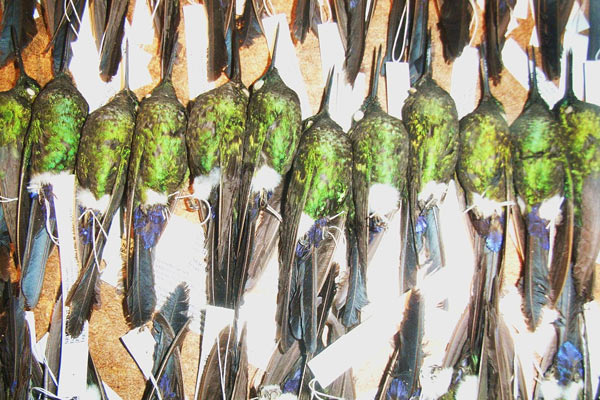 Modern day expeditions face a collection dilemma as scientists consider ethics and endangerment A tray of Eriocnemis (a genus of hummingbird) specimens, Swedish Museum of Natural History – Naturhistoriska Riksmuseet,Stockholm, CC BY-SA 3,0 License, Wikimedia. In 1912, a group of intrepid explorers led by Rollo and Ida Beck, widely acknowledged to be the foremost marine […]
Modern day expeditions face a collection dilemma as scientists consider ethics and endangerment A tray of Eriocnemis (a genus of hummingbird) specimens, Swedish Museum of Natural History – Naturhistoriska Riksmuseet,Stockholm, CC BY-SA 3,0 License, Wikimedia. In 1912, a group of intrepid explorers led by Rollo and Ida Beck, widely acknowledged to be the foremost marine […]
Pollinators puzzle to find flowers amidst natural and human fumes
 While unpleasant car exhaust makes us wrinkle our noses, such human-made fumes may pose serious problems to insects searching for nectar. Researchers recently revealed that background odors make finding flowers difficult for pollinators. The study, published in Science, measured how hawk moths (Manduca sexta) pick out the sacred datura flower scent (Datura wrightii) amidst all […]
While unpleasant car exhaust makes us wrinkle our noses, such human-made fumes may pose serious problems to insects searching for nectar. Researchers recently revealed that background odors make finding flowers difficult for pollinators. The study, published in Science, measured how hawk moths (Manduca sexta) pick out the sacred datura flower scent (Datura wrightii) amidst all […]
Russia and China blamed for blocking Antarctic marine reserve
.600.jpg) An Antarctic krill. Photo by: Uwe Kils/Creative Commons 3.0. Another year, another failed attempt to protect a significant chunk of the Ross Sea, which sits off the coast of Antarctica. According to observers, efforts to create the world’s biggest marine protected area to date were shot down by Russia and China during a meeting in […]
An Antarctic krill. Photo by: Uwe Kils/Creative Commons 3.0. Another year, another failed attempt to protect a significant chunk of the Ross Sea, which sits off the coast of Antarctica. According to observers, efforts to create the world’s biggest marine protected area to date were shot down by Russia and China during a meeting in […]
New species named after the struggle for same-sex marriage
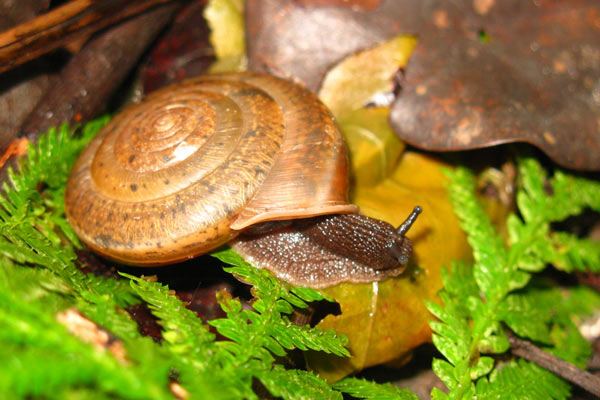 Scientists have named new species after celebrities, fictional characters, and even the corporations that threaten a species’ very existence, but a new snail may be the first to be named after a global human rights movement: the on-going struggle for same-sex marriage. Scientists have named the new Taiwanese land snail, Aegista diversifamilia, meaning diverse human […]
Scientists have named new species after celebrities, fictional characters, and even the corporations that threaten a species’ very existence, but a new snail may be the first to be named after a global human rights movement: the on-going struggle for same-sex marriage. Scientists have named the new Taiwanese land snail, Aegista diversifamilia, meaning diverse human […]
Scientists name new endangered species after the company that will decide its fate
 Aerial view of cement quarry and limestone hill home to a number of species found nowhere else including a new snail. Photo by: Ong Poh Teck/Basteria. Scientists have discovered a new snail species on a limestone hill near a cement quarry in Malaysia, which as far as they know lives nowhere else in the world. […]
Aerial view of cement quarry and limestone hill home to a number of species found nowhere else including a new snail. Photo by: Ong Poh Teck/Basteria. Scientists have discovered a new snail species on a limestone hill near a cement quarry in Malaysia, which as far as they know lives nowhere else in the world. […]
Titanium vs. Millipedes: new species discovered in Madagascar threatened by mining
 Researchers urge increased conservation attention for invertebrates, fragmented habitats A team of scientists from the United States and Germany has recently described seven new species of Malagasy giant pill-millipede. All but one of these species are considered “microendemics,” in that they have only been found in small, isolated forest patches. The study was published in […]
Researchers urge increased conservation attention for invertebrates, fragmented habitats A team of scientists from the United States and Germany has recently described seven new species of Malagasy giant pill-millipede. All but one of these species are considered “microendemics,” in that they have only been found in small, isolated forest patches. The study was published in […]
The world’s best mother: meet the octopus that guards its eggs for over four years
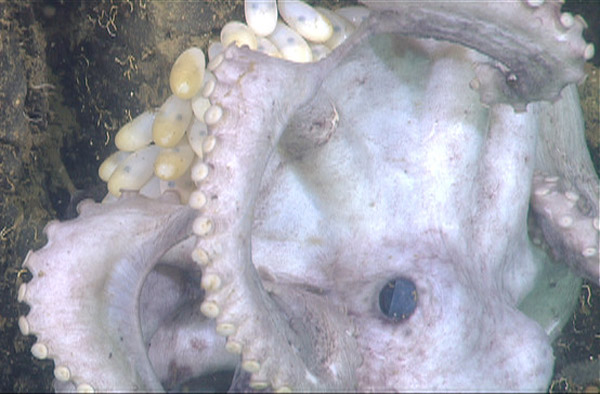 Scientists discover that Graneledone boreopacifica has the longest brooding time of any animal on the planet The ultimate goal of all species on the planet is procreation, the act of making anew. And many species go to great lengths to set their progeny off on the right path: orangutan mothers have been known to breast […]
Scientists discover that Graneledone boreopacifica has the longest brooding time of any animal on the planet The ultimate goal of all species on the planet is procreation, the act of making anew. And many species go to great lengths to set their progeny off on the right path: orangutan mothers have been known to breast […]
It’s not just extinction: meet defaunation
 Unknown orange butterfly in Sumatra. Scientists believe we are in the midst of a defaunation crisis, which is impacting animals, and ecological services, the world over. Photo by: Rhett A. Butler. Get ready to learn a new word: defaunation. Fauna is the total collection of animals—both in terms of species diversity and abundance—in a given […]
Unknown orange butterfly in Sumatra. Scientists believe we are in the midst of a defaunation crisis, which is impacting animals, and ecological services, the world over. Photo by: Rhett A. Butler. Get ready to learn a new word: defaunation. Fauna is the total collection of animals—both in terms of species diversity and abundance—in a given […]
Olinguito, tinkerbell, and a dragon: meet the top 10 new species of 2013
 The Cape Melville leaf-tailed gecko (Saltuarius eximius) is one of the top ten new species from 2013. Photo by: Conrad Hoskin. Out of around 18,000 new species described and named last year, scientists have highlighted ten in an effort to raise awareness about the imperiled biodiversity around us. Each species—from a teddy-bear-like carnivore in the […]
The Cape Melville leaf-tailed gecko (Saltuarius eximius) is one of the top ten new species from 2013. Photo by: Conrad Hoskin. Out of around 18,000 new species described and named last year, scientists have highlighted ten in an effort to raise awareness about the imperiled biodiversity around us. Each species—from a teddy-bear-like carnivore in the […]
Scientists discover giant sperm fossilized in bat feces (PHOTOS)
 In a cave in Australia, researchers from the University of New South Wales discovered giant fossilized sperm. The sperm were produced 17 million years ago by a group of tiny, shelled crustaceans called ostracods, making them the oldest fossilized sperm ever found. The results were published recently in Proceedings of the Royal Society B. The […]
In a cave in Australia, researchers from the University of New South Wales discovered giant fossilized sperm. The sperm were produced 17 million years ago by a group of tiny, shelled crustaceans called ostracods, making them the oldest fossilized sperm ever found. The results were published recently in Proceedings of the Royal Society B. The […]
Underwater horrors: shells of marine life melting off the coast of the U.S.
 It could be the plot of a horror movie: humans wake up one day to discover that chemical changes in the atmosphere are dissolving away parts of their bodies. But for small marine life known as sea butterflies, or pteropods, this is what’s happening off the West Cost of the U.S. Increased carbon in the […]
It could be the plot of a horror movie: humans wake up one day to discover that chemical changes in the atmosphere are dissolving away parts of their bodies. But for small marine life known as sea butterflies, or pteropods, this is what’s happening off the West Cost of the U.S. Increased carbon in the […]
Wonderful Creatures: life is a gamble (inside a caterpillar) for the trigonalid wasp
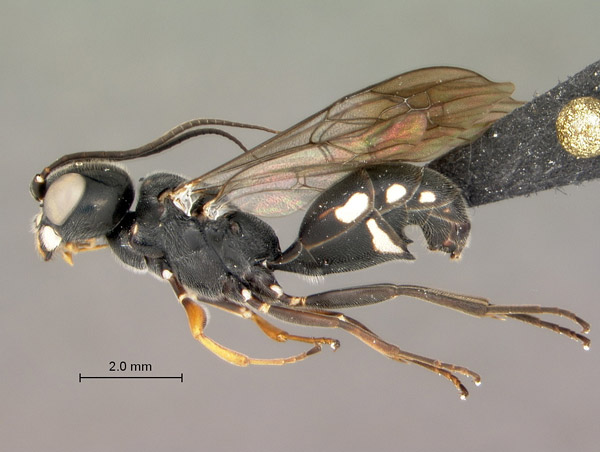 Among the huge diversity of insects there are some bewilderingly complex life cycles, but few can compete with the trigonalid wasps for the seemingly haphazard way they ensure their genes are passed to the next generation. In most cases, a female parasitoid wasp deposits her eggs on or in the host, but this is far […]
Among the huge diversity of insects there are some bewilderingly complex life cycles, but few can compete with the trigonalid wasps for the seemingly haphazard way they ensure their genes are passed to the next generation. In most cases, a female parasitoid wasp deposits her eggs on or in the host, but this is far […]
Scientist discovers a plethora of new praying mantises (pictures)
 A new species of praying mantis named after former Vice President Al Gore—Liturgusa algorei—for his climate activism. Photo courtesy of Svenson et al. Despite their pacific name, praying mantises are ferocious top predators with powerful, grasping forelimbs; spiked legs; and mechanistic jaws. In fact, imagine a tiger that can rotate its head 180 degrees or […]
A new species of praying mantis named after former Vice President Al Gore—Liturgusa algorei—for his climate activism. Photo courtesy of Svenson et al. Despite their pacific name, praying mantises are ferocious top predators with powerful, grasping forelimbs; spiked legs; and mechanistic jaws. In fact, imagine a tiger that can rotate its head 180 degrees or […]
Scientists discover single gene that enables multiple morphs in a butterfly
 Scientists have discovered the gene enabling multiple female morphs that give the Common Mormon butterfly its very tongue-in-cheek name. doublesex, the gene that controls gender in insects, is also a mimicry supergene that determines diverse wing patterns in this butterfly, according to a recent study published in Nature. The study also shows that the supergene […]
Scientists have discovered the gene enabling multiple female morphs that give the Common Mormon butterfly its very tongue-in-cheek name. doublesex, the gene that controls gender in insects, is also a mimicry supergene that determines diverse wing patterns in this butterfly, according to a recent study published in Nature. The study also shows that the supergene […]
Wonderful Creatures: meet the beetle-riding arachnid
 Without wings, smaller terrestrial animals are really restricted when it comes to moving long distances to find new areas of habitat. However, lots of species get around this problem simply by clinging on to other, more mobile animals. The common, yet overlooked pseudoscorpions are among the most accomplished stowaways, one of which (Cordylochernes scorpiodes) has […]
Without wings, smaller terrestrial animals are really restricted when it comes to moving long distances to find new areas of habitat. However, lots of species get around this problem simply by clinging on to other, more mobile animals. The common, yet overlooked pseudoscorpions are among the most accomplished stowaways, one of which (Cordylochernes scorpiodes) has […]
Wonderful Creatures: the tiny, predatory penis-worm that lies in wait in the sand
 The seabed is really where it’s at in terms of animal diversity. Of the 35 known animal lineages, representatives of all but two are found here. In contrast, the huge numbers of species that inhabit tropical rainforests represent a mere 12 lineages. One group of animals that illustrates the diversity of the seabed is the […]
The seabed is really where it’s at in terms of animal diversity. Of the 35 known animal lineages, representatives of all but two are found here. In contrast, the huge numbers of species that inhabit tropical rainforests represent a mere 12 lineages. One group of animals that illustrates the diversity of the seabed is the […]
Two new wasp species found hidden in museum collections
 Scientists have identified two new wasp species, years after the specimens were first collected from the wild. The two new species, Abernessia prima and Abernessia capixaba, belong to the rare pompilid genus Abernessia, and are believed to be endemic to Brazil. They made the discovery while examining spider wasp collections from museums in Brazil and […]
Scientists have identified two new wasp species, years after the specimens were first collected from the wild. The two new species, Abernessia prima and Abernessia capixaba, belong to the rare pompilid genus Abernessia, and are believed to be endemic to Brazil. They made the discovery while examining spider wasp collections from museums in Brazil and […]
Wonderful Creatures: the bizarre-looking marine worm with an incredibly important ecological role
 Almost everyone knows what an earthworm is, but these very familiar animals are just one variation on a very rich theme that is at its most fabulously varied in the oceans. The mind-boggling appearances and lifestyles of the marine segmented worms are perfectly exemplified by this week’s animal. Looking like an intricately folded napkin or […]
Almost everyone knows what an earthworm is, but these very familiar animals are just one variation on a very rich theme that is at its most fabulously varied in the oceans. The mind-boggling appearances and lifestyles of the marine segmented worms are perfectly exemplified by this week’s animal. Looking like an intricately folded napkin or […]
Alpine bumblebees capable of flying over Mt. Everest
 The genus Bombus consists of over 250 species of large, nectar-loving bumblebees. Their bright coloration serves as a warning to predators that they are unwelcome prey and their bodies are covered in a fine coat of hair—known as pile—which gives them their characteristically fuzzy look. Bumblebees display a remarkably capable flight performance despite being encumbered […]
The genus Bombus consists of over 250 species of large, nectar-loving bumblebees. Their bright coloration serves as a warning to predators that they are unwelcome prey and their bodies are covered in a fine coat of hair—known as pile—which gives them their characteristically fuzzy look. Bumblebees display a remarkably capable flight performance despite being encumbered […]
Migrating monarch butterflies hit shockingly low numbers
 The monarch butterfly population overwintering in Mexico this year has hit its lowest numbers ever, according to WWF-Mexico. Monarch butterflies covered just 0.67 hectares in Mexico’s forest, a drop of 44 percent from 2012 already perilously low population. To put this in perspective the average monarch coverage from 1994-2014 was 6.39 or nearly ten times […]
The monarch butterfly population overwintering in Mexico this year has hit its lowest numbers ever, according to WWF-Mexico. Monarch butterflies covered just 0.67 hectares in Mexico’s forest, a drop of 44 percent from 2012 already perilously low population. To put this in perspective the average monarch coverage from 1994-2014 was 6.39 or nearly ten times […]
Wonderful Creatures: meet the animal that has evolved a cushy, worry-free life inside an octopus
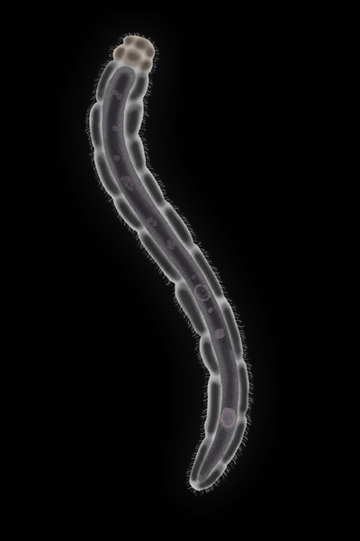 The range of habitats that animals have come to occupy is nothing short of staggering. Take the dicyemids for example. They are among the simplest animals on the planet, with a tiny, worm-like adult body that consists of between 10 and 40 cells. They have no organs, body cavities or even guts—a structural simplicity which […]
The range of habitats that animals have come to occupy is nothing short of staggering. Take the dicyemids for example. They are among the simplest animals on the planet, with a tiny, worm-like adult body that consists of between 10 and 40 cells. They have no organs, body cavities or even guts—a structural simplicity which […]
Amazing discovery in Antarctica: sea anemones found living upside down under ice (photos)
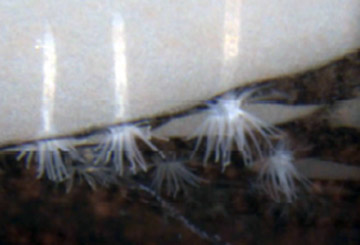 Sea anemones are supposed to sit on the bottom of the ocean, using their basal disc (or adhesive foot) to rest on a coral reef or sand. So, imagine the surprise of geologists in Antarctica when they discovered a mass of sea anemones hanging upside from the underside of the Ross Ice Shelf like a […]
Sea anemones are supposed to sit on the bottom of the ocean, using their basal disc (or adhesive foot) to rest on a coral reef or sand. So, imagine the surprise of geologists in Antarctica when they discovered a mass of sea anemones hanging upside from the underside of the Ross Ice Shelf like a […]
Spectacular new beetle discovered in French Guiana
 The discovery of a new, bi-colored beetle species in the lowland rainforest of French Guiana just added a little pizzazz to the ranks of the Pseudomorphini tribe of beetles. With wing cases (elytra) that sport black spots against a rusty red background, the newcomer was dubbed Guyanemorpha spectabilis, or the spectacular Guyane false-form beetle, by […]
The discovery of a new, bi-colored beetle species in the lowland rainforest of French Guiana just added a little pizzazz to the ranks of the Pseudomorphini tribe of beetles. With wing cases (elytra) that sport black spots against a rusty red background, the newcomer was dubbed Guyanemorpha spectabilis, or the spectacular Guyane false-form beetle, by […]
Wonderful Creatures: A nematode drama played out in a millipede’s gut
 Nematodes are typically small animals that to the naked eye look very much alike; however, these creatures are fantastically diverse —on a par with the arthropods in terms of species diversity. At face value, nematodes lack the charisma of larger animals, so there are very few biologists who have made it their life’s work to […]
Nematodes are typically small animals that to the naked eye look very much alike; however, these creatures are fantastically diverse —on a par with the arthropods in terms of species diversity. At face value, nematodes lack the charisma of larger animals, so there are very few biologists who have made it their life’s work to […]
Wonderful Creatures: the lightning-fast Stenus beetles
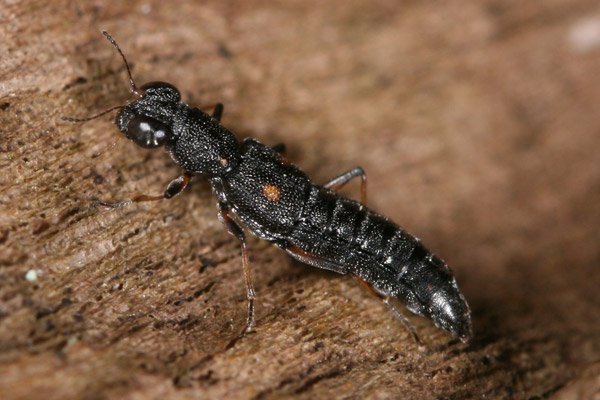 A Stenus beetle. Photo by: Ross Piper. Rove beetles are among the most diverse animals on the planet, with around 56,000 species currently described. Amongst this multitude of species is a dazzling array of adaptations perhaps best illustrated by the genus Stenus. These beetles, with their bulbous eyes and slender bodies are often found near […]
A Stenus beetle. Photo by: Ross Piper. Rove beetles are among the most diverse animals on the planet, with around 56,000 species currently described. Amongst this multitude of species is a dazzling array of adaptations perhaps best illustrated by the genus Stenus. These beetles, with their bulbous eyes and slender bodies are often found near […]
Global warming could upset Antarctic food chain
 Resting near the bottom of the food chain, Antarctic krill (Euphausia superba) underpin much of the Southern Ocean’s ecosystem. But in a rapidly warming world, these hugely-abundant crustaceans could see their habitat shrink considerably. In a recent paper in PLOS ONE, scientists predict that Antarctic krill could lose 20 percent of their growth habitat, or […]
Resting near the bottom of the food chain, Antarctic krill (Euphausia superba) underpin much of the Southern Ocean’s ecosystem. But in a rapidly warming world, these hugely-abundant crustaceans could see their habitat shrink considerably. In a recent paper in PLOS ONE, scientists predict that Antarctic krill could lose 20 percent of their growth habitat, or […]
Giant clams are easy to recognize, but genetics proves there is more than meets the eye
 Giant clams are among the more easily spotted invertebrates of the marine realm. However, some are actually quite cryptic and distinct species are often difficult to identify, claims a study recently published in PlosOne. Much attention has been focused on charismatic species in research, but the scientists who authored the study argue that giant clams […]
Giant clams are among the more easily spotted invertebrates of the marine realm. However, some are actually quite cryptic and distinct species are often difficult to identify, claims a study recently published in PlosOne. Much attention has been focused on charismatic species in research, but the scientists who authored the study argue that giant clams […]
Animal Earth: exploring the hidden biodiversity of our planet
 A sea angel, Clione limacine. In this image the grasping tentacles and chitinous hooks are retracted. Photo by: Alexander Semenov. Most of the species on Earth we never see. In fact, we have no idea what they look like, much less how spectacular they are. In general, people can identify relatively few of their backyard […]
A sea angel, Clione limacine. In this image the grasping tentacles and chitinous hooks are retracted. Photo by: Alexander Semenov. Most of the species on Earth we never see. In fact, we have no idea what they look like, much less how spectacular they are. In general, people can identify relatively few of their backyard […]
Newly discovered beetles construct private homes out of leaf holes and feces
 Scientists have discovered two new species of leaf beetles in southern India that display a novel way of using leaf holes and their fecal pellets to build shelters – a nesting behavior previously not known among leaf beetles. Discovered in the forests of the Western Ghats in the states of Karnataka and Kerala, the scientists […]
Scientists have discovered two new species of leaf beetles in southern India that display a novel way of using leaf holes and their fecal pellets to build shelters – a nesting behavior previously not known among leaf beetles. Discovered in the forests of the Western Ghats in the states of Karnataka and Kerala, the scientists […]
Beetles in the spotlight: a new species of burying beetle from the Solomon Islands Archipelago
 If you thought of the little beetle that you saw the other day as just a ‘regular one’ then this might interest you. Scientists from the University of Alaska discovered Nicrophorus efferens, a new species of burying beetle from Solomon Islands. Studying six adult specimens borrowed from the Bernice Pauahi Bishop Museum of Hawaii (BPBM), […]
If you thought of the little beetle that you saw the other day as just a ‘regular one’ then this might interest you. Scientists from the University of Alaska discovered Nicrophorus efferens, a new species of burying beetle from Solomon Islands. Studying six adult specimens borrowed from the Bernice Pauahi Bishop Museum of Hawaii (BPBM), […]
New species of beetle discovered in megacity
 When imagining the discovery of a new species, most people conjure thoughts of intrepid explorers, battling the odds in remote rainforests. But this needn’t be the case, at least according to a new study published in Zookeys. The study reports the discovery of a new species of water beetle in the heart of the 10th […]
When imagining the discovery of a new species, most people conjure thoughts of intrepid explorers, battling the odds in remote rainforests. But this needn’t be the case, at least according to a new study published in Zookeys. The study reports the discovery of a new species of water beetle in the heart of the 10th […]
Small invertebrates could be key to uncovering the mysteries of killer amphibian fungus
 In 2004, the first-ever Global Amphibian Assessment (GAA) reviewed all 5,743 amphibian species known to science and concluded that 32% were threatened with extinction – a number far exceeding corresponding figures for birds and mammals (12 to 23% respectively). In addition to the usual culprits of climate change and habitat destruction, a startling 92.5% of […]
In 2004, the first-ever Global Amphibian Assessment (GAA) reviewed all 5,743 amphibian species known to science and concluded that 32% were threatened with extinction – a number far exceeding corresponding figures for birds and mammals (12 to 23% respectively). In addition to the usual culprits of climate change and habitat destruction, a startling 92.5% of […]
Featured video: 22-year-old produces documentary on the Peruvian Amazon
Spending a year on the Tambopata River in Peru’s deep Amazon, allowed 22-year-old Tristan Thompson, to record stunning video of the much the region’s little seen, and little known, wildlife. Thompson, a student at the University of the West of England, has turned his footage into a new documentary An Untamed Wilderness that not only […]
Scientists discover cocoa frog and 60 other new species in remote Suriname (photos)
 In one of the most untouched and remote rainforests in the world, scientists have discovered some sixty new species, including a chocolate-colored frog and a super-mini dung beetle. The species were uncovered in Southeastern Suriname during a Rapid Assessment Program (RAP); run by Conservation International (CI), RAPS involve sending teams of specialists into little-known ecosystems […]
In one of the most untouched and remote rainforests in the world, scientists have discovered some sixty new species, including a chocolate-colored frog and a super-mini dung beetle. The species were uncovered in Southeastern Suriname during a Rapid Assessment Program (RAP); run by Conservation International (CI), RAPS involve sending teams of specialists into little-known ecosystems […]
Governments should respond to ocean acidification ‘as urgently as they do to national security threats’
 The oceans are more acidic now than they have been for at least 300m years, due to carbon dioxide emissions from burning fossil fuels, and a mass extinction of key species may already be almost inevitable as a result, leading marine scientists warned on Thursday. An international audit of the health of the oceans has […]
The oceans are more acidic now than they have been for at least 300m years, due to carbon dioxide emissions from burning fossil fuels, and a mass extinction of key species may already be almost inevitable as a result, leading marine scientists warned on Thursday. An international audit of the health of the oceans has […]
New tiny insect named after Peter Pan fairy discovered in Central America
 A new genus of fairyfly has been discovered in Costa Rica. The new species aptly named Tinkerbella nana after the fairy in J.M. Barrie’s play ‘Peter Pan’ is one of the smallest winged insects in the neotropics. Found in both temperate and tropical climates, the fairyfly is not actually a fly as its name suggests, […]
A new genus of fairyfly has been discovered in Costa Rica. The new species aptly named Tinkerbella nana after the fairy in J.M. Barrie’s play ‘Peter Pan’ is one of the smallest winged insects in the neotropics. Found in both temperate and tropical climates, the fairyfly is not actually a fly as its name suggests, […]
Zoo races to save extreme butterfly from extinction
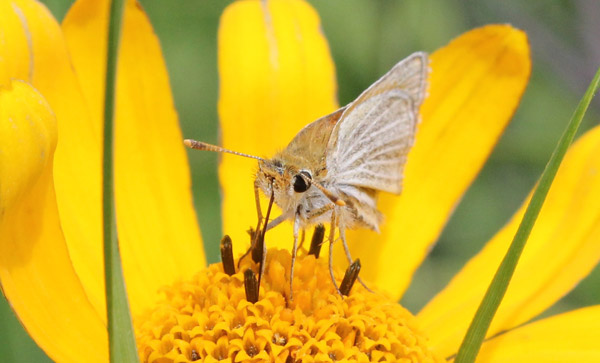 In a large room that used to house aquatic mammals at the Minnesota Zoo, Erik Runquist holds up a vial and says, “Here are its eggs.” I peer inside and see small specks, pale with a dot of brown at the top; they look like a single grain of cous cous or quinoa. Runquist explains […]
In a large room that used to house aquatic mammals at the Minnesota Zoo, Erik Runquist holds up a vial and says, “Here are its eggs.” I peer inside and see small specks, pale with a dot of brown at the top; they look like a single grain of cous cous or quinoa. Runquist explains […]
Hope rises as new malaria vaccine shows promise
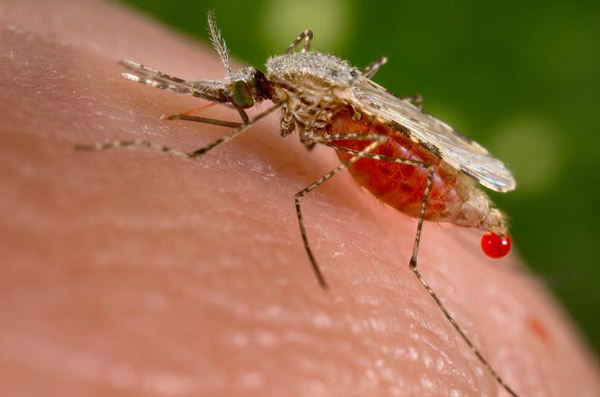 Last week U.S. scientists with the biotech company, Sanaria, announced a possible breakthrough on an experimental malaria vaccine: an early trial led to a success rate of 80 percent for the two highest doses. Malaria remains one of the world’s worst scourges. In 2010, the World Health Organization reported 219 million documented cases of malaria […]
Last week U.S. scientists with the biotech company, Sanaria, announced a possible breakthrough on an experimental malaria vaccine: an early trial led to a success rate of 80 percent for the two highest doses. Malaria remains one of the world’s worst scourges. In 2010, the World Health Organization reported 219 million documented cases of malaria […]
Florida declares two butterfly species extinct as pollinator crisis worsens
 Conservationist’s faced a crushing blow last month as two butterfly species native to Florida were declared extinct. “Occasionally, these types of butterflies disappear for long periods of time but are rediscovered in another location,” said Larry Williams, U.S. Fish and Wildlife state supervisor for ecological services. We think it’s apparent now these two species are […]
Conservationist’s faced a crushing blow last month as two butterfly species native to Florida were declared extinct. “Occasionally, these types of butterflies disappear for long periods of time but are rediscovered in another location,” said Larry Williams, U.S. Fish and Wildlife state supervisor for ecological services. We think it’s apparent now these two species are […]
Habitat loss and pesticides causing decline in Europe’s butterflies
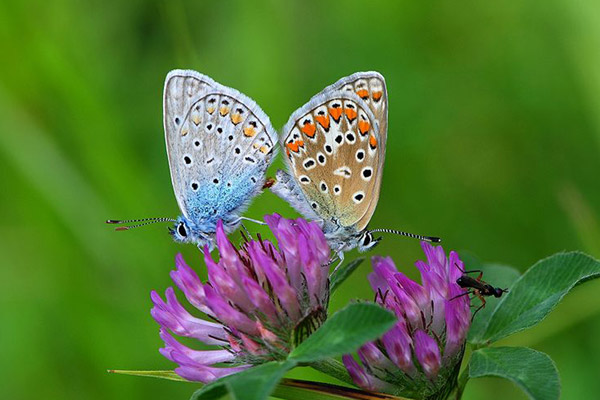 Europe’s grassland butterfly population has plummeted in the past two decades, new research published on Tuesday shows, with a near halving in the numbers of key species since 1990. The precipitous decline has been blamed on poor agricultural practices and pesticides, by the European Environment Agency, which carried out the research. Falling numbers of butterflies […]
Europe’s grassland butterfly population has plummeted in the past two decades, new research published on Tuesday shows, with a near halving in the numbers of key species since 1990. The precipitous decline has been blamed on poor agricultural practices and pesticides, by the European Environment Agency, which carried out the research. Falling numbers of butterflies […]
Rare animal species and Buddhist monks in danger of losing their home to cement quarry
 An international cement company Lafarge, winner of a Green Initiative award, is considering quarrying a cave in Malaysia which is the sole home of a critically endangered species. The proposed operations also threaten a Buddhist monastery near the cave where monks are facing eviction. Kanthan cave in Peninsular Malaysia is located in a limestone hill, […]
An international cement company Lafarge, winner of a Green Initiative award, is considering quarrying a cave in Malaysia which is the sole home of a critically endangered species. The proposed operations also threaten a Buddhist monastery near the cave where monks are facing eviction. Kanthan cave in Peninsular Malaysia is located in a limestone hill, […]
Stunning moth species discovered in the mountains of China
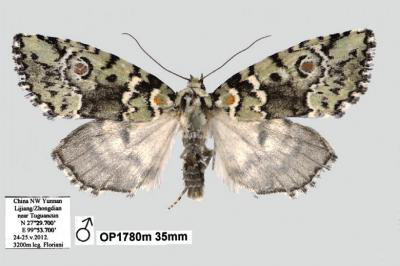 A new species of moth (Stenoloba solaris) was discovered in the Yunnan province of China, a new addition to the nascent genus of moth, Stenoloba. The discovery was published in the open access journal ZooKeys. The moth is colloquially known as the “sun moth” because of the intricate pattern that covers its upper wings and […]
A new species of moth (Stenoloba solaris) was discovered in the Yunnan province of China, a new addition to the nascent genus of moth, Stenoloba. The discovery was published in the open access journal ZooKeys. The moth is colloquially known as the “sun moth” because of the intricate pattern that covers its upper wings and […]
Losing our monarchs: iconic monarch butterfly down to lowest numbers in 20 years
 In the next few months, the beating of fragile fiery orange and black wings will transport the monarch butterfly south. But the number of monarch butterflies (Danaus plexippus) reaching their final destination has steadily declined, dropping to its lowest level in two decades last winter, according to a recent survey. The insect’s journey begins in […]
In the next few months, the beating of fragile fiery orange and black wings will transport the monarch butterfly south. But the number of monarch butterflies (Danaus plexippus) reaching their final destination has steadily declined, dropping to its lowest level in two decades last winter, according to a recent survey. The insect’s journey begins in […]
New long-horned beetle discovered in China
 Recent expeditions by the Chinese Academy of Science’s Institute of Zoology to the Yunnan Province of China have uncovered the existence of a new species of long-horned beetle. This newly discovered beetle has a beautifully colored blue-green body with short, slender, and distinctively blue legs according to a new article in Zookeys. There are over […]
Recent expeditions by the Chinese Academy of Science’s Institute of Zoology to the Yunnan Province of China have uncovered the existence of a new species of long-horned beetle. This newly discovered beetle has a beautifully colored blue-green body with short, slender, and distinctively blue legs according to a new article in Zookeys. There are over […]
Newly discovered pirate ant uses sickle-shaped mandibles to decimate rivals
 A new species of ant has recently been discovered in the Hortarium of the Los Baños University in the Philippines. Scientists named it the pirate ant (Cardiocondyla pirata) due to the female’s unique pigmentation pattern: a distinctive stripe across the eyes that resembles a pirates’ eye-patch. The pirate ant belongs to a genus Cardiocondyla that […]
A new species of ant has recently been discovered in the Hortarium of the Los Baños University in the Philippines. Scientists named it the pirate ant (Cardiocondyla pirata) due to the female’s unique pigmentation pattern: a distinctive stripe across the eyes that resembles a pirates’ eye-patch. The pirate ant belongs to a genus Cardiocondyla that […]
Pesticides decimating dragonflies and other aquatic insects
 While recent research (and media attention) has focused on the alleged negative impacts of pesticides on bees, the problem may be far broader according to a new study in the Proceedings of the US Academy of Sciences (PNAS). Looking at over 50 streams in Germany, France, and Australia, scientists in Europe and Australia found that […]
While recent research (and media attention) has focused on the alleged negative impacts of pesticides on bees, the problem may be far broader according to a new study in the Proceedings of the US Academy of Sciences (PNAS). Looking at over 50 streams in Germany, France, and Australia, scientists in Europe and Australia found that […]
EU labels another pesticide as bad for bees
 A widely used insect nerve agent has been labelled a “high acute risk” to honeybees by the European Food Safety Authority (EFSA). A similar assessment by the EFSA on three other insecticides preceded the suspension of their use in the European Union. “The insecticide fipronil poses a high acute risk to honeybees when used as […]
A widely used insect nerve agent has been labelled a “high acute risk” to honeybees by the European Food Safety Authority (EFSA). A similar assessment by the EFSA on three other insecticides preceded the suspension of their use in the European Union. “The insecticide fipronil poses a high acute risk to honeybees when used as […]
Ocean acidification pushing young oysters into ‘death race’
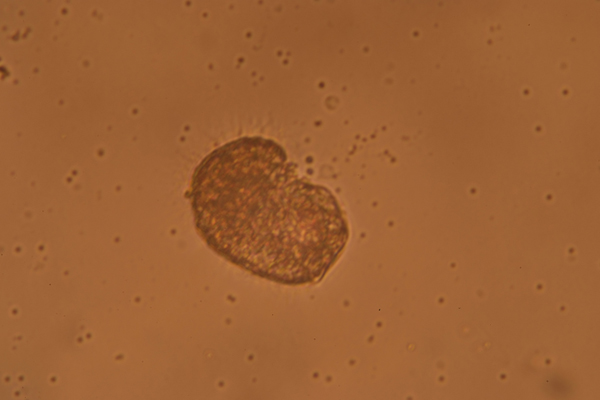 Scientists have long known that ocean acidification is leading to a decline in Pacific oyster (Crassostrea gigas) in the U.S.’s Pacific Northwest region, but a new study in the American Geophysical Union shows exactly how the change is undercutting populations of these economically-important molluscs. Caused by carbon dioxide emissions, ocean acidification changes the very chemistry […]
Scientists have long known that ocean acidification is leading to a decline in Pacific oyster (Crassostrea gigas) in the U.S.’s Pacific Northwest region, but a new study in the American Geophysical Union shows exactly how the change is undercutting populations of these economically-important molluscs. Caused by carbon dioxide emissions, ocean acidification changes the very chemistry […]
Poisonous jellyfish on the rise in the Mediterranean
.600.jpg) Scientists across the Mediterranean say a surge in the number of jellyfish this year threatens not just the biodiversity of one of the world’s most overfished seas but also the health of tens of thousands of summer tourists. “I flew along a 300km stretch of coastline on 21 April and saw millions of jellyfish,” said […]
Scientists across the Mediterranean say a surge in the number of jellyfish this year threatens not just the biodiversity of one of the world’s most overfished seas but also the health of tens of thousands of summer tourists. “I flew along a 300km stretch of coastline on 21 April and saw millions of jellyfish,” said […]
Giant hot pink slug in Australia becomes conservation symbol (photo)
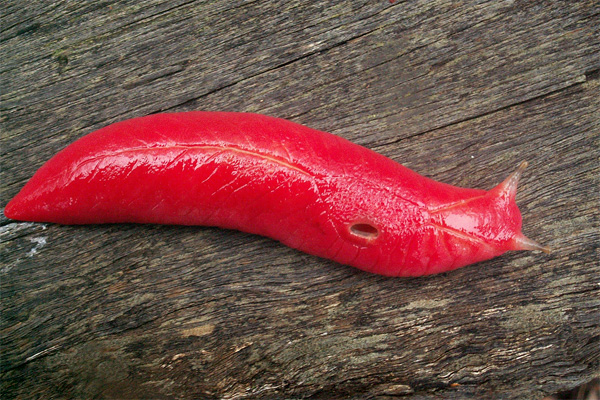 Hot pink slugs that emerge after rainy nights have become a conservation symbol for alpine forests on Australia’s Mount Kaputar, reports The Sydney Morning Herald. The slugs, which measure up to 20 centimeters (8 inches), are only found on Mount Kaputar, a volcano that last erupted 17 million years ago. They spend most of their […]
Hot pink slugs that emerge after rainy nights have become a conservation symbol for alpine forests on Australia’s Mount Kaputar, reports The Sydney Morning Herald. The slugs, which measure up to 20 centimeters (8 inches), are only found on Mount Kaputar, a volcano that last erupted 17 million years ago. They spend most of their […]
Scientists describe over 100 new beetles from New Guinea
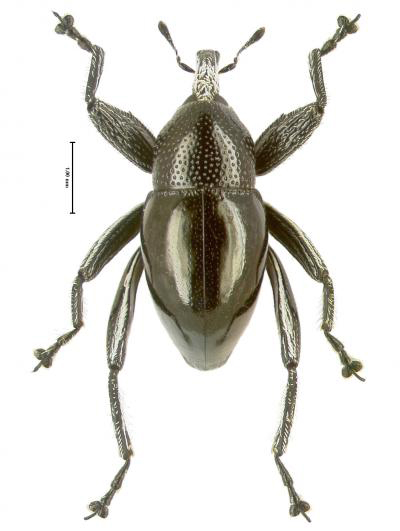 In a single paper, a team of researchers have succinctly described 101 new species of weevils from New Guinea, more than doubling the known species in the beetle genus, Trigonopterus. Since describing new species is hugely laborious and time-intensive, the researchers turned to a new method of species description known as ‘turbo-taxonomy,’ which employs a […]
In a single paper, a team of researchers have succinctly described 101 new species of weevils from New Guinea, more than doubling the known species in the beetle genus, Trigonopterus. Since describing new species is hugely laborious and time-intensive, the researchers turned to a new method of species description known as ‘turbo-taxonomy,’ which employs a […]
Saving Gorongosa: E.O. Wilson on protecting a biodiversity hotspot in Mozambique
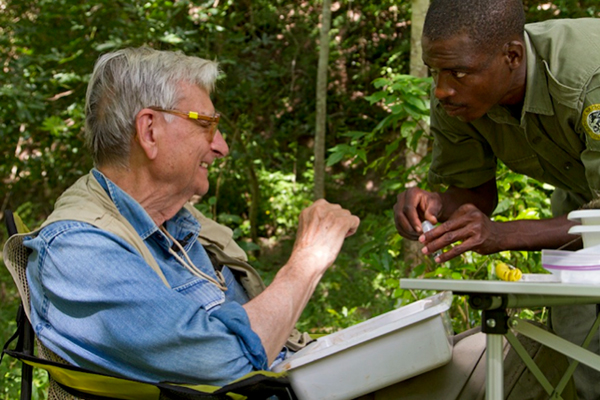 If you fly over the Great African Rift Valley from its northernmost point in Ethiopia, over the great national parks of Kenya and Tanzania, and follow it south to the very end, you will arrive at Gorongosa National Park in central Mozambique. Plateaus on the eastern and western sides of the park flank the lush […]
If you fly over the Great African Rift Valley from its northernmost point in Ethiopia, over the great national parks of Kenya and Tanzania, and follow it south to the very end, you will arrive at Gorongosa National Park in central Mozambique. Plateaus on the eastern and western sides of the park flank the lush […]
Two new arachnids discovered in Brazilian caves (photos)
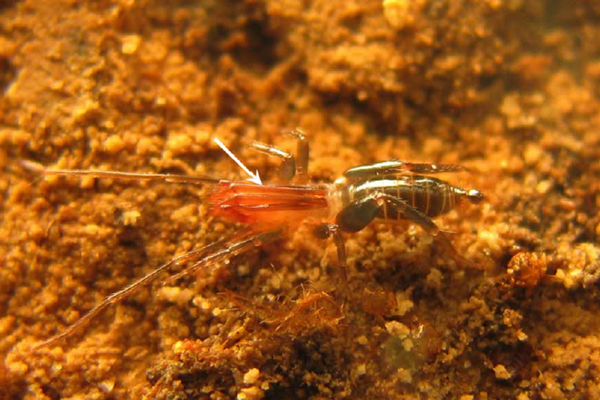 Scientists have discovered two new species of short-tailed whipscorpions (in the order Schizomida) in limestone caves in Brazil, according to a new paper published in PLoS ONE. The new species—dubbed Rowlandius ubajara and Rowlandius potiguara—add new knowledge to a group of arachnids that is little known in South America outside of the Amazon. “Schizomids occur […]
Scientists have discovered two new species of short-tailed whipscorpions (in the order Schizomida) in limestone caves in Brazil, according to a new paper published in PLoS ONE. The new species—dubbed Rowlandius ubajara and Rowlandius potiguara—add new knowledge to a group of arachnids that is little known in South America outside of the Amazon. “Schizomids occur […]
Scientists discover two mini-spiders in China (photos)
 Scientists have uncovered two miniature spiders living on mountains in China’s southern region, one of which is among the smallest spiders recorded worldwide, according to a new paper in ZooKeys. Both spiders belong to the Mysmenidae family, which is made up of mini-spiders with eight eyes. “Although the family Mysmenidae is distributed worldwide, it is […]
Scientists have uncovered two miniature spiders living on mountains in China’s southern region, one of which is among the smallest spiders recorded worldwide, according to a new paper in ZooKeys. Both spiders belong to the Mysmenidae family, which is made up of mini-spiders with eight eyes. “Although the family Mysmenidae is distributed worldwide, it is […]
Three new species of carnivorous snails discovered in endangered habitat in Thailand (photos)
 Scientists from Chulalongkorn University, Bangkok and the Natural History Museum, London recently discovered three new species of carnivorous snails in northern Thailand. However, the celebration of these discoveries is tainted by the fact that the new snails are already threatened with extinction due to the destruction of their limestone habitat. The new snail species named […]
Scientists from Chulalongkorn University, Bangkok and the Natural History Museum, London recently discovered three new species of carnivorous snails in northern Thailand. However, the celebration of these discoveries is tainted by the fact that the new snails are already threatened with extinction due to the destruction of their limestone habitat. The new snail species named […]
New prehistoric animal named after Johnny Depp due to its ‘scissorhands’
 Half a billion years after an arthropod with long triple claws roamed the shallow Cambrian seas, scientists have named it after Hollywood movie actor, Johnny Depp: Kooteninchela deppi. Depp, known for his versatility as an actor, played Edward Scissorhands—an artificial man with long scissors for hands—in a popular 1990 film. “When I first saw the […]
Half a billion years after an arthropod with long triple claws roamed the shallow Cambrian seas, scientists have named it after Hollywood movie actor, Johnny Depp: Kooteninchela deppi. Depp, known for his versatility as an actor, played Edward Scissorhands—an artificial man with long scissors for hands—in a popular 1990 film. “When I first saw the […]
Eat insects to mitigate deforestation and climate change
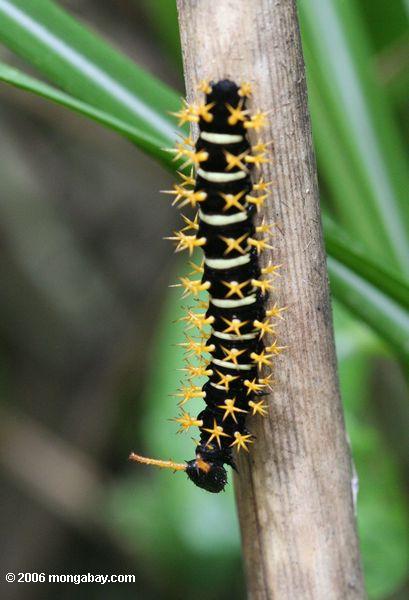 A new 200-page-report by the UN Food and Agriculture Organization (FAO) urges human society to utilize an often-ignored, protein-rich, and ubiquitous food source: insects. While many in the industrialized west might turn up their noses at the idea of eating insects, already around 2 billion people worldwide eat over 1,900 species of insect, according to […]
A new 200-page-report by the UN Food and Agriculture Organization (FAO) urges human society to utilize an often-ignored, protein-rich, and ubiquitous food source: insects. While many in the industrialized west might turn up their noses at the idea of eating insects, already around 2 billion people worldwide eat over 1,900 species of insect, according to […]
Common moth can hear higher frequencies than any other animal on Earth
 A common little moth turns out to have the best ears in the animal kingdom. According to a new study in Biology Letters, the greater wax moth (Galleria mellonella) is capable of hearing frequencies up to 300,000 hertz (300kHz), which is 15 times the frequency humans can hear at their prime, around 20 kHz. “We […]
A common little moth turns out to have the best ears in the animal kingdom. According to a new study in Biology Letters, the greater wax moth (Galleria mellonella) is capable of hearing frequencies up to 300,000 hertz (300kHz), which is 15 times the frequency humans can hear at their prime, around 20 kHz. “We […]
U.S. loses nearly a third of its honey bees this season
 Nearly a third of managed honeybee colonies in America died out or disappeared over the winter, an annual survey found on Wednesday. The decline—which was far worse than the winter before—threatens the survival of some bee colonies. The heavy losses of pollinators also threatens the country’s food supply, researchers said. The US Department of Agriculture […]
Nearly a third of managed honeybee colonies in America died out or disappeared over the winter, an annual survey found on Wednesday. The decline—which was far worse than the winter before—threatens the survival of some bee colonies. The heavy losses of pollinators also threatens the country’s food supply, researchers said. The US Department of Agriculture […]
Looking beyond the hundred legs: finding new centipedes in India requires many tools
 A small, boneless creature, that lives underground, with a “hundred” legs, and a rather powerful sting; some of these creatures are drab, but some are so beautiful and brightly colored that they can startle. Centipedes. There is more to a centipede than its many legs, and its habit of darting out of dark places. One […]
A small, boneless creature, that lives underground, with a “hundred” legs, and a rather powerful sting; some of these creatures are drab, but some are so beautiful and brightly colored that they can startle. Centipedes. There is more to a centipede than its many legs, and its habit of darting out of dark places. One […]
New giant tarantula that’s taken media by storm likely Critically Endangered (photos)
 Described by a number of media outlets as “the size of your face” a new tree-dwelling tarantula discovered in Sri Lanka has awed arachnophiliacs and terrified arachnophobes alike. But the new species, named Raja’s tiger spider (Poecilotheria rajaei), is likely Critically Endangered according to the scientist that discovered it in northern Sri Lanka. “I would […]
Described by a number of media outlets as “the size of your face” a new tree-dwelling tarantula discovered in Sri Lanka has awed arachnophiliacs and terrified arachnophobes alike. But the new species, named Raja’s tiger spider (Poecilotheria rajaei), is likely Critically Endangered according to the scientist that discovered it in northern Sri Lanka. “I would […]
Scientists discover new wasp species in a field box from the 1930s (photos)
 Searching through materials at the Natural History Museum in Paris, Simon van Noort recently came across a long-neglected field box of wasp specimens. Collected 80 years earlier by André Seyrig in Madagascar, the box contained several specimens of wasp in the Paramblynotus genus. The big surprise: wasps in this genus had never before been seen […]
Searching through materials at the Natural History Museum in Paris, Simon van Noort recently came across a long-neglected field box of wasp specimens. Collected 80 years earlier by André Seyrig in Madagascar, the box contained several specimens of wasp in the Paramblynotus genus. The big surprise: wasps in this genus had never before been seen […]
Domesticated bees do not replace declining wild insects as agricultural pollinators
 Sprinkled with pollen, buzzing bees fly from one blossom to another, collecting sweet nectar from brilliantly colored flowers. Bees tend to symbolize the pollination process, but there are many wild insects that carry out the same function. Unfortunately, wild insect populations are in decline, and, according to a recent study, adding more honey bees may […]
Sprinkled with pollen, buzzing bees fly from one blossom to another, collecting sweet nectar from brilliantly colored flowers. Bees tend to symbolize the pollination process, but there are many wild insects that carry out the same function. Unfortunately, wild insect populations are in decline, and, according to a recent study, adding more honey bees may […]
Scientists discover new genus of crustacean
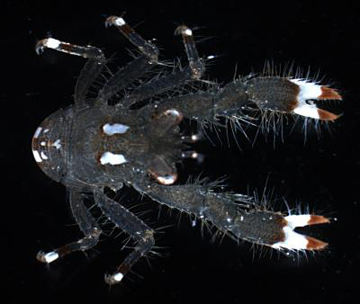 In recent journeys to Madagascar, New Caledonia, Vanuatu, the Philippines, and French Polynesia, scientists from the Centre for Advanced Studies of Blanes and the University of Barcelona have discovered not only five new crustaceous species, but also the existence of a new genus in the family. Through use of molecular data and the form and […]
In recent journeys to Madagascar, New Caledonia, Vanuatu, the Philippines, and French Polynesia, scientists from the Centre for Advanced Studies of Blanes and the University of Barcelona have discovered not only five new crustaceous species, but also the existence of a new genus in the family. Through use of molecular data and the form and […]
Common pesticides disrupt brain functioning in bees
 Honey bee (Apis mellifera) collecting pollen. Photo by: Jon Sullivan. Exposure to commonly used pesticides directly disrupts brain functioning in bees, according to new research in Nature. While the study is the first to record that popular pesticides directly injure bee brain physiology, it adds to a slew of recent studies showing that pesticides, especially […]
Honey bee (Apis mellifera) collecting pollen. Photo by: Jon Sullivan. Exposure to commonly used pesticides directly disrupts brain functioning in bees, according to new research in Nature. While the study is the first to record that popular pesticides directly injure bee brain physiology, it adds to a slew of recent studies showing that pesticides, especially […]
Ant communities more segregated in palm oil plantations than rainforest
 Oil palm estate in Malaysia. Photo by: Rhett A. Butler. Ants are an important ecological group in both degraded and natural habitats. They interact with many other species and mediate a range of ecological processes. These interactions are often interpreted in the context of ant mosaics, where dominant species form strict territories, keeping other ants […]
Oil palm estate in Malaysia. Photo by: Rhett A. Butler. Ants are an important ecological group in both degraded and natural habitats. They interact with many other species and mediate a range of ecological processes. These interactions are often interpreted in the context of ant mosaics, where dominant species form strict territories, keeping other ants […]
Giant squid caught on video
 Scientists come face-to-face with giant squid. Photo of a giant squid captured in 2004. Photo by: Dr Tsunemi Kubodera, of the National Science Museum in Tokyo, and Kyoichi Mori, of the Ogaswara Whale Watching Association. Last summer, after 55 dives, three scientists in a submarine off the coast of Japan encountered an animal people have […]
Scientists come face-to-face with giant squid. Photo of a giant squid captured in 2004. Photo by: Dr Tsunemi Kubodera, of the National Science Museum in Tokyo, and Kyoichi Mori, of the Ogaswara Whale Watching Association. Last summer, after 55 dives, three scientists in a submarine off the coast of Japan encountered an animal people have […]
Animals dissolving due to carbon emissions
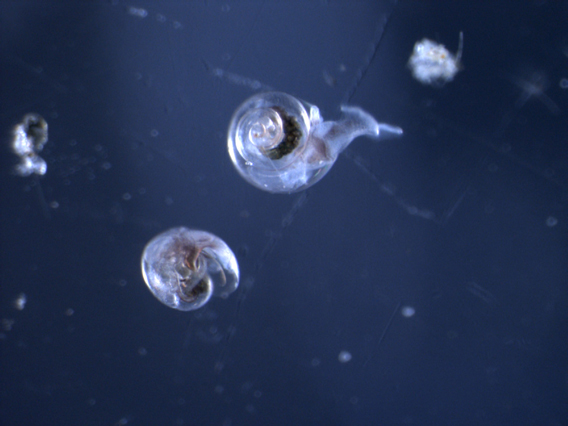 Marine snails, known as Limacina helicina antarctica, are seeing their shells dissolve due to carbon emissions. Photo by: Nina Bednarsek. Marine snails, also known as sea butterflies, are dissolving in the Southern Seas due to anthropogenic carbon emissions, according to a new study in Nature GeoScience. Scientists have discovered that the snail’s shells are being […]
Marine snails, known as Limacina helicina antarctica, are seeing their shells dissolve due to carbon emissions. Photo by: Nina Bednarsek. Marine snails, also known as sea butterflies, are dissolving in the Southern Seas due to anthropogenic carbon emissions, according to a new study in Nature GeoScience. Scientists have discovered that the snail’s shells are being […]
New study adds to evidence that common pesticides decimating bee colonies
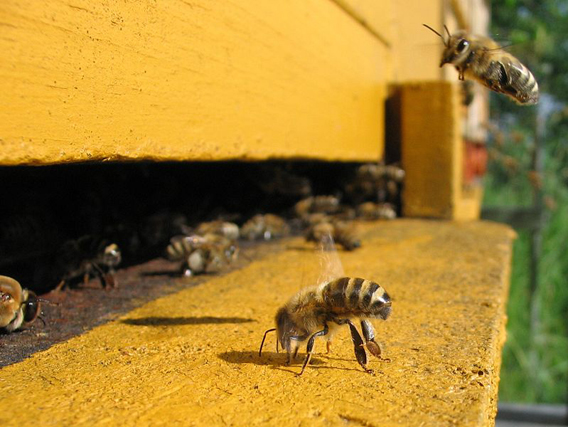 Honeybees in an apiary in Germany. Photo by: Björn Appel. The evidence that common pesticides may be partly to blame for a decline in bees keeps piling up. Several recent studies have shown that pesticides known as “neonicotinoid” may cause various long-term impacts on bee colonies, including fewer queens, foraging bees losing their way, and […]
Honeybees in an apiary in Germany. Photo by: Björn Appel. The evidence that common pesticides may be partly to blame for a decline in bees keeps piling up. Several recent studies have shown that pesticides known as “neonicotinoid” may cause various long-term impacts on bee colonies, including fewer queens, foraging bees losing their way, and […]
Brainless slime mold uses slimy memory to navigate
 The yellow slime mold Physarum polycephalum exploring a petri dish. Slime deposits to the left of the image tell the slime mold where it has previously explored. Photo by: Audrey Dussutour. How do you navigate space efficiently without a brain? Slime, according to a surprising new study in the Proceedings of the National Academy of […]
The yellow slime mold Physarum polycephalum exploring a petri dish. Slime deposits to the left of the image tell the slime mold where it has previously explored. Photo by: Audrey Dussutour. How do you navigate space efficiently without a brain? Slime, according to a surprising new study in the Proceedings of the National Academy of […]
Arachnopocalypse: with birds away, the spiders play in Guam
 The accidental introduction of the brown tree snake on Guam has resulted in a loss of birds and a subsequent explosion of spiders. Photo by: Isaac Chellman. The island of Guam is drowning in spiders. New research in the open-access journal PLOS ONE has found that in the wet season, Guam’s arachnid population booms to […]
The accidental introduction of the brown tree snake on Guam has resulted in a loss of birds and a subsequent explosion of spiders. Photo by: Isaac Chellman. The island of Guam is drowning in spiders. New research in the open-access journal PLOS ONE has found that in the wet season, Guam’s arachnid population booms to […]
Sacrificial squid has unique way of deterring predators
 Squid drops arms when tapped by a bottle brush. Photo by: Stephanie Bush, MBARI. Octopoteuthis deletron—this deep-dwelling, unassuming little squid may appear plain and boring, but when threatened, it has a peculiar way of defending itself. This foot-long invertebrate behaves a bit differently than most of its close cousins: it drops its arms. Most cephalopods, […]
Squid drops arms when tapped by a bottle brush. Photo by: Stephanie Bush, MBARI. Octopoteuthis deletron—this deep-dwelling, unassuming little squid may appear plain and boring, but when threatened, it has a peculiar way of defending itself. This foot-long invertebrate behaves a bit differently than most of its close cousins: it drops its arms. Most cephalopods, […]
Biodiversity faltering: 20% of invertebrates threatened with extinction
 Schoenherr’s blue weevil (Eupholus schoenherri) a spectacular blue and turquoise beetle from Indonesian New Guinea. Photo by Rhett A. Butler. Twenty percent of invertebrates are at risk of extinction, according to a new report that looks at the 12,621 invertebrates assessed by the IUCN Red List to date. Although invertebrates never garner the same conservation […]
Schoenherr’s blue weevil (Eupholus schoenherri) a spectacular blue and turquoise beetle from Indonesian New Guinea. Photo by Rhett A. Butler. Twenty percent of invertebrates are at risk of extinction, according to a new report that looks at the 12,621 invertebrates assessed by the IUCN Red List to date. Although invertebrates never garner the same conservation […]
Unidentified poodle moth takes Internet by storm
 The now famous poodle moth, species unknown. Photo by: Arthur Anker. A white moth from Venezuela that bears a striking resemblance to a poodle has become an Internet sensation, after cryptozoologist Karl Shuker posted about the bizarre-looking species on his blog. Photographed in 2009 in Venezulea’s Canaima National Park in the Gran Sabana region by […]
The now famous poodle moth, species unknown. Photo by: Arthur Anker. A white moth from Venezuela that bears a striking resemblance to a poodle has become an Internet sensation, after cryptozoologist Karl Shuker posted about the bizarre-looking species on his blog. Photographed in 2009 in Venezulea’s Canaima National Park in the Gran Sabana region by […]
‘Monster larva’ turns into a shrimp
 The larva known as Cerataspis monstrosa. Photo courtesy of Bracken-Grissom et al. With blue devil-shaped horns and red armor, the monster larva, or Cerataspis monstrosa, kept scientists guessing for nearly 200 years; infrequently found in the bellies of marine predators, researchers could not imagine what this larva became as an adult. Now they do: the […]
The larva known as Cerataspis monstrosa. Photo courtesy of Bracken-Grissom et al. With blue devil-shaped horns and red armor, the monster larva, or Cerataspis monstrosa, kept scientists guessing for nearly 200 years; infrequently found in the bellies of marine predators, researchers could not imagine what this larva became as an adult. Now they do: the […]
One extinction leads to another…and another
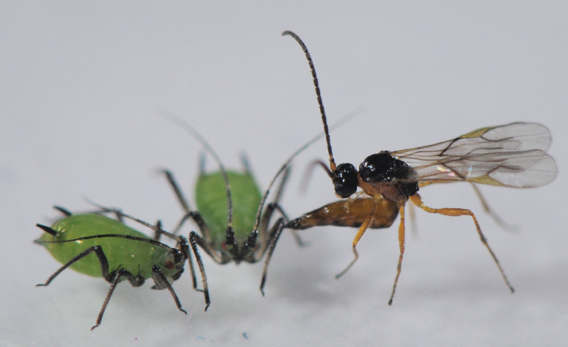 A parasitic wasp attacks an aphid in the first study to prove the theory that the extinction of one predator can lead to the extinction of another. Photo by: Dirk Sanders. A new study in Biology Letters demonstrates that altering the relationship between a predator and its prey can cause wide-ranging ripple effects through an […]
A parasitic wasp attacks an aphid in the first study to prove the theory that the extinction of one predator can lead to the extinction of another. Photo by: Dirk Sanders. A new study in Biology Letters demonstrates that altering the relationship between a predator and its prey can cause wide-ranging ripple effects through an […]
Illegal lobster fishermen slammed with over $50 million penalty
 Spiny lobster. Photo by: Rhett A. Butler. Three men who illegally harvested lobster from South African waters and smuggled them to the U.S. for 14 years have been ordered to pay $54.9 million in restitution to the South African government by a District Court in Manhattan. According to the Pew Environment Group this is the […]
Spiny lobster. Photo by: Rhett A. Butler. Three men who illegally harvested lobster from South African waters and smuggled them to the U.S. for 14 years have been ordered to pay $54.9 million in restitution to the South African government by a District Court in Manhattan. According to the Pew Environment Group this is the […]
Velociraptor spider discovered in Oregon cave (pictures)
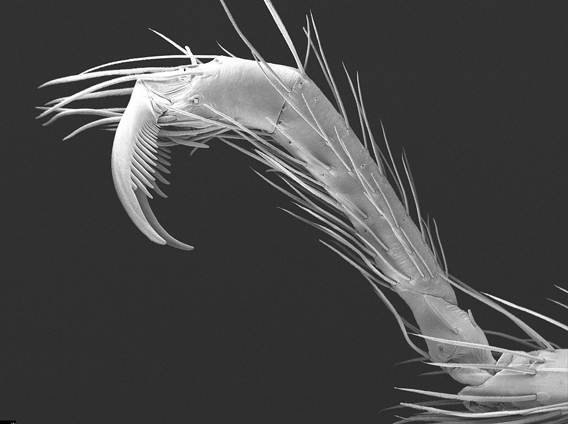 Close-up of the remarkable, raptor-like claws of Trogloraptor. Photo by: Griswold CE, Audisio T, Ledford JM. Scouring the caves of Southwest Oregon, scientists have made the incredible discovery of a fearsome apex predator with massive, sickle claws. No, it’s not the Velociraptor from Jurassic Park: it’s a large spider that is so unique scientists were […]
Close-up of the remarkable, raptor-like claws of Trogloraptor. Photo by: Griswold CE, Audisio T, Ledford JM. Scouring the caves of Southwest Oregon, scientists have made the incredible discovery of a fearsome apex predator with massive, sickle claws. No, it’s not the Velociraptor from Jurassic Park: it’s a large spider that is so unique scientists were […]
New Malaysian snail named after late conservation mentor
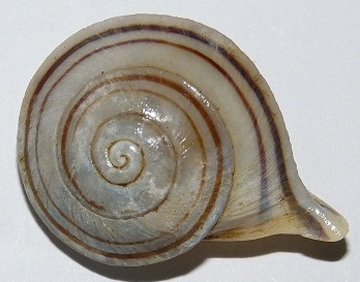 Researchers have discovered a new snail, which is so unusual that it has been granted its own genus: Kenyirus. To date, the mysterious forest snail, found in selectively logged forests around Malaysia’s Lake Kenyir, is only known from its unique shell. “When I first found the snail on the forest floor, I knew immediately it […]
Researchers have discovered a new snail, which is so unusual that it has been granted its own genus: Kenyirus. To date, the mysterious forest snail, found in selectively logged forests around Malaysia’s Lake Kenyir, is only known from its unique shell. “When I first found the snail on the forest floor, I knew immediately it […]
96 percent of the world’s species remain unevaluated by the Red List
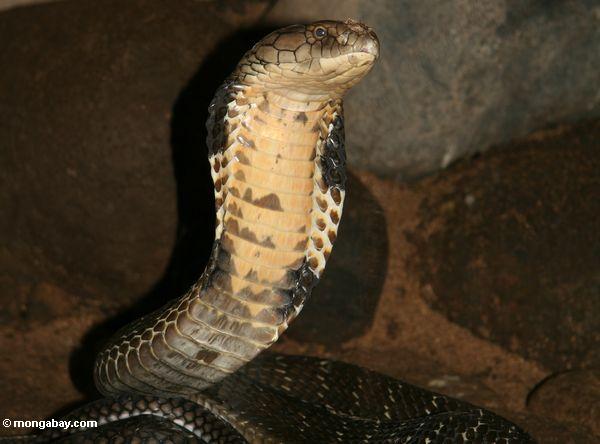 The IUCN Red List releases its 2012 update, adding 247 species to its threatened categories. The king cobra has been evaluated by the IUCN Red List for the first time and listed as Vulnerable. Photo by: Rhett A. Butler. Nearly 250 species have been added to the threatened categories—i.e. Vulnerable, Endangered, and Critically Endangered—in this […]
The IUCN Red List releases its 2012 update, adding 247 species to its threatened categories. The king cobra has been evaluated by the IUCN Red List for the first time and listed as Vulnerable. Photo by: Rhett A. Butler. Nearly 250 species have been added to the threatened categories—i.e. Vulnerable, Endangered, and Critically Endangered—in this […]
New tiny crustacean discovered in deep sea off Europe (photo)
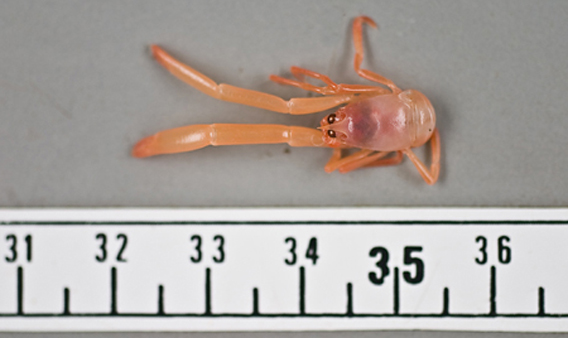 Uroptychus cartesi. Photo by: Antonio Punzon/IEO. Scientists have pulled up a tiny new species of ‘squat lobster’ from a deep sea mountain at 1,410 meters below sea level off the coast of Spain. Dubbed Uroptychus cartesi, this is only the fourth species in this genus from the eastern Atlantic Ocean, although there are over hundred […]
Uroptychus cartesi. Photo by: Antonio Punzon/IEO. Scientists have pulled up a tiny new species of ‘squat lobster’ from a deep sea mountain at 1,410 meters below sea level off the coast of Spain. Dubbed Uroptychus cartesi, this is only the fourth species in this genus from the eastern Atlantic Ocean, although there are over hundred […]
Forgotten Species: the wonder-inducing giant clam
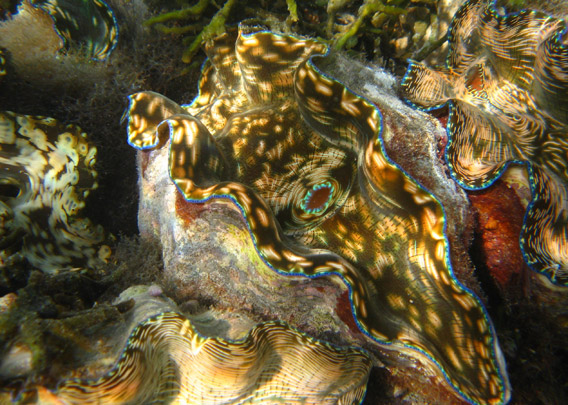 Everyone knows the tiger, the panda, the blue whale, but what about the other five to thirty million species estimated to inhabit our Earth? Many of these marvelous, stunning, and rare species have received little attention from the media, conservation groups, and the public. This series is an attempt to give these ‘forgotten species‘ some […]
Everyone knows the tiger, the panda, the blue whale, but what about the other five to thirty million species estimated to inhabit our Earth? Many of these marvelous, stunning, and rare species have received little attention from the media, conservation groups, and the public. This series is an attempt to give these ‘forgotten species‘ some […]
After damning research, France proposes banning pesticide linked to bee collapse
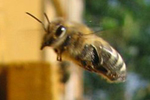 Following research linking neonicotinoid pesticides to the decline in bee populations, France has announced it plans to ban Cruiser OSR, an insecticide produced by Sygenta. Recent studies, including one in France, have shown that neonicotinoid pesticides likely hurt bees’ ability to navigate, potentially devastating hives. France has said it will give Sygenta two weeks to […]
Following research linking neonicotinoid pesticides to the decline in bee populations, France has announced it plans to ban Cruiser OSR, an insecticide produced by Sygenta. Recent studies, including one in France, have shown that neonicotinoid pesticides likely hurt bees’ ability to navigate, potentially devastating hives. France has said it will give Sygenta two weeks to […]
Blue tarantula, walking cactus, and a worm from Hell: the top 10 new species of 2011
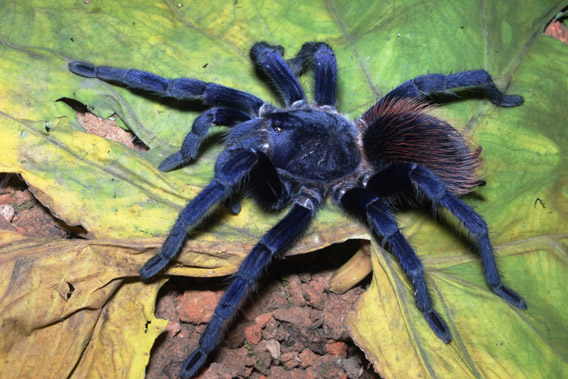 Sazima’s tarantula: one of the top ten new species discovered in 2011 according to the annual list by the International Institute for Species Exploration at Arizona State University. Photo by: Caroline S. Fukushima. A sneezing monkey, a blue tarantula, and an extinct walking cactus are just three of the remarkable new species listed in the […]
Sazima’s tarantula: one of the top ten new species discovered in 2011 according to the annual list by the International Institute for Species Exploration at Arizona State University. Photo by: Caroline S. Fukushima. A sneezing monkey, a blue tarantula, and an extinct walking cactus are just three of the remarkable new species listed in the […]
Eye-popping purple crabs discovered in the Philippines
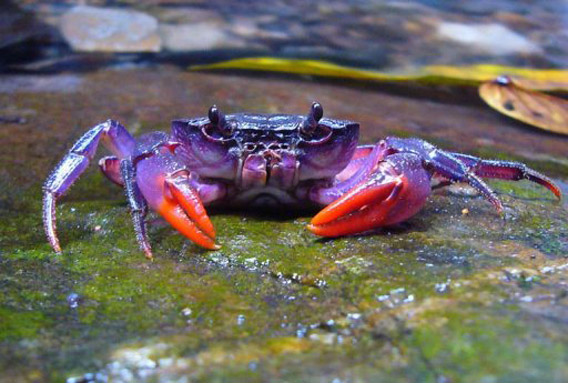 New species of purple crab: Insulamon palawanense. Photo by: Hendrik Freitag. Scientists have discovered four new species of brilliantly-colored freshwater crabs on the Philippine island of Palawan. Described in the Raffles Bulletin of Zoology, the new species expands the genus, Insulamon, from one known crab species to five. Although its ecosystems are threatened by widespread […]
New species of purple crab: Insulamon palawanense. Photo by: Hendrik Freitag. Scientists have discovered four new species of brilliantly-colored freshwater crabs on the Philippine island of Palawan. Described in the Raffles Bulletin of Zoology, the new species expands the genus, Insulamon, from one known crab species to five. Although its ecosystems are threatened by widespread […]
Researchers recreate bee collapse with pesticide-laced corn syrup
 Honeybees in an apiary in Germany. Photo by: Björn Appel. Scientists with the Harvard School of Public Health (HSPH) have re-created the mysterious Colony Collapse Disorder in several honeybee hives simply by giving them small doses of a popular pesticide, imidacloprid. Bee populations have been dying mysteriously throughout North America and Europe since 2006, but […]
Honeybees in an apiary in Germany. Photo by: Björn Appel. Scientists with the Harvard School of Public Health (HSPH) have re-created the mysterious Colony Collapse Disorder in several honeybee hives simply by giving them small doses of a popular pesticide, imidacloprid. Bee populations have been dying mysteriously throughout North America and Europe since 2006, but […]
Smoking gun for bee collapse? popular pesticides
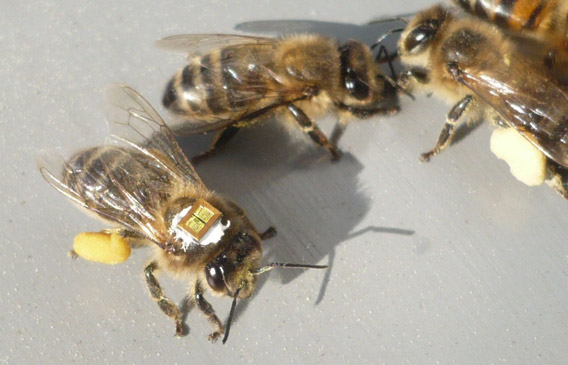 A honeybee tagged with an RFID microchip for tracking its movements. Photo © Science/AAAS. Commonly used pesticides may be a primary driver of the collapsing bee populations, finds two new studies in Science. The studies, one focused on honeybees and the other on bumblebees, found that even small doses of these pesticides, which target insect’s […]
A honeybee tagged with an RFID microchip for tracking its movements. Photo © Science/AAAS. Commonly used pesticides may be a primary driver of the collapsing bee populations, finds two new studies in Science. The studies, one focused on honeybees and the other on bumblebees, found that even small doses of these pesticides, which target insect’s […]
Beyond Bigfoot: the science of cryptozoology
- Anyone who doubts cryptozoology, which in Greek means the “study of hidden animals,” should remember the many lessons of the past 110 years:
- the mountain gorilla (discovered in 1902), the colossal squid (discovered in 1925, but a full specimen not caught until 1981), and the saola (discovered in 1992) to name a few.
- Every year, almost 20,000 new species are described by the world’s scientists, and a new book by Dr. Karl Shuker highlights some of the most incredible and notable new animals uncovered during the past century.
Scientists discover world’s deepest terrestrial animal
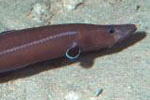 It’s not the prehistoric monsters from the Jules Verne’s Journey to the Center of the Earth or the human-bat hybrids of The Decsent, but it’s an astonishing discovery nonetheless: intrepid scientists have discovered the world’s deepest surviving terrestrial animal to date, a small wingless insect known as a springtail. Explorers discovered the new species, Plutomurus […]
It’s not the prehistoric monsters from the Jules Verne’s Journey to the Center of the Earth or the human-bat hybrids of The Decsent, but it’s an astonishing discovery nonetheless: intrepid scientists have discovered the world’s deepest surviving terrestrial animal to date, a small wingless insect known as a springtail. Explorers discovered the new species, Plutomurus […]
Innovative conservation: wild silk, endangered species, and poverty in Madagascar
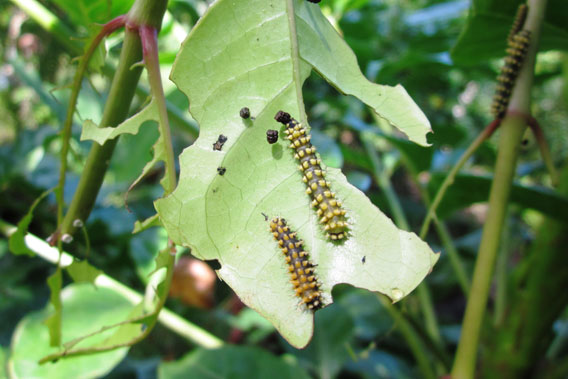 Moth larvae munching on a host plant. Photo by: Tom Corcoran. For anyone who works in conservation in Madagascar, confronting the complex difficulties of widespread poverty is a part of the job. But with the wealth of Madagascar’s wildlife rapidly diminishing— such as lemurs, miniature chameleons, and hedgehog-looking tenrecs found no-where else in the world—the […]
Moth larvae munching on a host plant. Photo by: Tom Corcoran. For anyone who works in conservation in Madagascar, confronting the complex difficulties of widespread poverty is a part of the job. But with the wealth of Madagascar’s wildlife rapidly diminishing— such as lemurs, miniature chameleons, and hedgehog-looking tenrecs found no-where else in the world—the […]
Jurassic insect sings again
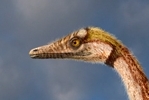 Innovative research has made a long-extinct katydid—which inhabited the world of dinosaurs like stegosaurus, allosaurus, and diplodocus—sing again. The discovery of an incredibly well-preserved fossil of a new species of katydid, dubbed Archaboilus musicus, gave biomechanical experts the opportunity to recreate a song not heard in 165 million years, according to new research published in […]
Innovative research has made a long-extinct katydid—which inhabited the world of dinosaurs like stegosaurus, allosaurus, and diplodocus—sing again. The discovery of an incredibly well-preserved fossil of a new species of katydid, dubbed Archaboilus musicus, gave biomechanical experts the opportunity to recreate a song not heard in 165 million years, according to new research published in […]
Jellyfish explosion may be natural cycle
 Evidence that jellyfish are taking over the oceans is currently lacking, according to a new study published in Bioscience. Complied by a number of marine experts, the study found that while jellyfish have been on the rise in some regions it is likely due to a natural cycle of jellyfish populations and not a global […]
Evidence that jellyfish are taking over the oceans is currently lacking, according to a new study published in Bioscience. Complied by a number of marine experts, the study found that while jellyfish have been on the rise in some regions it is likely due to a natural cycle of jellyfish populations and not a global […]
Photo of the day: super-abundance of life found in Amazon park
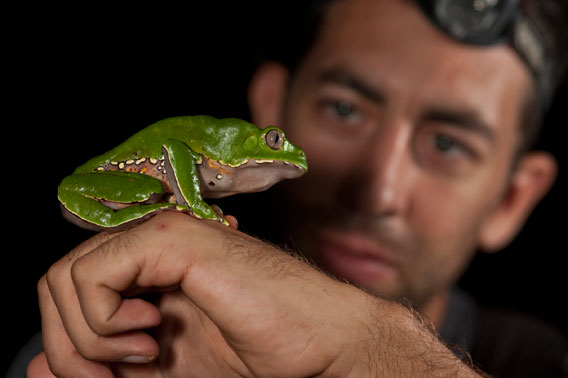 Giant leaf frogs are among the 50 reptiles and amphibian species found in the park. Photo by: Andre Baertschi. Surveying a little-explored park in the Peruvian Amazon has paid off in dividends: researchers with the Wildlife Conservation Society (WCS) have cataloged 365 species that had never been recorded in Bahuaja Sonene National Park. The species […]
Giant leaf frogs are among the 50 reptiles and amphibian species found in the park. Photo by: Andre Baertschi. Surveying a little-explored park in the Peruvian Amazon has paid off in dividends: researchers with the Wildlife Conservation Society (WCS) have cataloged 365 species that had never been recorded in Bahuaja Sonene National Park. The species […]
Photos: 46 new species found in little-explored Amazonian nation
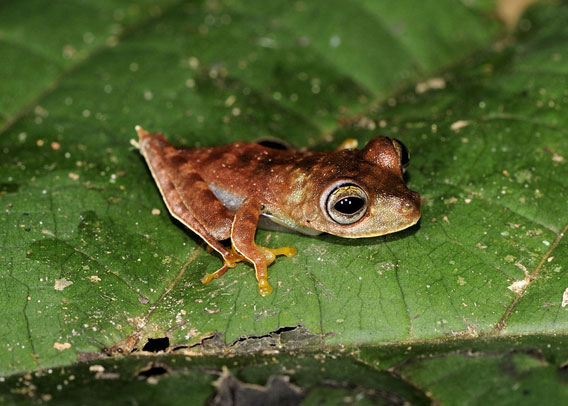 A possible new species of frog: Hypsiboas sp. (nickname “cowboy frog”) has white fringes along the legs and a spur on the heel. The frog was discovered low on a small branch during a night survey in a swampy area west of the RAP base camp at the Koetari River during Conservation International’s Rapid Assessment […]
A possible new species of frog: Hypsiboas sp. (nickname “cowboy frog”) has white fringes along the legs and a spur on the heel. The frog was discovered low on a small branch during a night survey in a swampy area west of the RAP base camp at the Koetari River during Conservation International’s Rapid Assessment […]
Acid oceans: in some regions acidification a ‘hundred times greater’ than natural variation
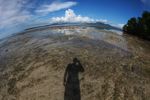 Emissions of carbon over the last two centuries have raised the acidity of the oceans to the highest levels in 21,000 years and likely beyond, according to a new study in Nature Climate Change. The change threatens a number of marine species, including coral reefs and molluscs. The oceans play a massive role in the […]
Emissions of carbon over the last two centuries have raised the acidity of the oceans to the highest levels in 21,000 years and likely beyond, according to a new study in Nature Climate Change. The change threatens a number of marine species, including coral reefs and molluscs. The oceans play a massive role in the […]
Economic slowdown leads to the pulping of Latvia’s forests
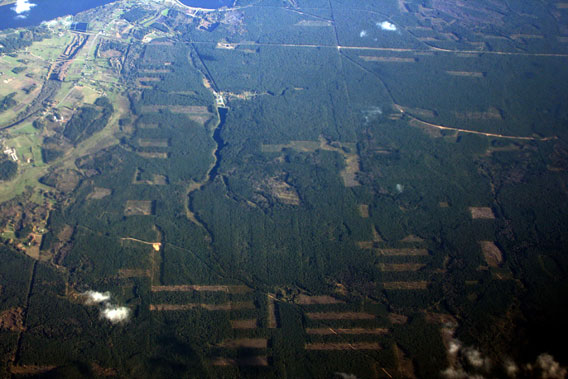 Aerial view over Latvian forests—please note almost all cutting patches are fresh, not yet regenerated. Photo by: R.Matrozis, 2007. The economic crisis has pushed many nations to scramble for revenue and jobs in tight times, and the small Eastern European nation of Latvia is no different. Facing tough circumstances, the country turned to its most […]
Aerial view over Latvian forests—please note almost all cutting patches are fresh, not yet regenerated. Photo by: R.Matrozis, 2007. The economic crisis has pushed many nations to scramble for revenue and jobs in tight times, and the small Eastern European nation of Latvia is no different. Facing tough circumstances, the country turned to its most […]
Scientists discover over 19,000 new species in 2009
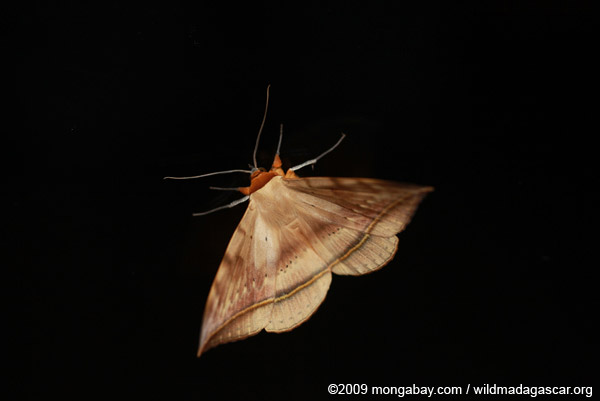 Unidentified moth in Madagascar. Photo by: Rhett A. Butler. In 2009 researchers described and named 19,232 species new to science, pushing the number of known species on Earth to just under two million (1,941,939 species), according to the State of Observed Species (SOS). Discoveries included seven new birds, 41 mammals, 120 reptiles, 148 amphibians, 314 […]
Unidentified moth in Madagascar. Photo by: Rhett A. Butler. In 2009 researchers described and named 19,232 species new to science, pushing the number of known species on Earth to just under two million (1,941,939 species), according to the State of Observed Species (SOS). Discoveries included seven new birds, 41 mammals, 120 reptiles, 148 amphibians, 314 […]
New book series hopes to inspire research in world’s ‘hottest biodiversity hotspot’
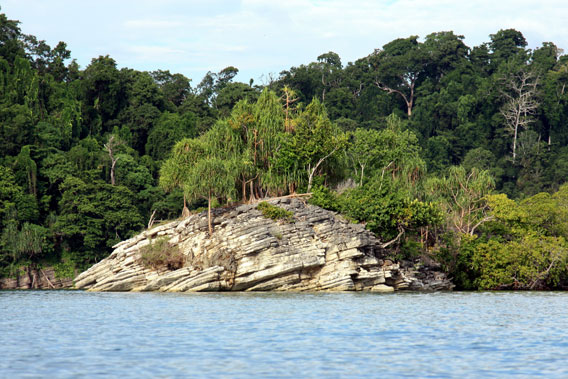 Pristine coastal vegetation: Misool island, Raja Ampat. Photo by: Dimtry Telnov, 2009. Entomologist Dmitry Telnov hopes his new pet project will inspire and disseminate research about one of the world’s last unexplored biogeographical regions: Wallacea and New Guinea. Incredibly rich in biodiversity and still full of unknown species, the region, also known as the Indo-Australian […]
Pristine coastal vegetation: Misool island, Raja Ampat. Photo by: Dimtry Telnov, 2009. Entomologist Dmitry Telnov hopes his new pet project will inspire and disseminate research about one of the world’s last unexplored biogeographical regions: Wallacea and New Guinea. Incredibly rich in biodiversity and still full of unknown species, the region, also known as the Indo-Australian […]
Beyoncé honored with new horse fly named after her
-beyonceae-2.568.jpg) Scaptia beyonceae. Photo by: Bryan Lessard, CSIRO. Musical artist, and dancer extraordinare, Beyoncé has been awarded a new honor this week: entomologists in Australia have named a new horse fly after the American singer. The horse fly, dubbed Scaptia beyonceae, is found in Queensland’s Atherton Tablelands. “It was the unique dense golden hairs on the […]
Scaptia beyonceae. Photo by: Bryan Lessard, CSIRO. Musical artist, and dancer extraordinare, Beyoncé has been awarded a new honor this week: entomologists in Australia have named a new horse fly after the American singer. The horse fly, dubbed Scaptia beyonceae, is found in Queensland’s Atherton Tablelands. “It was the unique dense golden hairs on the […]
Photos: scientists find new species at world’s deepest undersea vent
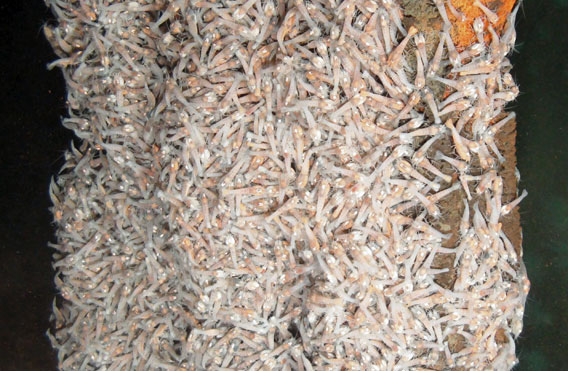 New shrimp species crowd the world’s deepest undersea vents. Photo by: University of Southampton/National Oceanography Center (NOC). It sounds like a medieval vision of hell: in pitch darkness, amid blazing heat, rise spewing volcanic vents. But there are no demons and devils down here, instead the deep sea hydrothermal vent, located in the very non-hellish […]
New shrimp species crowd the world’s deepest undersea vents. Photo by: University of Southampton/National Oceanography Center (NOC). It sounds like a medieval vision of hell: in pitch darkness, amid blazing heat, rise spewing volcanic vents. But there are no demons and devils down here, instead the deep sea hydrothermal vent, located in the very non-hellish […]
Weird carnivorous flower devours worms underground
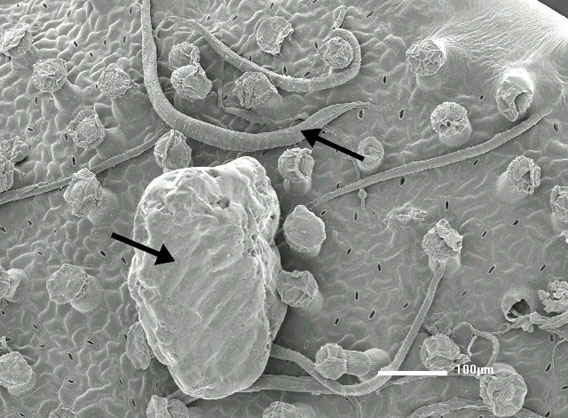 Scanning electron microscope image shows the upper leaf surface of Philcoxia minensis. Arrows point to nematodes and sand grains. A worm measuring only a millimeter in length scoots its way through relatively massive grains of white sand. The worm, known as a nematode or roundworm, is seeking lunch in the form of bacteria. Suddenly, however, […]
Scanning electron microscope image shows the upper leaf surface of Philcoxia minensis. Arrows point to nematodes and sand grains. A worm measuring only a millimeter in length scoots its way through relatively massive grains of white sand. The worm, known as a nematode or roundworm, is seeking lunch in the form of bacteria. Suddenly, however, […]
Will Taiwan save its last pristine coastline?
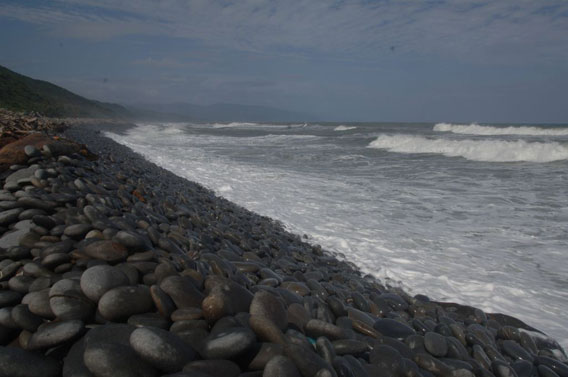 The Alangyi coastline. Photo by: Pierre Fidenci. Voters in the January 14 Taiwanese presidential election will decide the fate of the island’s last pristine wilderness known as the Alangyi Trail. Amongst the three candidates, only one (Tsai Ing-wen from the Democratic Progressive Party) may support the conservation of Alangyi Trail and its coastline. One of […]
The Alangyi coastline. Photo by: Pierre Fidenci. Voters in the January 14 Taiwanese presidential election will decide the fate of the island’s last pristine wilderness known as the Alangyi Trail. Amongst the three candidates, only one (Tsai Ing-wen from the Democratic Progressive Party) may support the conservation of Alangyi Trail and its coastline. One of […]
‘Lost world’ dominated by Yeti crabs discovered in the Antarctic deep
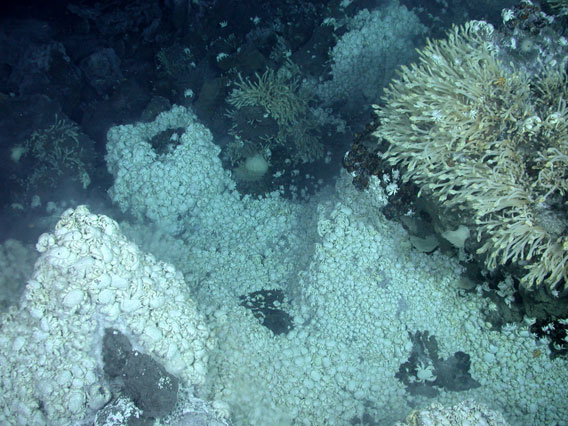 A new species of Yeti crabs cover nearly every inch of the “lost world” of deep sea Antarctic hydrothermal vents. Photo by: Oxford University. Click to enlarge. Scientists have discovered a deep sea ecosystem dominated by hairy pale crabs off of Antarctica. The new species of “Yeti crabs” survive alongside many other likely new species, […]
A new species of Yeti crabs cover nearly every inch of the “lost world” of deep sea Antarctic hydrothermal vents. Photo by: Oxford University. Click to enlarge. Scientists have discovered a deep sea ecosystem dominated by hairy pale crabs off of Antarctica. The new species of “Yeti crabs” survive alongside many other likely new species, […]
Estimating the rich diversity of galling insects
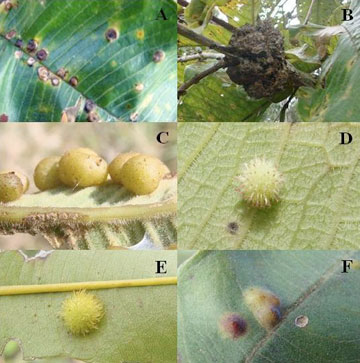 How does one estimate the number of tiny, cryptic “galling” insects without finding and describing every one (a task that could take centuries of taxonomic work)? According to a new paper in mongabay.com’s open access journal Tropical Conservation Science, you count the plants. Galling insects use plant tissue for development creating a “gall,” or abnormal […]
How does one estimate the number of tiny, cryptic “galling” insects without finding and describing every one (a task that could take centuries of taxonomic work)? According to a new paper in mongabay.com’s open access journal Tropical Conservation Science, you count the plants. Galling insects use plant tissue for development creating a “gall,” or abnormal […]
Photos: two dozen new beetles discovered in Papua New Guinea hotspot
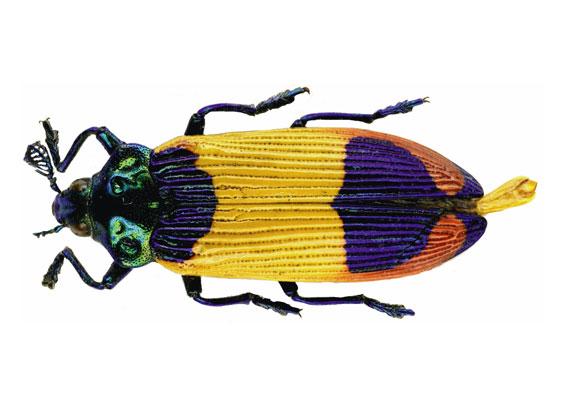 Jewel beetle named, Castiarina shelleybarkerim is only known by a single specimen from Aseki. Photo by: U.Nylander. Over the past two decades, at least 24 new beetles species have been discovered in a remote mountainous rainforest region of Papua New Guinea by Swedish entomologists Ulf Nylander. Described in the new book Biodiversity, Biogeography and Nature […]
Jewel beetle named, Castiarina shelleybarkerim is only known by a single specimen from Aseki. Photo by: U.Nylander. Over the past two decades, at least 24 new beetles species have been discovered in a remote mountainous rainforest region of Papua New Guinea by Swedish entomologists Ulf Nylander. Described in the new book Biodiversity, Biogeography and Nature […]
Bathtub-sized marine sponge rediscovered after a century of extinction
 Neptune’s cup used as a bathtub for a child before overharvesting almost pushed the species to extinction. Not found alive for over a century the evocatively named Neptune’s cup sponge (Cliona patera) has been rediscovered off the shores of Singapore. Researchers with the environmental consulting DHI Group found the species during a routine dive. Although […]
Neptune’s cup used as a bathtub for a child before overharvesting almost pushed the species to extinction. Not found alive for over a century the evocatively named Neptune’s cup sponge (Cliona patera) has been rediscovered off the shores of Singapore. Researchers with the environmental consulting DHI Group found the species during a routine dive. Although […]
800 nearly-extinct giant snails freeze to death in conservation center
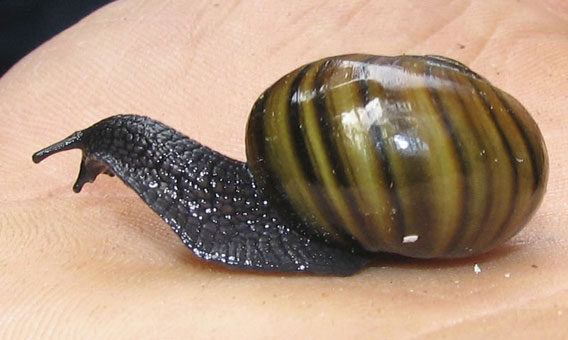 New Zealand’s Powelliphanta snail. Photo by: Alan Liefting. Eight hundred large carnivorous snails, known as Powelliphanta snails (Powelliphanta augusta), died in a Department of Conservation (DOC) fridge in New Zealand over the weekend. A faulty temperature gauge caused the fridge to cool down to zero degrees Celsius, slowly killing all the molluscs but a lone […]
New Zealand’s Powelliphanta snail. Photo by: Alan Liefting. Eight hundred large carnivorous snails, known as Powelliphanta snails (Powelliphanta augusta), died in a Department of Conservation (DOC) fridge in New Zealand over the weekend. A faulty temperature gauge caused the fridge to cool down to zero degrees Celsius, slowly killing all the molluscs but a lone […]
Photos: bizarre shell of new snail baffles researchers
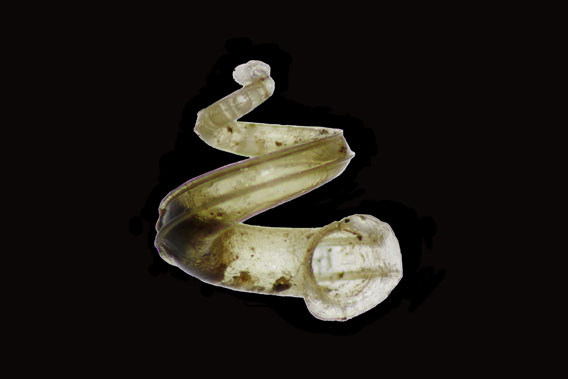 Shell of the new micro-snail, Ditropopsis mirabilis. Photo by: Kristine Greke. A new species of snail with a bizarre shell has surprised scientists. Discovered near massive waterfalls in pristine lowland rainforest in New Guinea, the tiny new species’ shell is shaped like a cornucopia, spirals flying freely instead of fused together like most shells. Latvian […]
Shell of the new micro-snail, Ditropopsis mirabilis. Photo by: Kristine Greke. A new species of snail with a bizarre shell has surprised scientists. Discovered near massive waterfalls in pristine lowland rainforest in New Guinea, the tiny new species’ shell is shaped like a cornucopia, spirals flying freely instead of fused together like most shells. Latvian […]
Beetle bonanza: 84 new species prove richness of Indo-Australian islands
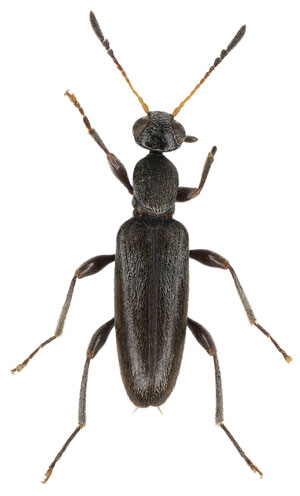 Re-examining beetle specimens from 19 museums has led to the discovery of 84 new beetle species in the Macratria genus. The new species span the islands of Indonesia, New Guinea, and the Solomon Islands, tripling the number of known Macratria beetles in the region. “Species of the genus Macratria are cosmopolitan, with the highest species […]
Re-examining beetle specimens from 19 museums has led to the discovery of 84 new beetle species in the Macratria genus. The new species span the islands of Indonesia, New Guinea, and the Solomon Islands, tripling the number of known Macratria beetles in the region. “Species of the genus Macratria are cosmopolitan, with the highest species […]
Coral reef biodiversity may be vastly underestimated
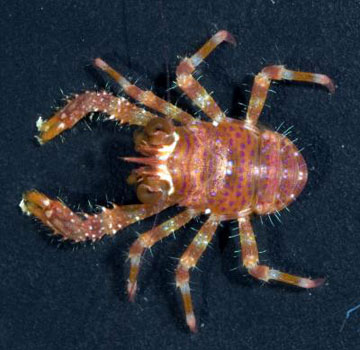 Researchers with the Smithsonian have catalogued almost as many crab species on tropical coral reef bits measuring just 20.6 square feet (6.3 square meters) as in all of Europe’s seas, finds a new paper in PLoS ONE. The team used DNA barcoding to quickly identify a total of 525 crustaceans (including 168 crab species) from […]
Researchers with the Smithsonian have catalogued almost as many crab species on tropical coral reef bits measuring just 20.6 square feet (6.3 square meters) as in all of Europe’s seas, finds a new paper in PLoS ONE. The team used DNA barcoding to quickly identify a total of 525 crustaceans (including 168 crab species) from […]
Picture of the day: cookies and cream moth?
 An as yet unidentified white-and-black moth in Panama. Photo by Rhett A. Butler. This moth species from Panama has not yet been identified by mongabay.com. Moths makes up the bulk of the insect-family Lepidoptera, which also includes butterflies. In all there are over 170,000 species described in this family with likely thousands still hidden. Moths […]
An as yet unidentified white-and-black moth in Panama. Photo by Rhett A. Butler. This moth species from Panama has not yet been identified by mongabay.com. Moths makes up the bulk of the insect-family Lepidoptera, which also includes butterflies. In all there are over 170,000 species described in this family with likely thousands still hidden. Moths […]
Picture of the day: world’s scariest species
 Mosquito in New Guinea. Photo by: Rhett A. Butler. What’s the world’s scariest species? Runner-up would likely be the mosquito species that transmit malaria. Nearly a million people die from malaria annually, making up some 2.23 percent of deaths worldwide. Annual cases of malaria are over 200 million. Most of the deaths occur in sub-Saharan […]
Mosquito in New Guinea. Photo by: Rhett A. Butler. What’s the world’s scariest species? Runner-up would likely be the mosquito species that transmit malaria. Nearly a million people die from malaria annually, making up some 2.23 percent of deaths worldwide. Annual cases of malaria are over 200 million. Most of the deaths occur in sub-Saharan […]
Photos: Halloween creepy-crawlies of the natural world
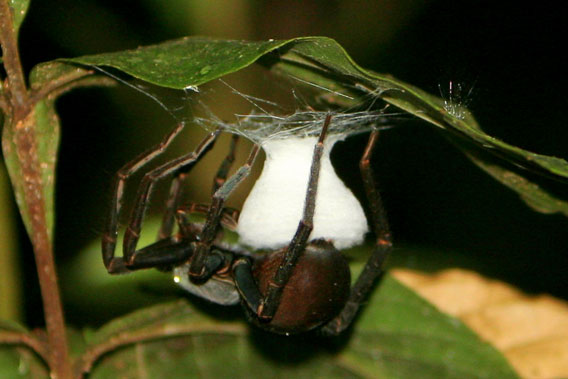 Everyone loves the beautiful animals, the playful orangutans, the rolly-polly pandas, the regal tigers, the wise elephants, the awe-inspiring whales, the silly penguins—and it shows. Aside from gracing calendars and starring in movies, these species receive millions in conservation funds and have no shortage of researchers devoted to them. But what about the ugly, crawly, […]
Everyone loves the beautiful animals, the playful orangutans, the rolly-polly pandas, the regal tigers, the wise elephants, the awe-inspiring whales, the silly penguins—and it shows. Aside from gracing calendars and starring in movies, these species receive millions in conservation funds and have no shortage of researchers devoted to them. But what about the ugly, crawly, […]
Florida loses two species to extinction
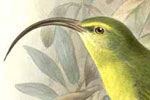 The US Fish and Wildlife Service announced yesterday that the believe two species in Florida have vanished into the long dark night: the South Florida rainbow snake (Farancia erytrogramma seminola) and the Florida fairy shrimp (Dexteria floridana). The species were under review for possibly being added to the Endangered Species Act (ESA), but it’s likely […]
The US Fish and Wildlife Service announced yesterday that the believe two species in Florida have vanished into the long dark night: the South Florida rainbow snake (Farancia erytrogramma seminola) and the Florida fairy shrimp (Dexteria floridana). The species were under review for possibly being added to the Endangered Species Act (ESA), but it’s likely […]
Meet the just discovered ‘Komodo dragon’ of wasps
.568.jpg) A new wasp found in the Mekongga Mountains in southeastern has jaws bigger than its legs. Photo by Kathy Keatley Garvey. A new species of warrior wasp has been discovered on the Indonesian island of Sulawesi that is so large and, frankly, terrifying-looking that it has been dubbed the ‘Komodo dragon’ of the wasp family. […]
A new wasp found in the Mekongga Mountains in southeastern has jaws bigger than its legs. Photo by Kathy Keatley Garvey. A new species of warrior wasp has been discovered on the Indonesian island of Sulawesi that is so large and, frankly, terrifying-looking that it has been dubbed the ‘Komodo dragon’ of the wasp family. […]
Animal picture of the day: 18 pound lobster saved from dinner plate
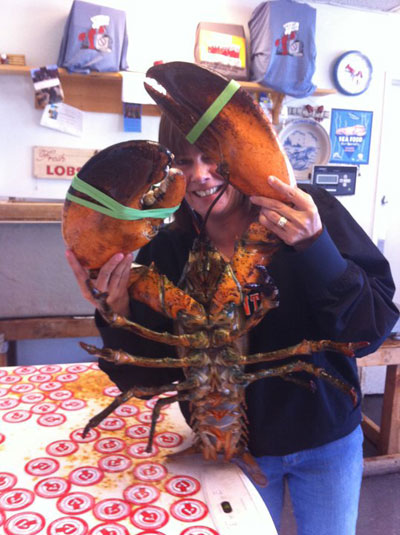 Caught off the coast of Canada, this 18-pound American lobster was saved from being cooked by a seafood distributor in San Francisco and now has a new home at the New York Aquarium. Photo courtesy of the Wildlife Conservation Society (WCS). “When we saw that ad for an 18-pound American lobster, we knew we had […]
Caught off the coast of Canada, this 18-pound American lobster was saved from being cooked by a seafood distributor in San Francisco and now has a new home at the New York Aquarium. Photo courtesy of the Wildlife Conservation Society (WCS). “When we saw that ad for an 18-pound American lobster, we knew we had […]
Photo: six new mini-moths discovered
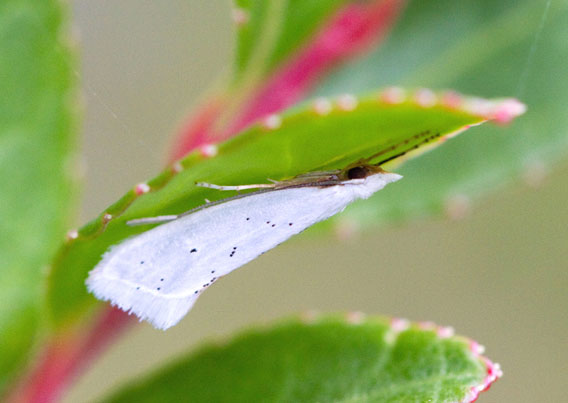 A new species of ermine moth, native to Costa Rica: Eucalantica costaricae. Photo by: Jae-Cheon Sohn and Kenji Nishida. Researchers have discovered six new species of moth from Central America, according to a new paper in Zoo Keys. The moths belong to the primitive Yponomeutidae family, which are commonly known as ermine moths, since some […]
A new species of ermine moth, native to Costa Rica: Eucalantica costaricae. Photo by: Jae-Cheon Sohn and Kenji Nishida. Researchers have discovered six new species of moth from Central America, according to a new paper in Zoo Keys. The moths belong to the primitive Yponomeutidae family, which are commonly known as ermine moths, since some […]
Photo: four new jewel beetles uncovered in Thailand and Indonesia
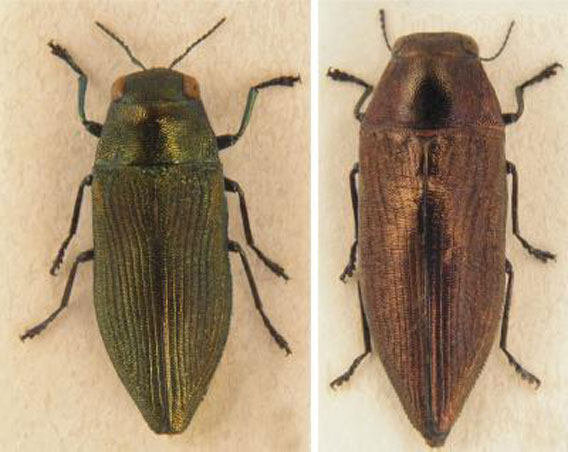 Philanthaxia jakli (left) is from Sumatra and Philanthaxia chalcogenoides (right) is from Borneo. Philanthaxia lombokana (not pictured) is from Lombok and Philanthaxia pseudoaenea (not pictured) is from Thailand. Photo by: Svatopluk Bílý and Oto Nakládal. Researchers have discovered four new species of jewel beetles, one from Thailand and three from Indonesia. Jewel beetles, in the […]
Philanthaxia jakli (left) is from Sumatra and Philanthaxia chalcogenoides (right) is from Borneo. Philanthaxia lombokana (not pictured) is from Lombok and Philanthaxia pseudoaenea (not pictured) is from Thailand. Photo by: Svatopluk Bílý and Oto Nakládal. Researchers have discovered four new species of jewel beetles, one from Thailand and three from Indonesia. Jewel beetles, in the […]
Ant surprises on Murciélago Islands in Costa Rica
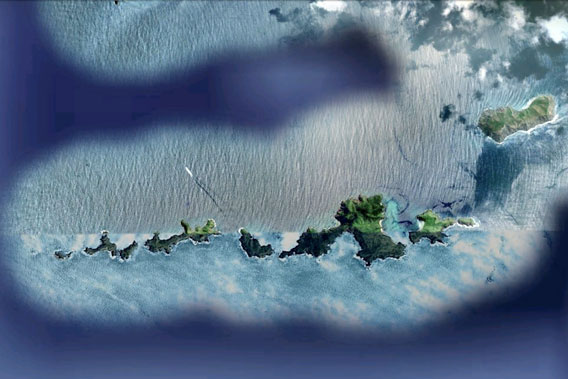 Murciélago Islands as seen by Google Earth. The Murciélago Islands are seven small islands off the northwest coast of Costa Rica in the Area de Conservación Guanacaste (ACG), home to one of the largest intact dry tropical forests in Central America. Despite this, few scientists have studied the biodiversity of these small uninhabited islands. A […]
Murciélago Islands as seen by Google Earth. The Murciélago Islands are seven small islands off the northwest coast of Costa Rica in the Area de Conservación Guanacaste (ACG), home to one of the largest intact dry tropical forests in Central America. Despite this, few scientists have studied the biodiversity of these small uninhabited islands. A […]
Over 900 species added to endangered list during past year
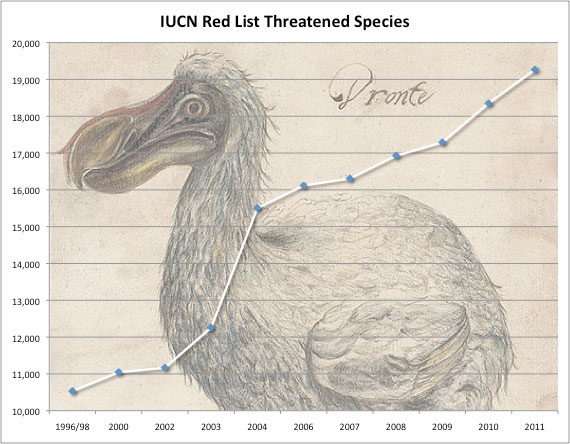 Previously unpublished 17th Century Dutch sketch of the dodo, taken from a real specimen, either alive or stuffed. Dronte means dodo in Dutch. The past twelve months have seen 914 species added to the threatened list by the world’s authority of species endangerment, the International Union for the Conservation of Nature (IUCN)’s Red List. Over […]
Previously unpublished 17th Century Dutch sketch of the dodo, taken from a real specimen, either alive or stuffed. Dronte means dodo in Dutch. The past twelve months have seen 914 species added to the threatened list by the world’s authority of species endangerment, the International Union for the Conservation of Nature (IUCN)’s Red List. Over […]
New bee species sports world’s longest tongue
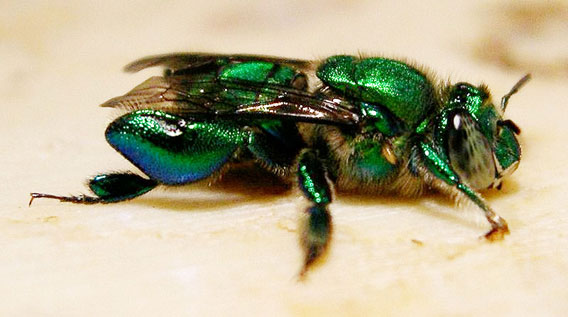 A new species of bee discovered in the Colombian rainforest could give the world’s biggest raspberry! Researchers say the new bee has the longest tongue of any known bee, and may even have the world’s longest tongue compared to body size of any animal: twice the size of the bee itself. The new species has […]
A new species of bee discovered in the Colombian rainforest could give the world’s biggest raspberry! Researchers say the new bee has the longest tongue of any known bee, and may even have the world’s longest tongue compared to body size of any animal: twice the size of the bee itself. The new species has […]
With 24 eyes, box jellyfish are constantly looking up
Lacking brains does not mean box jellyfish are incapable of complex visual behavior, according to a new study in Current Biology. Researchers have known for over a century that box jellyfish support an astounding two-dozen eyes. Now, they are beginning to find out how these eyes are used: four of a box jellyfish’s 24 eyes […]
Noise in oceans leads to ‘severe acoustic trauma’ in octopus, squid
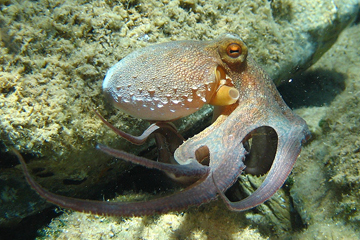 Researchers have documented for years how noise pollution impacts dolphins in whales, but a new study in Frontiers in Ecology and the Environment finds that even low intensity noise can severely injure cephalopods, which include octopus, squid, and cuttlefish. The injuries are bad enough to possibly lead to stranding and death, thereby providing a feasible […]
Researchers have documented for years how noise pollution impacts dolphins in whales, but a new study in Frontiers in Ecology and the Environment finds that even low intensity noise can severely injure cephalopods, which include octopus, squid, and cuttlefish. The injuries are bad enough to possibly lead to stranding and death, thereby providing a feasible […]
Antarctic penguins losing to climate change through 80% krill decline
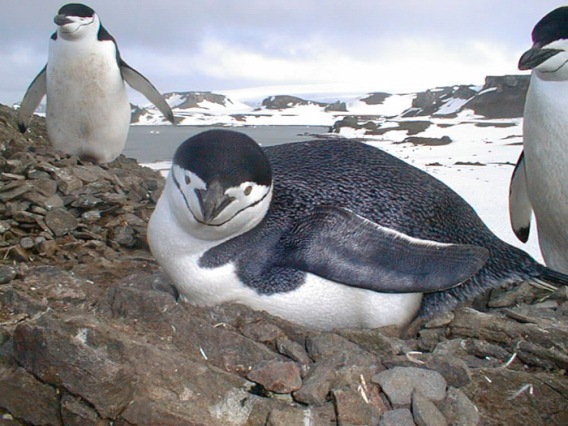 Chinstrap penguins. Photo by: NOAA/Mike Goebel. . Climate change has hit species of Antarctic penguins by causing a staggering decline in their prey: krill. A new study in the Proceedings of the National Academy of Sciences (PNAS) has found that both chinstrap penguins (Pygoscelis antarcticus) and Adélie penguins (Pygoscelis adeliae) have seen their populations decline […]
Chinstrap penguins. Photo by: NOAA/Mike Goebel. . Climate change has hit species of Antarctic penguins by causing a staggering decline in their prey: krill. A new study in the Proceedings of the National Academy of Sciences (PNAS) has found that both chinstrap penguins (Pygoscelis antarcticus) and Adélie penguins (Pygoscelis adeliae) have seen their populations decline […]
The value of the little guy, an interview with Tyler Prize-winning entomologist May Berenbaum
 Honeybees in an apiary in Germany. Photo by: Björn Appel. May Berenbaum knows a thing or two about insects: in recognition of her lifelong work on the interactions between insects and plants, she has had a character on The X-Files named after her, received the Public Understanding of Science and Technology Award for her work […]
Honeybees in an apiary in Germany. Photo by: Björn Appel. May Berenbaum knows a thing or two about insects: in recognition of her lifelong work on the interactions between insects and plants, she has had a character on The X-Files named after her, received the Public Understanding of Science and Technology Award for her work […]
New land snail invading Singapore requires swift action
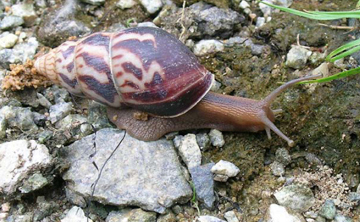 An African land snail Limicolaria flammea has been discovered by researchers in six locations in Singapore, perhaps heralding a new invasion of alien land snails in Southeast Asia. Although snails may seem largely innocuous creatures, past invasions have resulted in agricultural and economic damage. The global invasion of the giant African land snail (Achatina fulica) […]
An African land snail Limicolaria flammea has been discovered by researchers in six locations in Singapore, perhaps heralding a new invasion of alien land snails in Southeast Asia. Although snails may seem largely innocuous creatures, past invasions have resulted in agricultural and economic damage. The global invasion of the giant African land snail (Achatina fulica) […]
Cloud forest dung beetles in India point to ‘fossil ecosystem’
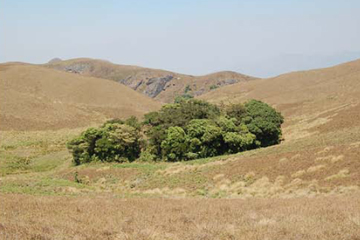 In the cloud forests and grasslands of India’s Western Ghats, known as sholas, researchers have for the first time comprehensively studied the inhabiting dung beetle populations. The resulting study in mongabay.com’s open access journal Tropical Conservation Science, has led scientists to hypothesize that the beetles in concordance with the sheep-like mammal, the nilgiri tahr (Nilgiritragus […]
In the cloud forests and grasslands of India’s Western Ghats, known as sholas, researchers have for the first time comprehensively studied the inhabiting dung beetle populations. The resulting study in mongabay.com’s open access journal Tropical Conservation Science, has led scientists to hypothesize that the beetles in concordance with the sheep-like mammal, the nilgiri tahr (Nilgiritragus […]
15 conservation issues to watch
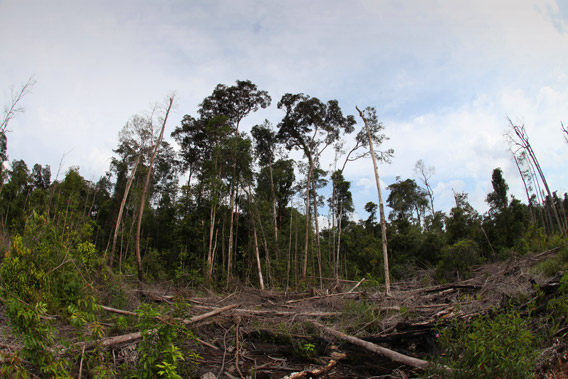 Deforestation near Gunung Palung in Indonesian Borneo. Photo by: Rhett A. Butler Deforestation, oil spills, coral acidification: these are just a few examples of ongoing, and well-researched, environmental changes that are imperiling the world’s biodiversity. But what issues are on the horizon? At the end of 2010, experts outlined in Trends in Ecology & Evolution […]
Deforestation near Gunung Palung in Indonesian Borneo. Photo by: Rhett A. Butler Deforestation, oil spills, coral acidification: these are just a few examples of ongoing, and well-researched, environmental changes that are imperiling the world’s biodiversity. But what issues are on the horizon? At the end of 2010, experts outlined in Trends in Ecology & Evolution […]
New species of zombie-creating fungi discovered
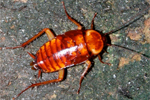 As everyone knows, human zombies are created when an uninfected human is bitten by a member of the brain-craving undead. But what about ant zombies? Yes, that’s right: ant zombies. In the South American rainforest, ants have a mortal enemy: the parasitic fungi in the Ophiocordyceps (also known as Cordyceps) genus. These fungi infect ants […]
As everyone knows, human zombies are created when an uninfected human is bitten by a member of the brain-craving undead. But what about ant zombies? Yes, that’s right: ant zombies. In the South American rainforest, ants have a mortal enemy: the parasitic fungi in the Ophiocordyceps (also known as Cordyceps) genus. These fungi infect ants […]
The ocean crisis: hope in troubled waters, an interview with Carl Safina
 The view from Lazy Point. Photo courtesy of Carl Safina. Being compared—by more than one reviewer—to Henry Thoreau and Rachel Carson would make any nature writer’s day. But add in effusive reviews that compare one to a jazz musician, Ernest Hemingway, and Charles Darwin, and you have a sense of the praise heaped on Carl […]
The view from Lazy Point. Photo courtesy of Carl Safina. Being compared—by more than one reviewer—to Henry Thoreau and Rachel Carson would make any nature writer’s day. But add in effusive reviews that compare one to a jazz musician, Ernest Hemingway, and Charles Darwin, and you have a sense of the praise heaped on Carl […]
‘Environmental and social aggression’: oil exploration threatens award-winning marine protected area
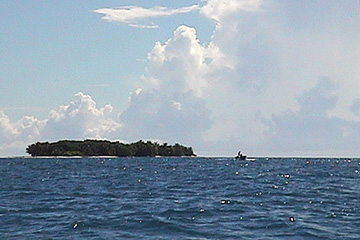 Oil plans put wildlife, people, and award-winning sustainability efforts in the Colombian Caribbean at risk. The Seaflower Marine Protected Area (MPA), which recently won top honors at the Convention on Biological Diversity (CBD) in Japan, is now under threat by planned oil exploration in the region, according to the Providence Foundation which is devoted to […]
Oil plans put wildlife, people, and award-winning sustainability efforts in the Colombian Caribbean at risk. The Seaflower Marine Protected Area (MPA), which recently won top honors at the Convention on Biological Diversity (CBD) in Japan, is now under threat by planned oil exploration in the region, according to the Providence Foundation which is devoted to […]
Photo: expedition discovers 20% of world’s squids, including new species
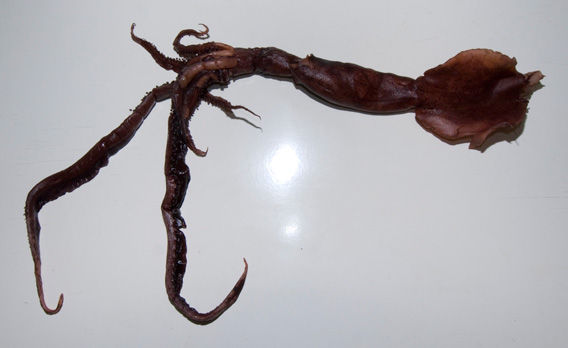 An expedition to the seamounts of the southern Indian Ocean has proven that the region is a biodiverse hotspot for squids. To date, the expedition has identified 70 species of squid comprising 20% of the world’s known squid species. But that’s not all: they have also uncovered new species. At just over 2 feet long […]
An expedition to the seamounts of the southern Indian Ocean has proven that the region is a biodiverse hotspot for squids. To date, the expedition has identified 70 species of squid comprising 20% of the world’s known squid species. But that’s not all: they have also uncovered new species. At just over 2 feet long […]
Critics say Obama slow on endangered species
The Obama Administration is lagging behind past administrations in its listing of dwindling species under the Endangered Species Act (ESA). To date the US Fish and Wildlife Service has added 51 species to the ESA since Obama’s took office, according to the conservation group, Center for Biological Diversity. By contrast, the Clinton Administration averaged 65 […]
Undercover for animals: on the frontline of wildlife crime in the US
 US Fish and Wildlife Service Special Agent Sheila O’Connor revealed the inside story of working in wildlife law enforcement to Laurel Neme on her “The WildLife” radio show and podcast. In the first of a two-part interview, Special Agent O’Connor talks about her adventures stopping wildlife crime—scoping out pet shops in the Chicago area for […]
US Fish and Wildlife Service Special Agent Sheila O’Connor revealed the inside story of working in wildlife law enforcement to Laurel Neme on her “The WildLife” radio show and podcast. In the first of a two-part interview, Special Agent O’Connor talks about her adventures stopping wildlife crime—scoping out pet shops in the Chicago area for […]
Colombian marine reserve receives top honors at global biodiversity meeting
Coralina, a Colombian government agency that established the Seaflower Marine Protected Area (MPA) with local community involvement, is being heralded today by the Convention on Biological Diversity (CBD) in Nagoya, Japan. Proving that conservation and sustainable economic opportunities can go hand-in-hand, Coralina was instrumental in creating a marine park that protects nearly 200 endangered species […]
Monarch butterflies medicate their sick kids
 A new study in Ecology Letters has discovered that monarch butterflies employ medicinal plants to treat their larva. Researchers found that certain species of milkweed, which the larva feed on, can reduce the threat of a sometime deadly parasite. However, even more surprising: “we have also found that infected female butterflies prefer to lay their […]
A new study in Ecology Letters has discovered that monarch butterflies employ medicinal plants to treat their larva. Researchers found that certain species of milkweed, which the larva feed on, can reduce the threat of a sometime deadly parasite. However, even more surprising: “we have also found that infected female butterflies prefer to lay their […]
The effect of forest regeneration strategies on beetles
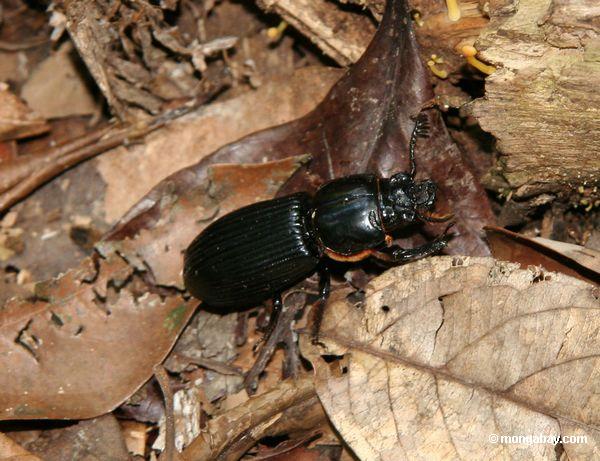 As conservationists attempt to find the best way to re-establish forests in abandoned areas, a new study in the open-access journal Tropical Conservation Science compares the impacts on bess beetles of different method to regeneration forest. Bess beetles are important dead wood-recyclers in the forest. Looking at three different forests in the Colombian Andes—natural regeneration, […]
As conservationists attempt to find the best way to re-establish forests in abandoned areas, a new study in the open-access journal Tropical Conservation Science compares the impacts on bess beetles of different method to regeneration forest. Bess beetles are important dead wood-recyclers in the forest. Looking at three different forests in the Colombian Andes—natural regeneration, […]
How the overlooked peccary engineers the Amazon, an interview with Harald Beck
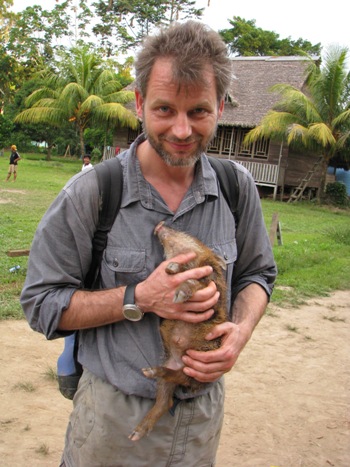 When people think of the Amazon rainforest, they likely think of roaring jaguars, jumping monkeys, marching ants, and squeezing anacondas. The humble peccary would hardly be among the first animals to cross their mind, if they even know such pig-like animals exists! Yet new research on the peccary is proving just how vital these species […]
When people think of the Amazon rainforest, they likely think of roaring jaguars, jumping monkeys, marching ants, and squeezing anacondas. The humble peccary would hardly be among the first animals to cross their mind, if they even know such pig-like animals exists! Yet new research on the peccary is proving just how vital these species […]
Coral reef survival depends on the super small, an interview with Forest Rohwer
 If you take a teaspoon and dip it into the ocean what will you have? Some drops of lifeless water? Only a few decades ago this is what scientists would have said, however, the development of increasingly powerful microscopes have shown us a world long unknown, which has vital importance for the survival of one […]
If you take a teaspoon and dip it into the ocean what will you have? Some drops of lifeless water? Only a few decades ago this is what scientists would have said, however, the development of increasingly powerful microscopes have shown us a world long unknown, which has vital importance for the survival of one […]
Exploring Kenya’s sky island
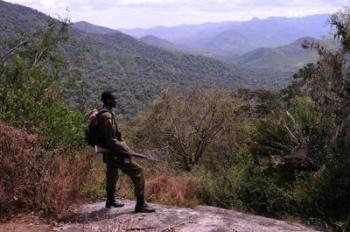 An interview with Paula Kahumbu of WildlifeDirect. Rising over 2,500 meters from Kenya’s northern desert, the Mathews Range is a sky island: isolated mountain forests surrounded by valleys. Long cut off from other forests, ‘sky islands’ such as this often contain unique species and ecosystems. Supported by the Nature Conservancy, an expedition including local community […]
An interview with Paula Kahumbu of WildlifeDirect. Rising over 2,500 meters from Kenya’s northern desert, the Mathews Range is a sky island: isolated mountain forests surrounded by valleys. Long cut off from other forests, ‘sky islands’ such as this often contain unique species and ecosystems. Supported by the Nature Conservancy, an expedition including local community […]
The biology and conservation of declining coral reefs, an interview with Kristian Teleki
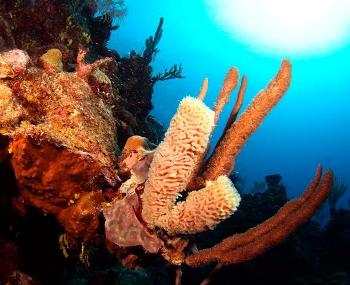 Kristian Teleki, Vice President for Science Initiatives for SeaWeb and former Director of the International Coral Reef Action Network (ICRAN), spoke with Laurel Neme on her “The WildLife” radio show and podcast about the biology of corals, threats to coral reefs, and what can be done to halt their decline. This interview originally aired May […]
Kristian Teleki, Vice President for Science Initiatives for SeaWeb and former Director of the International Coral Reef Action Network (ICRAN), spoke with Laurel Neme on her “The WildLife” radio show and podcast about the biology of corals, threats to coral reefs, and what can be done to halt their decline. This interview originally aired May […]
Logged forests retain considerable biodiversity in Borneo providing conservation opportunity
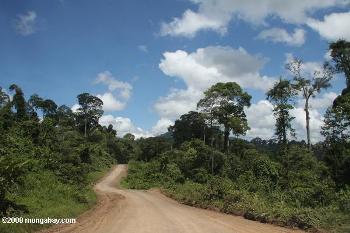 75 percent of birds and dung beetles remain even after a forest is logged twice. A new study in the Proceedings of the Royal Society B finds that forests which have undergone logging in the past, sometimes even twice, retain significant levels of biodiversity in Borneo. The researchers say these findings should push conservationists to […]
75 percent of birds and dung beetles remain even after a forest is logged twice. A new study in the Proceedings of the Royal Society B finds that forests which have undergone logging in the past, sometimes even twice, retain significant levels of biodiversity in Borneo. The researchers say these findings should push conservationists to […]
Forgotten species: the nameless giant forest snail
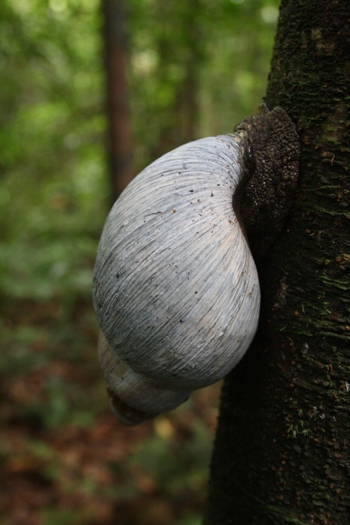 Everyone knows the tiger, the panda, the blue whale, but what about the other five to thirty million species estimated to inhabit our Earth? Many of these marvelous, stunning, and rare species have received little attention from the media, conservation groups, and the public. This series is an attempt to give these ‘forgotten species‘ some […]
Everyone knows the tiger, the panda, the blue whale, but what about the other five to thirty million species estimated to inhabit our Earth? Many of these marvelous, stunning, and rare species have received little attention from the media, conservation groups, and the public. This series is an attempt to give these ‘forgotten species‘ some […]
What is the most unexplored ecosystem on Earth?
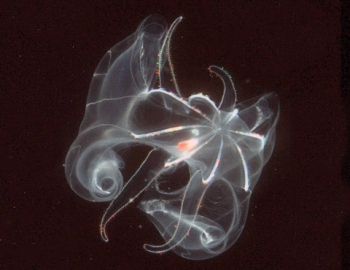 One should be forgiven for thinking that the most under-explored ecosystem in the world is tropical rainforests or cave systems since new species are frequently uncovered in such places. But new research in the open-access journal PLoS ONE finds that the least explored part of the world is the deep sea, especially what lies beneath […]
One should be forgiven for thinking that the most under-explored ecosystem in the world is tropical rainforests or cave systems since new species are frequently uncovered in such places. But new research in the open-access journal PLoS ONE finds that the least explored part of the world is the deep sea, especially what lies beneath […]
Eleven new species discovered in France
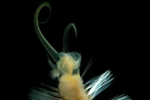 Usually announcements of new species come from biodiverse rainforests or unexplored marine depths, but researchers have announced the discovery of nearly a dozen new species in one of Earth’s most well-trodden place: France. Eleven new species have been discovered in Mercantour National Park in southern France. All the new species are insects, including one beetle, […]
Usually announcements of new species come from biodiverse rainforests or unexplored marine depths, but researchers have announced the discovery of nearly a dozen new species in one of Earth’s most well-trodden place: France. Eleven new species have been discovered in Mercantour National Park in southern France. All the new species are insects, including one beetle, […]
Amazing reefs: how corals ‘hear’, an interview with Steve Simpson
 Steve Simpson, Senior Researcher at the University of Bristol’s School of Biological Sciences, spoke with Laurel Neme on her “The WildLife” radio show and podcast about ocean sounds and how reef fish and corals use these cues to find their way home. This interview originally aired June 28, 2010. The interview was transcribed by Ed […]
Steve Simpson, Senior Researcher at the University of Bristol’s School of Biological Sciences, spoke with Laurel Neme on her “The WildLife” radio show and podcast about ocean sounds and how reef fish and corals use these cues to find their way home. This interview originally aired June 28, 2010. The interview was transcribed by Ed […]
Feeds: news | india | latam | brasil | indonesia
 Cornfields in Iowa. Photo credit: David Gonthier. To protect natural ecosystems in the long term, some conservationists advocate "land sparing," in which farmers intensify agricultural practices to boost yields, theoretically enabling them to forgo expansion into natural areas. Others advocate "land sharing," in which farmers take over more land but use low-intensity, more environmentally friendly […]
Cornfields in Iowa. Photo credit: David Gonthier. To protect natural ecosystems in the long term, some conservationists advocate "land sparing," in which farmers intensify agricultural practices to boost yields, theoretically enabling them to forgo expansion into natural areas. Others advocate "land sharing," in which farmers take over more land but use low-intensity, more environmentally friendly […] A male Cherax pulcher. Photo by: Christian Lukhaup. An independent researcher has described a spectacular red, white, and blue crayfish just in time for the fourth of July. The new species, named Cherax pulcher, was first discovered in Japanese pet shops by Christian Lukhaup before he finally tracked down the animal to creeks in remote […]
A male Cherax pulcher. Photo by: Christian Lukhaup. An independent researcher has described a spectacular red, white, and blue crayfish just in time for the fourth of July. The new species, named Cherax pulcher, was first discovered in Japanese pet shops by Christian Lukhaup before he finally tracked down the animal to creeks in remote […] A cinereous mourner nestling that resembled a toxic caterpillar in the Megalopygidae family of moths. Photo by: Santiago David Rivera. “Mama, I wanna be a toxic caterpillar,” says the little bird. “Okay,” mamma answers, “but first you gotta study your Batesian mimicry.” Meet the cinereous mourner (Laniocera hypopyrra), an ash-colored, Amazonian bird that looks rather […]
A cinereous mourner nestling that resembled a toxic caterpillar in the Megalopygidae family of moths. Photo by: Santiago David Rivera. “Mama, I wanna be a toxic caterpillar,” says the little bird. “Okay,” mamma answers, “but first you gotta study your Batesian mimicry.” Meet the cinereous mourner (Laniocera hypopyrra), an ash-colored, Amazonian bird that looks rather […] When I was ten, I acquired my first dog. Rani was a Doberman Pinscher—tall, lean, and a huge pushover. She was wonderfully friendly, but sadly misunderstood her whole life, regularly frightening all except those who knew her intimately. There were two innocuous reasons for this—both of which reveal the power of emotions shared across species. […]
When I was ten, I acquired my first dog. Rani was a Doberman Pinscher—tall, lean, and a huge pushover. She was wonderfully friendly, but sadly misunderstood her whole life, regularly frightening all except those who knew her intimately. There were two innocuous reasons for this—both of which reveal the power of emotions shared across species. […] Researchers argue that predictability of ecosystem could be sign of health A largely pristine coral reef in the remote Pacific on an island largely unpopulated by humans. Photo by: Brian J. Zgliczynski. There is a growing consensus among scientists of all stripes that we have entered the age of the Anthropocene, or the epoch of […]
Researchers argue that predictability of ecosystem could be sign of health A largely pristine coral reef in the remote Pacific on an island largely unpopulated by humans. Photo by: Brian J. Zgliczynski. There is a growing consensus among scientists of all stripes that we have entered the age of the Anthropocene, or the epoch of […] A bumblebee (Bombus terrestris) covered in pollen. Photo by: P7r7/Creative Commons 3.0 Saving the world’s pollinators may be a public health issue, according to recent research from Harvard and the University of Vermont. Scientists have long believed that pollinators are important for human nutrition, but this is first time they have tested the hypothesis. What […]
A bumblebee (Bombus terrestris) covered in pollen. Photo by: P7r7/Creative Commons 3.0 Saving the world’s pollinators may be a public health issue, according to recent research from Harvard and the University of Vermont. Scientists have long believed that pollinators are important for human nutrition, but this is first time they have tested the hypothesis. What […] Palm tree and termite mound: typical scenery in Okavango Delta in Botswana. Photo by Tiffany Roufs. Some termite species erect massive mounds that look like great temples springing up from the world’s savannas and drylands. But aside from their aesthetic appeal—and incredible engineering—new research in Science finds that these structures, which can stand taller than […]
Palm tree and termite mound: typical scenery in Okavango Delta in Botswana. Photo by Tiffany Roufs. Some termite species erect massive mounds that look like great temples springing up from the world’s savannas and drylands. But aside from their aesthetic appeal—and incredible engineering—new research in Science finds that these structures, which can stand taller than […] Monarch butterfly population is second lowest on record The shrinking of the migrating monarch butterfly population. Image by: WWF. The world’s migrating monarch butterfly population has bounced back slightly from its record low last year, but the new numbers are still the second smallest on record. According to WWF-Mexico and the Mexican government, butterflies covered […]
Monarch butterfly population is second lowest on record The shrinking of the migrating monarch butterfly population. Image by: WWF. The world’s migrating monarch butterfly population has bounced back slightly from its record low last year, but the new numbers are still the second smallest on record. According to WWF-Mexico and the Mexican government, butterflies covered […] Darwin’s Worms, Our Worry Earthworms. Image courtesy of the US Fish & Wildlife Service 1st November 1837 was a disappointing day at the Geological Society of London. The men (and they were only men) of the Society were expecting great things from the young Charles Darwin, recently returned from his Beagle voyage. Yet on that […]
Darwin’s Worms, Our Worry Earthworms. Image courtesy of the US Fish & Wildlife Service 1st November 1837 was a disappointing day at the Geological Society of London. The men (and they were only men) of the Society were expecting great things from the young Charles Darwin, recently returned from his Beagle voyage. Yet on that […] In woodland and savannah areas, certain termite species play a critical environmental role due to the mounds they build. These mounds can be used as fertilizer to induce new ecosystems, and the termites themselves can be studied as biological indicators of human-caused degradation. Detecting the amount and distribution of these mounds throughout an area can […]
In woodland and savannah areas, certain termite species play a critical environmental role due to the mounds they build. These mounds can be used as fertilizer to induce new ecosystems, and the termites themselves can be studied as biological indicators of human-caused degradation. Detecting the amount and distribution of these mounds throughout an area can […] Modern day expeditions face a collection dilemma as scientists consider ethics and endangerment A tray of Eriocnemis (a genus of hummingbird) specimens, Swedish Museum of Natural History – Naturhistoriska Riksmuseet,Stockholm, CC BY-SA 3,0 License, Wikimedia. In 1912, a group of intrepid explorers led by Rollo and Ida Beck, widely acknowledged to be the foremost marine […]
Modern day expeditions face a collection dilemma as scientists consider ethics and endangerment A tray of Eriocnemis (a genus of hummingbird) specimens, Swedish Museum of Natural History – Naturhistoriska Riksmuseet,Stockholm, CC BY-SA 3,0 License, Wikimedia. In 1912, a group of intrepid explorers led by Rollo and Ida Beck, widely acknowledged to be the foremost marine […] While unpleasant car exhaust makes us wrinkle our noses, such human-made fumes may pose serious problems to insects searching for nectar. Researchers recently revealed that background odors make finding flowers difficult for pollinators. The study, published in Science, measured how hawk moths (Manduca sexta) pick out the sacred datura flower scent (Datura wrightii) amidst all […]
While unpleasant car exhaust makes us wrinkle our noses, such human-made fumes may pose serious problems to insects searching for nectar. Researchers recently revealed that background odors make finding flowers difficult for pollinators. The study, published in Science, measured how hawk moths (Manduca sexta) pick out the sacred datura flower scent (Datura wrightii) amidst all […].600.jpg) An Antarctic krill. Photo by: Uwe Kils/Creative Commons 3.0. Another year, another failed attempt to protect a significant chunk of the Ross Sea, which sits off the coast of Antarctica. According to observers, efforts to create the world’s biggest marine protected area to date were shot down by Russia and China during a meeting in […]
An Antarctic krill. Photo by: Uwe Kils/Creative Commons 3.0. Another year, another failed attempt to protect a significant chunk of the Ross Sea, which sits off the coast of Antarctica. According to observers, efforts to create the world’s biggest marine protected area to date were shot down by Russia and China during a meeting in […] Scientists have named new species after celebrities, fictional characters, and even the corporations that threaten a species’ very existence, but a new snail may be the first to be named after a global human rights movement: the on-going struggle for same-sex marriage. Scientists have named the new Taiwanese land snail, Aegista diversifamilia, meaning diverse human […]
Scientists have named new species after celebrities, fictional characters, and even the corporations that threaten a species’ very existence, but a new snail may be the first to be named after a global human rights movement: the on-going struggle for same-sex marriage. Scientists have named the new Taiwanese land snail, Aegista diversifamilia, meaning diverse human […] Aerial view of cement quarry and limestone hill home to a number of species found nowhere else including a new snail. Photo by: Ong Poh Teck/Basteria. Scientists have discovered a new snail species on a limestone hill near a cement quarry in Malaysia, which as far as they know lives nowhere else in the world. […]
Aerial view of cement quarry and limestone hill home to a number of species found nowhere else including a new snail. Photo by: Ong Poh Teck/Basteria. Scientists have discovered a new snail species on a limestone hill near a cement quarry in Malaysia, which as far as they know lives nowhere else in the world. […] Researchers urge increased conservation attention for invertebrates, fragmented habitats A team of scientists from the United States and Germany has recently described seven new species of Malagasy giant pill-millipede. All but one of these species are considered “microendemics,” in that they have only been found in small, isolated forest patches. The study was published in […]
Researchers urge increased conservation attention for invertebrates, fragmented habitats A team of scientists from the United States and Germany has recently described seven new species of Malagasy giant pill-millipede. All but one of these species are considered “microendemics,” in that they have only been found in small, isolated forest patches. The study was published in […] Scientists discover that Graneledone boreopacifica has the longest brooding time of any animal on the planet The ultimate goal of all species on the planet is procreation, the act of making anew. And many species go to great lengths to set their progeny off on the right path: orangutan mothers have been known to breast […]
Scientists discover that Graneledone boreopacifica has the longest brooding time of any animal on the planet The ultimate goal of all species on the planet is procreation, the act of making anew. And many species go to great lengths to set their progeny off on the right path: orangutan mothers have been known to breast […] Unknown orange butterfly in Sumatra. Scientists believe we are in the midst of a defaunation crisis, which is impacting animals, and ecological services, the world over. Photo by: Rhett A. Butler. Get ready to learn a new word: defaunation. Fauna is the total collection of animals—both in terms of species diversity and abundance—in a given […]
Unknown orange butterfly in Sumatra. Scientists believe we are in the midst of a defaunation crisis, which is impacting animals, and ecological services, the world over. Photo by: Rhett A. Butler. Get ready to learn a new word: defaunation. Fauna is the total collection of animals—both in terms of species diversity and abundance—in a given […] The Cape Melville leaf-tailed gecko (Saltuarius eximius) is one of the top ten new species from 2013. Photo by: Conrad Hoskin. Out of around 18,000 new species described and named last year, scientists have highlighted ten in an effort to raise awareness about the imperiled biodiversity around us. Each species—from a teddy-bear-like carnivore in the […]
The Cape Melville leaf-tailed gecko (Saltuarius eximius) is one of the top ten new species from 2013. Photo by: Conrad Hoskin. Out of around 18,000 new species described and named last year, scientists have highlighted ten in an effort to raise awareness about the imperiled biodiversity around us. Each species—from a teddy-bear-like carnivore in the […] In a cave in Australia, researchers from the University of New South Wales discovered giant fossilized sperm. The sperm were produced 17 million years ago by a group of tiny, shelled crustaceans called ostracods, making them the oldest fossilized sperm ever found. The results were published recently in Proceedings of the Royal Society B. The […]
In a cave in Australia, researchers from the University of New South Wales discovered giant fossilized sperm. The sperm were produced 17 million years ago by a group of tiny, shelled crustaceans called ostracods, making them the oldest fossilized sperm ever found. The results were published recently in Proceedings of the Royal Society B. The […] It could be the plot of a horror movie: humans wake up one day to discover that chemical changes in the atmosphere are dissolving away parts of their bodies. But for small marine life known as sea butterflies, or pteropods, this is what’s happening off the West Cost of the U.S. Increased carbon in the […]
It could be the plot of a horror movie: humans wake up one day to discover that chemical changes in the atmosphere are dissolving away parts of their bodies. But for small marine life known as sea butterflies, or pteropods, this is what’s happening off the West Cost of the U.S. Increased carbon in the […] Among the huge diversity of insects there are some bewilderingly complex life cycles, but few can compete with the trigonalid wasps for the seemingly haphazard way they ensure their genes are passed to the next generation. In most cases, a female parasitoid wasp deposits her eggs on or in the host, but this is far […]
Among the huge diversity of insects there are some bewilderingly complex life cycles, but few can compete with the trigonalid wasps for the seemingly haphazard way they ensure their genes are passed to the next generation. In most cases, a female parasitoid wasp deposits her eggs on or in the host, but this is far […] A new species of praying mantis named after former Vice President Al Gore—Liturgusa algorei—for his climate activism. Photo courtesy of Svenson et al. Despite their pacific name, praying mantises are ferocious top predators with powerful, grasping forelimbs; spiked legs; and mechanistic jaws. In fact, imagine a tiger that can rotate its head 180 degrees or […]
A new species of praying mantis named after former Vice President Al Gore—Liturgusa algorei—for his climate activism. Photo courtesy of Svenson et al. Despite their pacific name, praying mantises are ferocious top predators with powerful, grasping forelimbs; spiked legs; and mechanistic jaws. In fact, imagine a tiger that can rotate its head 180 degrees or […] Scientists have discovered the gene enabling multiple female morphs that give the Common Mormon butterfly its very tongue-in-cheek name. doublesex, the gene that controls gender in insects, is also a mimicry supergene that determines diverse wing patterns in this butterfly, according to a recent study published in Nature. The study also shows that the supergene […]
Scientists have discovered the gene enabling multiple female morphs that give the Common Mormon butterfly its very tongue-in-cheek name. doublesex, the gene that controls gender in insects, is also a mimicry supergene that determines diverse wing patterns in this butterfly, according to a recent study published in Nature. The study also shows that the supergene […] Without wings, smaller terrestrial animals are really restricted when it comes to moving long distances to find new areas of habitat. However, lots of species get around this problem simply by clinging on to other, more mobile animals. The common, yet overlooked pseudoscorpions are among the most accomplished stowaways, one of which (Cordylochernes scorpiodes) has […]
Without wings, smaller terrestrial animals are really restricted when it comes to moving long distances to find new areas of habitat. However, lots of species get around this problem simply by clinging on to other, more mobile animals. The common, yet overlooked pseudoscorpions are among the most accomplished stowaways, one of which (Cordylochernes scorpiodes) has […] The seabed is really where it’s at in terms of animal diversity. Of the 35 known animal lineages, representatives of all but two are found here. In contrast, the huge numbers of species that inhabit tropical rainforests represent a mere 12 lineages. One group of animals that illustrates the diversity of the seabed is the […]
The seabed is really where it’s at in terms of animal diversity. Of the 35 known animal lineages, representatives of all but two are found here. In contrast, the huge numbers of species that inhabit tropical rainforests represent a mere 12 lineages. One group of animals that illustrates the diversity of the seabed is the […] Scientists have identified two new wasp species, years after the specimens were first collected from the wild. The two new species, Abernessia prima and Abernessia capixaba, belong to the rare pompilid genus Abernessia, and are believed to be endemic to Brazil. They made the discovery while examining spider wasp collections from museums in Brazil and […]
Scientists have identified two new wasp species, years after the specimens were first collected from the wild. The two new species, Abernessia prima and Abernessia capixaba, belong to the rare pompilid genus Abernessia, and are believed to be endemic to Brazil. They made the discovery while examining spider wasp collections from museums in Brazil and […] Almost everyone knows what an earthworm is, but these very familiar animals are just one variation on a very rich theme that is at its most fabulously varied in the oceans. The mind-boggling appearances and lifestyles of the marine segmented worms are perfectly exemplified by this week’s animal. Looking like an intricately folded napkin or […]
Almost everyone knows what an earthworm is, but these very familiar animals are just one variation on a very rich theme that is at its most fabulously varied in the oceans. The mind-boggling appearances and lifestyles of the marine segmented worms are perfectly exemplified by this week’s animal. Looking like an intricately folded napkin or […] The genus Bombus consists of over 250 species of large, nectar-loving bumblebees. Their bright coloration serves as a warning to predators that they are unwelcome prey and their bodies are covered in a fine coat of hair—known as pile—which gives them their characteristically fuzzy look. Bumblebees display a remarkably capable flight performance despite being encumbered […]
The genus Bombus consists of over 250 species of large, nectar-loving bumblebees. Their bright coloration serves as a warning to predators that they are unwelcome prey and their bodies are covered in a fine coat of hair—known as pile—which gives them their characteristically fuzzy look. Bumblebees display a remarkably capable flight performance despite being encumbered […] The monarch butterfly population overwintering in Mexico this year has hit its lowest numbers ever, according to WWF-Mexico. Monarch butterflies covered just 0.67 hectares in Mexico’s forest, a drop of 44 percent from 2012 already perilously low population. To put this in perspective the average monarch coverage from 1994-2014 was 6.39 or nearly ten times […]
The monarch butterfly population overwintering in Mexico this year has hit its lowest numbers ever, according to WWF-Mexico. Monarch butterflies covered just 0.67 hectares in Mexico’s forest, a drop of 44 percent from 2012 already perilously low population. To put this in perspective the average monarch coverage from 1994-2014 was 6.39 or nearly ten times […] The range of habitats that animals have come to occupy is nothing short of staggering. Take the dicyemids for example. They are among the simplest animals on the planet, with a tiny, worm-like adult body that consists of between 10 and 40 cells. They have no organs, body cavities or even guts—a structural simplicity which […]
The range of habitats that animals have come to occupy is nothing short of staggering. Take the dicyemids for example. They are among the simplest animals on the planet, with a tiny, worm-like adult body that consists of between 10 and 40 cells. They have no organs, body cavities or even guts—a structural simplicity which […] Sea anemones are supposed to sit on the bottom of the ocean, using their basal disc (or adhesive foot) to rest on a coral reef or sand. So, imagine the surprise of geologists in Antarctica when they discovered a mass of sea anemones hanging upside from the underside of the Ross Ice Shelf like a […]
Sea anemones are supposed to sit on the bottom of the ocean, using their basal disc (or adhesive foot) to rest on a coral reef or sand. So, imagine the surprise of geologists in Antarctica when they discovered a mass of sea anemones hanging upside from the underside of the Ross Ice Shelf like a […] The discovery of a new, bi-colored beetle species in the lowland rainforest of French Guiana just added a little pizzazz to the ranks of the Pseudomorphini tribe of beetles. With wing cases (elytra) that sport black spots against a rusty red background, the newcomer was dubbed Guyanemorpha spectabilis, or the spectacular Guyane false-form beetle, by […]
The discovery of a new, bi-colored beetle species in the lowland rainforest of French Guiana just added a little pizzazz to the ranks of the Pseudomorphini tribe of beetles. With wing cases (elytra) that sport black spots against a rusty red background, the newcomer was dubbed Guyanemorpha spectabilis, or the spectacular Guyane false-form beetle, by […] Nematodes are typically small animals that to the naked eye look very much alike; however, these creatures are fantastically diverse —on a par with the arthropods in terms of species diversity. At face value, nematodes lack the charisma of larger animals, so there are very few biologists who have made it their life’s work to […]
Nematodes are typically small animals that to the naked eye look very much alike; however, these creatures are fantastically diverse —on a par with the arthropods in terms of species diversity. At face value, nematodes lack the charisma of larger animals, so there are very few biologists who have made it their life’s work to […] A Stenus beetle. Photo by: Ross Piper. Rove beetles are among the most diverse animals on the planet, with around 56,000 species currently described. Amongst this multitude of species is a dazzling array of adaptations perhaps best illustrated by the genus Stenus. These beetles, with their bulbous eyes and slender bodies are often found near […]
A Stenus beetle. Photo by: Ross Piper. Rove beetles are among the most diverse animals on the planet, with around 56,000 species currently described. Amongst this multitude of species is a dazzling array of adaptations perhaps best illustrated by the genus Stenus. These beetles, with their bulbous eyes and slender bodies are often found near […] Resting near the bottom of the food chain, Antarctic krill (Euphausia superba) underpin much of the Southern Ocean’s ecosystem. But in a rapidly warming world, these hugely-abundant crustaceans could see their habitat shrink considerably. In a recent paper in PLOS ONE, scientists predict that Antarctic krill could lose 20 percent of their growth habitat, or […]
Resting near the bottom of the food chain, Antarctic krill (Euphausia superba) underpin much of the Southern Ocean’s ecosystem. But in a rapidly warming world, these hugely-abundant crustaceans could see their habitat shrink considerably. In a recent paper in PLOS ONE, scientists predict that Antarctic krill could lose 20 percent of their growth habitat, or […] Giant clams are among the more easily spotted invertebrates of the marine realm. However, some are actually quite cryptic and distinct species are often difficult to identify, claims a study recently published in PlosOne. Much attention has been focused on charismatic species in research, but the scientists who authored the study argue that giant clams […]
Giant clams are among the more easily spotted invertebrates of the marine realm. However, some are actually quite cryptic and distinct species are often difficult to identify, claims a study recently published in PlosOne. Much attention has been focused on charismatic species in research, but the scientists who authored the study argue that giant clams […] A sea angel, Clione limacine. In this image the grasping tentacles and chitinous hooks are retracted. Photo by: Alexander Semenov. Most of the species on Earth we never see. In fact, we have no idea what they look like, much less how spectacular they are. In general, people can identify relatively few of their backyard […]
A sea angel, Clione limacine. In this image the grasping tentacles and chitinous hooks are retracted. Photo by: Alexander Semenov. Most of the species on Earth we never see. In fact, we have no idea what they look like, much less how spectacular they are. In general, people can identify relatively few of their backyard […] Scientists have discovered two new species of leaf beetles in southern India that display a novel way of using leaf holes and their fecal pellets to build shelters – a nesting behavior previously not known among leaf beetles. Discovered in the forests of the Western Ghats in the states of Karnataka and Kerala, the scientists […]
Scientists have discovered two new species of leaf beetles in southern India that display a novel way of using leaf holes and their fecal pellets to build shelters – a nesting behavior previously not known among leaf beetles. Discovered in the forests of the Western Ghats in the states of Karnataka and Kerala, the scientists […] If you thought of the little beetle that you saw the other day as just a ‘regular one’ then this might interest you. Scientists from the University of Alaska discovered Nicrophorus efferens, a new species of burying beetle from Solomon Islands. Studying six adult specimens borrowed from the Bernice Pauahi Bishop Museum of Hawaii (BPBM), […]
If you thought of the little beetle that you saw the other day as just a ‘regular one’ then this might interest you. Scientists from the University of Alaska discovered Nicrophorus efferens, a new species of burying beetle from Solomon Islands. Studying six adult specimens borrowed from the Bernice Pauahi Bishop Museum of Hawaii (BPBM), […] When imagining the discovery of a new species, most people conjure thoughts of intrepid explorers, battling the odds in remote rainforests. But this needn’t be the case, at least according to a new study published in Zookeys. The study reports the discovery of a new species of water beetle in the heart of the 10th […]
When imagining the discovery of a new species, most people conjure thoughts of intrepid explorers, battling the odds in remote rainforests. But this needn’t be the case, at least according to a new study published in Zookeys. The study reports the discovery of a new species of water beetle in the heart of the 10th […] In 2004, the first-ever Global Amphibian Assessment (GAA) reviewed all 5,743 amphibian species known to science and concluded that 32% were threatened with extinction – a number far exceeding corresponding figures for birds and mammals (12 to 23% respectively). In addition to the usual culprits of climate change and habitat destruction, a startling 92.5% of […]
In 2004, the first-ever Global Amphibian Assessment (GAA) reviewed all 5,743 amphibian species known to science and concluded that 32% were threatened with extinction – a number far exceeding corresponding figures for birds and mammals (12 to 23% respectively). In addition to the usual culprits of climate change and habitat destruction, a startling 92.5% of […] In one of the most untouched and remote rainforests in the world, scientists have discovered some sixty new species, including a chocolate-colored frog and a super-mini dung beetle. The species were uncovered in Southeastern Suriname during a Rapid Assessment Program (RAP); run by Conservation International (CI), RAPS involve sending teams of specialists into little-known ecosystems […]
In one of the most untouched and remote rainforests in the world, scientists have discovered some sixty new species, including a chocolate-colored frog and a super-mini dung beetle. The species were uncovered in Southeastern Suriname during a Rapid Assessment Program (RAP); run by Conservation International (CI), RAPS involve sending teams of specialists into little-known ecosystems […] The oceans are more acidic now than they have been for at least 300m years, due to carbon dioxide emissions from burning fossil fuels, and a mass extinction of key species may already be almost inevitable as a result, leading marine scientists warned on Thursday. An international audit of the health of the oceans has […]
The oceans are more acidic now than they have been for at least 300m years, due to carbon dioxide emissions from burning fossil fuels, and a mass extinction of key species may already be almost inevitable as a result, leading marine scientists warned on Thursday. An international audit of the health of the oceans has […] A new genus of fairyfly has been discovered in Costa Rica. The new species aptly named Tinkerbella nana after the fairy in J.M. Barrie’s play ‘Peter Pan’ is one of the smallest winged insects in the neotropics. Found in both temperate and tropical climates, the fairyfly is not actually a fly as its name suggests, […]
A new genus of fairyfly has been discovered in Costa Rica. The new species aptly named Tinkerbella nana after the fairy in J.M. Barrie’s play ‘Peter Pan’ is one of the smallest winged insects in the neotropics. Found in both temperate and tropical climates, the fairyfly is not actually a fly as its name suggests, […] In a large room that used to house aquatic mammals at the Minnesota Zoo, Erik Runquist holds up a vial and says, “Here are its eggs.” I peer inside and see small specks, pale with a dot of brown at the top; they look like a single grain of cous cous or quinoa. Runquist explains […]
In a large room that used to house aquatic mammals at the Minnesota Zoo, Erik Runquist holds up a vial and says, “Here are its eggs.” I peer inside and see small specks, pale with a dot of brown at the top; they look like a single grain of cous cous or quinoa. Runquist explains […] Last week U.S. scientists with the biotech company, Sanaria, announced a possible breakthrough on an experimental malaria vaccine: an early trial led to a success rate of 80 percent for the two highest doses. Malaria remains one of the world’s worst scourges. In 2010, the World Health Organization reported 219 million documented cases of malaria […]
Last week U.S. scientists with the biotech company, Sanaria, announced a possible breakthrough on an experimental malaria vaccine: an early trial led to a success rate of 80 percent for the two highest doses. Malaria remains one of the world’s worst scourges. In 2010, the World Health Organization reported 219 million documented cases of malaria […] Conservationist’s faced a crushing blow last month as two butterfly species native to Florida were declared extinct. “Occasionally, these types of butterflies disappear for long periods of time but are rediscovered in another location,” said Larry Williams, U.S. Fish and Wildlife state supervisor for ecological services. We think it’s apparent now these two species are […]
Conservationist’s faced a crushing blow last month as two butterfly species native to Florida were declared extinct. “Occasionally, these types of butterflies disappear for long periods of time but are rediscovered in another location,” said Larry Williams, U.S. Fish and Wildlife state supervisor for ecological services. We think it’s apparent now these two species are […] Europe’s grassland butterfly population has plummeted in the past two decades, new research published on Tuesday shows, with a near halving in the numbers of key species since 1990. The precipitous decline has been blamed on poor agricultural practices and pesticides, by the European Environment Agency, which carried out the research. Falling numbers of butterflies […]
Europe’s grassland butterfly population has plummeted in the past two decades, new research published on Tuesday shows, with a near halving in the numbers of key species since 1990. The precipitous decline has been blamed on poor agricultural practices and pesticides, by the European Environment Agency, which carried out the research. Falling numbers of butterflies […] An international cement company Lafarge, winner of a Green Initiative award, is considering quarrying a cave in Malaysia which is the sole home of a critically endangered species. The proposed operations also threaten a Buddhist monastery near the cave where monks are facing eviction. Kanthan cave in Peninsular Malaysia is located in a limestone hill, […]
An international cement company Lafarge, winner of a Green Initiative award, is considering quarrying a cave in Malaysia which is the sole home of a critically endangered species. The proposed operations also threaten a Buddhist monastery near the cave where monks are facing eviction. Kanthan cave in Peninsular Malaysia is located in a limestone hill, […] A new species of moth (Stenoloba solaris) was discovered in the Yunnan province of China, a new addition to the nascent genus of moth, Stenoloba. The discovery was published in the open access journal ZooKeys. The moth is colloquially known as the “sun moth” because of the intricate pattern that covers its upper wings and […]
A new species of moth (Stenoloba solaris) was discovered in the Yunnan province of China, a new addition to the nascent genus of moth, Stenoloba. The discovery was published in the open access journal ZooKeys. The moth is colloquially known as the “sun moth” because of the intricate pattern that covers its upper wings and […] In the next few months, the beating of fragile fiery orange and black wings will transport the monarch butterfly south. But the number of monarch butterflies (Danaus plexippus) reaching their final destination has steadily declined, dropping to its lowest level in two decades last winter, according to a recent survey. The insect’s journey begins in […]
In the next few months, the beating of fragile fiery orange and black wings will transport the monarch butterfly south. But the number of monarch butterflies (Danaus plexippus) reaching their final destination has steadily declined, dropping to its lowest level in two decades last winter, according to a recent survey. The insect’s journey begins in […] Recent expeditions by the Chinese Academy of Science’s Institute of Zoology to the Yunnan Province of China have uncovered the existence of a new species of long-horned beetle. This newly discovered beetle has a beautifully colored blue-green body with short, slender, and distinctively blue legs according to a new article in Zookeys. There are over […]
Recent expeditions by the Chinese Academy of Science’s Institute of Zoology to the Yunnan Province of China have uncovered the existence of a new species of long-horned beetle. This newly discovered beetle has a beautifully colored blue-green body with short, slender, and distinctively blue legs according to a new article in Zookeys. There are over […] A new species of ant has recently been discovered in the Hortarium of the Los Baños University in the Philippines. Scientists named it the pirate ant (Cardiocondyla pirata) due to the female’s unique pigmentation pattern: a distinctive stripe across the eyes that resembles a pirates’ eye-patch. The pirate ant belongs to a genus Cardiocondyla that […]
A new species of ant has recently been discovered in the Hortarium of the Los Baños University in the Philippines. Scientists named it the pirate ant (Cardiocondyla pirata) due to the female’s unique pigmentation pattern: a distinctive stripe across the eyes that resembles a pirates’ eye-patch. The pirate ant belongs to a genus Cardiocondyla that […] While recent research (and media attention) has focused on the alleged negative impacts of pesticides on bees, the problem may be far broader according to a new study in the Proceedings of the US Academy of Sciences (PNAS). Looking at over 50 streams in Germany, France, and Australia, scientists in Europe and Australia found that […]
While recent research (and media attention) has focused on the alleged negative impacts of pesticides on bees, the problem may be far broader according to a new study in the Proceedings of the US Academy of Sciences (PNAS). Looking at over 50 streams in Germany, France, and Australia, scientists in Europe and Australia found that […] A widely used insect nerve agent has been labelled a “high acute risk” to honeybees by the European Food Safety Authority (EFSA). A similar assessment by the EFSA on three other insecticides preceded the suspension of their use in the European Union. “The insecticide fipronil poses a high acute risk to honeybees when used as […]
A widely used insect nerve agent has been labelled a “high acute risk” to honeybees by the European Food Safety Authority (EFSA). A similar assessment by the EFSA on three other insecticides preceded the suspension of their use in the European Union. “The insecticide fipronil poses a high acute risk to honeybees when used as […] Scientists have long known that ocean acidification is leading to a decline in Pacific oyster (Crassostrea gigas) in the U.S.’s Pacific Northwest region, but a new study in the American Geophysical Union shows exactly how the change is undercutting populations of these economically-important molluscs. Caused by carbon dioxide emissions, ocean acidification changes the very chemistry […]
Scientists have long known that ocean acidification is leading to a decline in Pacific oyster (Crassostrea gigas) in the U.S.’s Pacific Northwest region, but a new study in the American Geophysical Union shows exactly how the change is undercutting populations of these economically-important molluscs. Caused by carbon dioxide emissions, ocean acidification changes the very chemistry […].600.jpg) Scientists across the Mediterranean say a surge in the number of jellyfish this year threatens not just the biodiversity of one of the world’s most overfished seas but also the health of tens of thousands of summer tourists. “I flew along a 300km stretch of coastline on 21 April and saw millions of jellyfish,” said […]
Scientists across the Mediterranean say a surge in the number of jellyfish this year threatens not just the biodiversity of one of the world’s most overfished seas but also the health of tens of thousands of summer tourists. “I flew along a 300km stretch of coastline on 21 April and saw millions of jellyfish,” said […] Hot pink slugs that emerge after rainy nights have become a conservation symbol for alpine forests on Australia’s Mount Kaputar, reports The Sydney Morning Herald. The slugs, which measure up to 20 centimeters (8 inches), are only found on Mount Kaputar, a volcano that last erupted 17 million years ago. They spend most of their […]
Hot pink slugs that emerge after rainy nights have become a conservation symbol for alpine forests on Australia’s Mount Kaputar, reports The Sydney Morning Herald. The slugs, which measure up to 20 centimeters (8 inches), are only found on Mount Kaputar, a volcano that last erupted 17 million years ago. They spend most of their […] In a single paper, a team of researchers have succinctly described 101 new species of weevils from New Guinea, more than doubling the known species in the beetle genus, Trigonopterus. Since describing new species is hugely laborious and time-intensive, the researchers turned to a new method of species description known as ‘turbo-taxonomy,’ which employs a […]
In a single paper, a team of researchers have succinctly described 101 new species of weevils from New Guinea, more than doubling the known species in the beetle genus, Trigonopterus. Since describing new species is hugely laborious and time-intensive, the researchers turned to a new method of species description known as ‘turbo-taxonomy,’ which employs a […] If you fly over the Great African Rift Valley from its northernmost point in Ethiopia, over the great national parks of Kenya and Tanzania, and follow it south to the very end, you will arrive at Gorongosa National Park in central Mozambique. Plateaus on the eastern and western sides of the park flank the lush […]
If you fly over the Great African Rift Valley from its northernmost point in Ethiopia, over the great national parks of Kenya and Tanzania, and follow it south to the very end, you will arrive at Gorongosa National Park in central Mozambique. Plateaus on the eastern and western sides of the park flank the lush […] Scientists have discovered two new species of short-tailed whipscorpions (in the order Schizomida) in limestone caves in Brazil, according to a new paper published in PLoS ONE. The new species—dubbed Rowlandius ubajara and Rowlandius potiguara—add new knowledge to a group of arachnids that is little known in South America outside of the Amazon. “Schizomids occur […]
Scientists have discovered two new species of short-tailed whipscorpions (in the order Schizomida) in limestone caves in Brazil, according to a new paper published in PLoS ONE. The new species—dubbed Rowlandius ubajara and Rowlandius potiguara—add new knowledge to a group of arachnids that is little known in South America outside of the Amazon. “Schizomids occur […] Scientists have uncovered two miniature spiders living on mountains in China’s southern region, one of which is among the smallest spiders recorded worldwide, according to a new paper in ZooKeys. Both spiders belong to the Mysmenidae family, which is made up of mini-spiders with eight eyes. “Although the family Mysmenidae is distributed worldwide, it is […]
Scientists have uncovered two miniature spiders living on mountains in China’s southern region, one of which is among the smallest spiders recorded worldwide, according to a new paper in ZooKeys. Both spiders belong to the Mysmenidae family, which is made up of mini-spiders with eight eyes. “Although the family Mysmenidae is distributed worldwide, it is […] Scientists from Chulalongkorn University, Bangkok and the Natural History Museum, London recently discovered three new species of carnivorous snails in northern Thailand. However, the celebration of these discoveries is tainted by the fact that the new snails are already threatened with extinction due to the destruction of their limestone habitat. The new snail species named […]
Scientists from Chulalongkorn University, Bangkok and the Natural History Museum, London recently discovered three new species of carnivorous snails in northern Thailand. However, the celebration of these discoveries is tainted by the fact that the new snails are already threatened with extinction due to the destruction of their limestone habitat. The new snail species named […] Half a billion years after an arthropod with long triple claws roamed the shallow Cambrian seas, scientists have named it after Hollywood movie actor, Johnny Depp: Kooteninchela deppi. Depp, known for his versatility as an actor, played Edward Scissorhands—an artificial man with long scissors for hands—in a popular 1990 film. “When I first saw the […]
Half a billion years after an arthropod with long triple claws roamed the shallow Cambrian seas, scientists have named it after Hollywood movie actor, Johnny Depp: Kooteninchela deppi. Depp, known for his versatility as an actor, played Edward Scissorhands—an artificial man with long scissors for hands—in a popular 1990 film. “When I first saw the […] A new 200-page-report by the UN Food and Agriculture Organization (FAO) urges human society to utilize an often-ignored, protein-rich, and ubiquitous food source: insects. While many in the industrialized west might turn up their noses at the idea of eating insects, already around 2 billion people worldwide eat over 1,900 species of insect, according to […]
A new 200-page-report by the UN Food and Agriculture Organization (FAO) urges human society to utilize an often-ignored, protein-rich, and ubiquitous food source: insects. While many in the industrialized west might turn up their noses at the idea of eating insects, already around 2 billion people worldwide eat over 1,900 species of insect, according to […] A common little moth turns out to have the best ears in the animal kingdom. According to a new study in Biology Letters, the greater wax moth (Galleria mellonella) is capable of hearing frequencies up to 300,000 hertz (300kHz), which is 15 times the frequency humans can hear at their prime, around 20 kHz. “We […]
A common little moth turns out to have the best ears in the animal kingdom. According to a new study in Biology Letters, the greater wax moth (Galleria mellonella) is capable of hearing frequencies up to 300,000 hertz (300kHz), which is 15 times the frequency humans can hear at their prime, around 20 kHz. “We […] Nearly a third of managed honeybee colonies in America died out or disappeared over the winter, an annual survey found on Wednesday. The decline—which was far worse than the winter before—threatens the survival of some bee colonies. The heavy losses of pollinators also threatens the country’s food supply, researchers said. The US Department of Agriculture […]
Nearly a third of managed honeybee colonies in America died out or disappeared over the winter, an annual survey found on Wednesday. The decline—which was far worse than the winter before—threatens the survival of some bee colonies. The heavy losses of pollinators also threatens the country’s food supply, researchers said. The US Department of Agriculture […] A small, boneless creature, that lives underground, with a “hundred” legs, and a rather powerful sting; some of these creatures are drab, but some are so beautiful and brightly colored that they can startle. Centipedes. There is more to a centipede than its many legs, and its habit of darting out of dark places. One […]
A small, boneless creature, that lives underground, with a “hundred” legs, and a rather powerful sting; some of these creatures are drab, but some are so beautiful and brightly colored that they can startle. Centipedes. There is more to a centipede than its many legs, and its habit of darting out of dark places. One […] Described by a number of media outlets as “the size of your face” a new tree-dwelling tarantula discovered in Sri Lanka has awed arachnophiliacs and terrified arachnophobes alike. But the new species, named Raja’s tiger spider (Poecilotheria rajaei), is likely Critically Endangered according to the scientist that discovered it in northern Sri Lanka. “I would […]
Described by a number of media outlets as “the size of your face” a new tree-dwelling tarantula discovered in Sri Lanka has awed arachnophiliacs and terrified arachnophobes alike. But the new species, named Raja’s tiger spider (Poecilotheria rajaei), is likely Critically Endangered according to the scientist that discovered it in northern Sri Lanka. “I would […] Searching through materials at the Natural History Museum in Paris, Simon van Noort recently came across a long-neglected field box of wasp specimens. Collected 80 years earlier by André Seyrig in Madagascar, the box contained several specimens of wasp in the Paramblynotus genus. The big surprise: wasps in this genus had never before been seen […]
Searching through materials at the Natural History Museum in Paris, Simon van Noort recently came across a long-neglected field box of wasp specimens. Collected 80 years earlier by André Seyrig in Madagascar, the box contained several specimens of wasp in the Paramblynotus genus. The big surprise: wasps in this genus had never before been seen […] Sprinkled with pollen, buzzing bees fly from one blossom to another, collecting sweet nectar from brilliantly colored flowers. Bees tend to symbolize the pollination process, but there are many wild insects that carry out the same function. Unfortunately, wild insect populations are in decline, and, according to a recent study, adding more honey bees may […]
Sprinkled with pollen, buzzing bees fly from one blossom to another, collecting sweet nectar from brilliantly colored flowers. Bees tend to symbolize the pollination process, but there are many wild insects that carry out the same function. Unfortunately, wild insect populations are in decline, and, according to a recent study, adding more honey bees may […] In recent journeys to Madagascar, New Caledonia, Vanuatu, the Philippines, and French Polynesia, scientists from the Centre for Advanced Studies of Blanes and the University of Barcelona have discovered not only five new crustaceous species, but also the existence of a new genus in the family. Through use of molecular data and the form and […]
In recent journeys to Madagascar, New Caledonia, Vanuatu, the Philippines, and French Polynesia, scientists from the Centre for Advanced Studies of Blanes and the University of Barcelona have discovered not only five new crustaceous species, but also the existence of a new genus in the family. Through use of molecular data and the form and […] Honey bee (Apis mellifera) collecting pollen. Photo by: Jon Sullivan. Exposure to commonly used pesticides directly disrupts brain functioning in bees, according to new research in Nature. While the study is the first to record that popular pesticides directly injure bee brain physiology, it adds to a slew of recent studies showing that pesticides, especially […]
Honey bee (Apis mellifera) collecting pollen. Photo by: Jon Sullivan. Exposure to commonly used pesticides directly disrupts brain functioning in bees, according to new research in Nature. While the study is the first to record that popular pesticides directly injure bee brain physiology, it adds to a slew of recent studies showing that pesticides, especially […] Oil palm estate in Malaysia. Photo by: Rhett A. Butler. Ants are an important ecological group in both degraded and natural habitats. They interact with many other species and mediate a range of ecological processes. These interactions are often interpreted in the context of ant mosaics, where dominant species form strict territories, keeping other ants […]
Oil palm estate in Malaysia. Photo by: Rhett A. Butler. Ants are an important ecological group in both degraded and natural habitats. They interact with many other species and mediate a range of ecological processes. These interactions are often interpreted in the context of ant mosaics, where dominant species form strict territories, keeping other ants […] Scientists come face-to-face with giant squid. Photo of a giant squid captured in 2004. Photo by: Dr Tsunemi Kubodera, of the National Science Museum in Tokyo, and Kyoichi Mori, of the Ogaswara Whale Watching Association. Last summer, after 55 dives, three scientists in a submarine off the coast of Japan encountered an animal people have […]
Scientists come face-to-face with giant squid. Photo of a giant squid captured in 2004. Photo by: Dr Tsunemi Kubodera, of the National Science Museum in Tokyo, and Kyoichi Mori, of the Ogaswara Whale Watching Association. Last summer, after 55 dives, three scientists in a submarine off the coast of Japan encountered an animal people have […] Marine snails, known as Limacina helicina antarctica, are seeing their shells dissolve due to carbon emissions. Photo by: Nina Bednarsek. Marine snails, also known as sea butterflies, are dissolving in the Southern Seas due to anthropogenic carbon emissions, according to a new study in Nature GeoScience. Scientists have discovered that the snail’s shells are being […]
Marine snails, known as Limacina helicina antarctica, are seeing their shells dissolve due to carbon emissions. Photo by: Nina Bednarsek. Marine snails, also known as sea butterflies, are dissolving in the Southern Seas due to anthropogenic carbon emissions, according to a new study in Nature GeoScience. Scientists have discovered that the snail’s shells are being […] Honeybees in an apiary in Germany. Photo by: Björn Appel. The evidence that common pesticides may be partly to blame for a decline in bees keeps piling up. Several recent studies have shown that pesticides known as “neonicotinoid” may cause various long-term impacts on bee colonies, including fewer queens, foraging bees losing their way, and […]
Honeybees in an apiary in Germany. Photo by: Björn Appel. The evidence that common pesticides may be partly to blame for a decline in bees keeps piling up. Several recent studies have shown that pesticides known as “neonicotinoid” may cause various long-term impacts on bee colonies, including fewer queens, foraging bees losing their way, and […] The yellow slime mold Physarum polycephalum exploring a petri dish. Slime deposits to the left of the image tell the slime mold where it has previously explored. Photo by: Audrey Dussutour. How do you navigate space efficiently without a brain? Slime, according to a surprising new study in the Proceedings of the National Academy of […]
The yellow slime mold Physarum polycephalum exploring a petri dish. Slime deposits to the left of the image tell the slime mold where it has previously explored. Photo by: Audrey Dussutour. How do you navigate space efficiently without a brain? Slime, according to a surprising new study in the Proceedings of the National Academy of […] The accidental introduction of the brown tree snake on Guam has resulted in a loss of birds and a subsequent explosion of spiders. Photo by: Isaac Chellman. The island of Guam is drowning in spiders. New research in the open-access journal PLOS ONE has found that in the wet season, Guam’s arachnid population booms to […]
The accidental introduction of the brown tree snake on Guam has resulted in a loss of birds and a subsequent explosion of spiders. Photo by: Isaac Chellman. The island of Guam is drowning in spiders. New research in the open-access journal PLOS ONE has found that in the wet season, Guam’s arachnid population booms to […] Squid drops arms when tapped by a bottle brush. Photo by: Stephanie Bush, MBARI. Octopoteuthis deletron—this deep-dwelling, unassuming little squid may appear plain and boring, but when threatened, it has a peculiar way of defending itself. This foot-long invertebrate behaves a bit differently than most of its close cousins: it drops its arms. Most cephalopods, […]
Squid drops arms when tapped by a bottle brush. Photo by: Stephanie Bush, MBARI. Octopoteuthis deletron—this deep-dwelling, unassuming little squid may appear plain and boring, but when threatened, it has a peculiar way of defending itself. This foot-long invertebrate behaves a bit differently than most of its close cousins: it drops its arms. Most cephalopods, […] Schoenherr’s blue weevil (Eupholus schoenherri) a spectacular blue and turquoise beetle from Indonesian New Guinea. Photo by Rhett A. Butler. Twenty percent of invertebrates are at risk of extinction, according to a new report that looks at the 12,621 invertebrates assessed by the IUCN Red List to date. Although invertebrates never garner the same conservation […]
Schoenherr’s blue weevil (Eupholus schoenherri) a spectacular blue and turquoise beetle from Indonesian New Guinea. Photo by Rhett A. Butler. Twenty percent of invertebrates are at risk of extinction, according to a new report that looks at the 12,621 invertebrates assessed by the IUCN Red List to date. Although invertebrates never garner the same conservation […] The now famous poodle moth, species unknown. Photo by: Arthur Anker. A white moth from Venezuela that bears a striking resemblance to a poodle has become an Internet sensation, after cryptozoologist Karl Shuker posted about the bizarre-looking species on his blog. Photographed in 2009 in Venezulea’s Canaima National Park in the Gran Sabana region by […]
The now famous poodle moth, species unknown. Photo by: Arthur Anker. A white moth from Venezuela that bears a striking resemblance to a poodle has become an Internet sensation, after cryptozoologist Karl Shuker posted about the bizarre-looking species on his blog. Photographed in 2009 in Venezulea’s Canaima National Park in the Gran Sabana region by […] The larva known as Cerataspis monstrosa. Photo courtesy of Bracken-Grissom et al. With blue devil-shaped horns and red armor, the monster larva, or Cerataspis monstrosa, kept scientists guessing for nearly 200 years; infrequently found in the bellies of marine predators, researchers could not imagine what this larva became as an adult. Now they do: the […]
The larva known as Cerataspis monstrosa. Photo courtesy of Bracken-Grissom et al. With blue devil-shaped horns and red armor, the monster larva, or Cerataspis monstrosa, kept scientists guessing for nearly 200 years; infrequently found in the bellies of marine predators, researchers could not imagine what this larva became as an adult. Now they do: the […] A parasitic wasp attacks an aphid in the first study to prove the theory that the extinction of one predator can lead to the extinction of another. Photo by: Dirk Sanders. A new study in Biology Letters demonstrates that altering the relationship between a predator and its prey can cause wide-ranging ripple effects through an […]
A parasitic wasp attacks an aphid in the first study to prove the theory that the extinction of one predator can lead to the extinction of another. Photo by: Dirk Sanders. A new study in Biology Letters demonstrates that altering the relationship between a predator and its prey can cause wide-ranging ripple effects through an […] Spiny lobster. Photo by: Rhett A. Butler. Three men who illegally harvested lobster from South African waters and smuggled them to the U.S. for 14 years have been ordered to pay $54.9 million in restitution to the South African government by a District Court in Manhattan. According to the Pew Environment Group this is the […]
Spiny lobster. Photo by: Rhett A. Butler. Three men who illegally harvested lobster from South African waters and smuggled them to the U.S. for 14 years have been ordered to pay $54.9 million in restitution to the South African government by a District Court in Manhattan. According to the Pew Environment Group this is the […] Close-up of the remarkable, raptor-like claws of Trogloraptor. Photo by: Griswold CE, Audisio T, Ledford JM. Scouring the caves of Southwest Oregon, scientists have made the incredible discovery of a fearsome apex predator with massive, sickle claws. No, it’s not the Velociraptor from Jurassic Park: it’s a large spider that is so unique scientists were […]
Close-up of the remarkable, raptor-like claws of Trogloraptor. Photo by: Griswold CE, Audisio T, Ledford JM. Scouring the caves of Southwest Oregon, scientists have made the incredible discovery of a fearsome apex predator with massive, sickle claws. No, it’s not the Velociraptor from Jurassic Park: it’s a large spider that is so unique scientists were […] Researchers have discovered a new snail, which is so unusual that it has been granted its own genus: Kenyirus. To date, the mysterious forest snail, found in selectively logged forests around Malaysia’s Lake Kenyir, is only known from its unique shell. “When I first found the snail on the forest floor, I knew immediately it […]
Researchers have discovered a new snail, which is so unusual that it has been granted its own genus: Kenyirus. To date, the mysterious forest snail, found in selectively logged forests around Malaysia’s Lake Kenyir, is only known from its unique shell. “When I first found the snail on the forest floor, I knew immediately it […] The IUCN Red List releases its 2012 update, adding 247 species to its threatened categories. The king cobra has been evaluated by the IUCN Red List for the first time and listed as Vulnerable. Photo by: Rhett A. Butler. Nearly 250 species have been added to the threatened categories—i.e. Vulnerable, Endangered, and Critically Endangered—in this […]
The IUCN Red List releases its 2012 update, adding 247 species to its threatened categories. The king cobra has been evaluated by the IUCN Red List for the first time and listed as Vulnerable. Photo by: Rhett A. Butler. Nearly 250 species have been added to the threatened categories—i.e. Vulnerable, Endangered, and Critically Endangered—in this […] Uroptychus cartesi. Photo by: Antonio Punzon/IEO. Scientists have pulled up a tiny new species of ‘squat lobster’ from a deep sea mountain at 1,410 meters below sea level off the coast of Spain. Dubbed Uroptychus cartesi, this is only the fourth species in this genus from the eastern Atlantic Ocean, although there are over hundred […]
Uroptychus cartesi. Photo by: Antonio Punzon/IEO. Scientists have pulled up a tiny new species of ‘squat lobster’ from a deep sea mountain at 1,410 meters below sea level off the coast of Spain. Dubbed Uroptychus cartesi, this is only the fourth species in this genus from the eastern Atlantic Ocean, although there are over hundred […] Everyone knows the tiger, the panda, the blue whale, but what about the other five to thirty million species estimated to inhabit our Earth? Many of these marvelous, stunning, and rare species have received little attention from the media, conservation groups, and the public. This series is an attempt to give these ‘forgotten species‘ some […]
Everyone knows the tiger, the panda, the blue whale, but what about the other five to thirty million species estimated to inhabit our Earth? Many of these marvelous, stunning, and rare species have received little attention from the media, conservation groups, and the public. This series is an attempt to give these ‘forgotten species‘ some […] Following research linking neonicotinoid pesticides to the decline in bee populations, France has announced it plans to ban Cruiser OSR, an insecticide produced by Sygenta. Recent studies, including one in France, have shown that neonicotinoid pesticides likely hurt bees’ ability to navigate, potentially devastating hives. France has said it will give Sygenta two weeks to […]
Following research linking neonicotinoid pesticides to the decline in bee populations, France has announced it plans to ban Cruiser OSR, an insecticide produced by Sygenta. Recent studies, including one in France, have shown that neonicotinoid pesticides likely hurt bees’ ability to navigate, potentially devastating hives. France has said it will give Sygenta two weeks to […] Sazima’s tarantula: one of the top ten new species discovered in 2011 according to the annual list by the International Institute for Species Exploration at Arizona State University. Photo by: Caroline S. Fukushima. A sneezing monkey, a blue tarantula, and an extinct walking cactus are just three of the remarkable new species listed in the […]
Sazima’s tarantula: one of the top ten new species discovered in 2011 according to the annual list by the International Institute for Species Exploration at Arizona State University. Photo by: Caroline S. Fukushima. A sneezing monkey, a blue tarantula, and an extinct walking cactus are just three of the remarkable new species listed in the […] New species of purple crab: Insulamon palawanense. Photo by: Hendrik Freitag. Scientists have discovered four new species of brilliantly-colored freshwater crabs on the Philippine island of Palawan. Described in the Raffles Bulletin of Zoology, the new species expands the genus, Insulamon, from one known crab species to five. Although its ecosystems are threatened by widespread […]
New species of purple crab: Insulamon palawanense. Photo by: Hendrik Freitag. Scientists have discovered four new species of brilliantly-colored freshwater crabs on the Philippine island of Palawan. Described in the Raffles Bulletin of Zoology, the new species expands the genus, Insulamon, from one known crab species to five. Although its ecosystems are threatened by widespread […] Honeybees in an apiary in Germany. Photo by: Björn Appel. Scientists with the Harvard School of Public Health (HSPH) have re-created the mysterious Colony Collapse Disorder in several honeybee hives simply by giving them small doses of a popular pesticide, imidacloprid. Bee populations have been dying mysteriously throughout North America and Europe since 2006, but […]
Honeybees in an apiary in Germany. Photo by: Björn Appel. Scientists with the Harvard School of Public Health (HSPH) have re-created the mysterious Colony Collapse Disorder in several honeybee hives simply by giving them small doses of a popular pesticide, imidacloprid. Bee populations have been dying mysteriously throughout North America and Europe since 2006, but […] A honeybee tagged with an RFID microchip for tracking its movements. Photo © Science/AAAS. Commonly used pesticides may be a primary driver of the collapsing bee populations, finds two new studies in Science. The studies, one focused on honeybees and the other on bumblebees, found that even small doses of these pesticides, which target insect’s […]
A honeybee tagged with an RFID microchip for tracking its movements. Photo © Science/AAAS. Commonly used pesticides may be a primary driver of the collapsing bee populations, finds two new studies in Science. The studies, one focused on honeybees and the other on bumblebees, found that even small doses of these pesticides, which target insect’s […] It’s not the prehistoric monsters from the Jules Verne’s Journey to the Center of the Earth or the human-bat hybrids of The Decsent, but it’s an astonishing discovery nonetheless: intrepid scientists have discovered the world’s deepest surviving terrestrial animal to date, a small wingless insect known as a springtail. Explorers discovered the new species, Plutomurus […]
It’s not the prehistoric monsters from the Jules Verne’s Journey to the Center of the Earth or the human-bat hybrids of The Decsent, but it’s an astonishing discovery nonetheless: intrepid scientists have discovered the world’s deepest surviving terrestrial animal to date, a small wingless insect known as a springtail. Explorers discovered the new species, Plutomurus […] Moth larvae munching on a host plant. Photo by: Tom Corcoran. For anyone who works in conservation in Madagascar, confronting the complex difficulties of widespread poverty is a part of the job. But with the wealth of Madagascar’s wildlife rapidly diminishing— such as lemurs, miniature chameleons, and hedgehog-looking tenrecs found no-where else in the world—the […]
Moth larvae munching on a host plant. Photo by: Tom Corcoran. For anyone who works in conservation in Madagascar, confronting the complex difficulties of widespread poverty is a part of the job. But with the wealth of Madagascar’s wildlife rapidly diminishing— such as lemurs, miniature chameleons, and hedgehog-looking tenrecs found no-where else in the world—the […] Innovative research has made a long-extinct katydid—which inhabited the world of dinosaurs like stegosaurus, allosaurus, and diplodocus—sing again. The discovery of an incredibly well-preserved fossil of a new species of katydid, dubbed Archaboilus musicus, gave biomechanical experts the opportunity to recreate a song not heard in 165 million years, according to new research published in […]
Innovative research has made a long-extinct katydid—which inhabited the world of dinosaurs like stegosaurus, allosaurus, and diplodocus—sing again. The discovery of an incredibly well-preserved fossil of a new species of katydid, dubbed Archaboilus musicus, gave biomechanical experts the opportunity to recreate a song not heard in 165 million years, according to new research published in […] Evidence that jellyfish are taking over the oceans is currently lacking, according to a new study published in Bioscience. Complied by a number of marine experts, the study found that while jellyfish have been on the rise in some regions it is likely due to a natural cycle of jellyfish populations and not a global […]
Evidence that jellyfish are taking over the oceans is currently lacking, according to a new study published in Bioscience. Complied by a number of marine experts, the study found that while jellyfish have been on the rise in some regions it is likely due to a natural cycle of jellyfish populations and not a global […] Giant leaf frogs are among the 50 reptiles and amphibian species found in the park. Photo by: Andre Baertschi. Surveying a little-explored park in the Peruvian Amazon has paid off in dividends: researchers with the Wildlife Conservation Society (WCS) have cataloged 365 species that had never been recorded in Bahuaja Sonene National Park. The species […]
Giant leaf frogs are among the 50 reptiles and amphibian species found in the park. Photo by: Andre Baertschi. Surveying a little-explored park in the Peruvian Amazon has paid off in dividends: researchers with the Wildlife Conservation Society (WCS) have cataloged 365 species that had never been recorded in Bahuaja Sonene National Park. The species […] A possible new species of frog: Hypsiboas sp. (nickname “cowboy frog”) has white fringes along the legs and a spur on the heel. The frog was discovered low on a small branch during a night survey in a swampy area west of the RAP base camp at the Koetari River during Conservation International’s Rapid Assessment […]
A possible new species of frog: Hypsiboas sp. (nickname “cowboy frog”) has white fringes along the legs and a spur on the heel. The frog was discovered low on a small branch during a night survey in a swampy area west of the RAP base camp at the Koetari River during Conservation International’s Rapid Assessment […] Emissions of carbon over the last two centuries have raised the acidity of the oceans to the highest levels in 21,000 years and likely beyond, according to a new study in Nature Climate Change. The change threatens a number of marine species, including coral reefs and molluscs. The oceans play a massive role in the […]
Emissions of carbon over the last two centuries have raised the acidity of the oceans to the highest levels in 21,000 years and likely beyond, according to a new study in Nature Climate Change. The change threatens a number of marine species, including coral reefs and molluscs. The oceans play a massive role in the […] Aerial view over Latvian forests—please note almost all cutting patches are fresh, not yet regenerated. Photo by: R.Matrozis, 2007. The economic crisis has pushed many nations to scramble for revenue and jobs in tight times, and the small Eastern European nation of Latvia is no different. Facing tough circumstances, the country turned to its most […]
Aerial view over Latvian forests—please note almost all cutting patches are fresh, not yet regenerated. Photo by: R.Matrozis, 2007. The economic crisis has pushed many nations to scramble for revenue and jobs in tight times, and the small Eastern European nation of Latvia is no different. Facing tough circumstances, the country turned to its most […] Unidentified moth in Madagascar. Photo by: Rhett A. Butler. In 2009 researchers described and named 19,232 species new to science, pushing the number of known species on Earth to just under two million (1,941,939 species), according to the State of Observed Species (SOS). Discoveries included seven new birds, 41 mammals, 120 reptiles, 148 amphibians, 314 […]
Unidentified moth in Madagascar. Photo by: Rhett A. Butler. In 2009 researchers described and named 19,232 species new to science, pushing the number of known species on Earth to just under two million (1,941,939 species), according to the State of Observed Species (SOS). Discoveries included seven new birds, 41 mammals, 120 reptiles, 148 amphibians, 314 […] Pristine coastal vegetation: Misool island, Raja Ampat. Photo by: Dimtry Telnov, 2009. Entomologist Dmitry Telnov hopes his new pet project will inspire and disseminate research about one of the world’s last unexplored biogeographical regions: Wallacea and New Guinea. Incredibly rich in biodiversity and still full of unknown species, the region, also known as the Indo-Australian […]
Pristine coastal vegetation: Misool island, Raja Ampat. Photo by: Dimtry Telnov, 2009. Entomologist Dmitry Telnov hopes his new pet project will inspire and disseminate research about one of the world’s last unexplored biogeographical regions: Wallacea and New Guinea. Incredibly rich in biodiversity and still full of unknown species, the region, also known as the Indo-Australian […]-beyonceae-2.568.jpg) Scaptia beyonceae. Photo by: Bryan Lessard, CSIRO. Musical artist, and dancer extraordinare, Beyoncé has been awarded a new honor this week: entomologists in Australia have named a new horse fly after the American singer. The horse fly, dubbed Scaptia beyonceae, is found in Queensland’s Atherton Tablelands. “It was the unique dense golden hairs on the […]
Scaptia beyonceae. Photo by: Bryan Lessard, CSIRO. Musical artist, and dancer extraordinare, Beyoncé has been awarded a new honor this week: entomologists in Australia have named a new horse fly after the American singer. The horse fly, dubbed Scaptia beyonceae, is found in Queensland’s Atherton Tablelands. “It was the unique dense golden hairs on the […] New shrimp species crowd the world’s deepest undersea vents. Photo by: University of Southampton/National Oceanography Center (NOC). It sounds like a medieval vision of hell: in pitch darkness, amid blazing heat, rise spewing volcanic vents. But there are no demons and devils down here, instead the deep sea hydrothermal vent, located in the very non-hellish […]
New shrimp species crowd the world’s deepest undersea vents. Photo by: University of Southampton/National Oceanography Center (NOC). It sounds like a medieval vision of hell: in pitch darkness, amid blazing heat, rise spewing volcanic vents. But there are no demons and devils down here, instead the deep sea hydrothermal vent, located in the very non-hellish […] Scanning electron microscope image shows the upper leaf surface of Philcoxia minensis. Arrows point to nematodes and sand grains. A worm measuring only a millimeter in length scoots its way through relatively massive grains of white sand. The worm, known as a nematode or roundworm, is seeking lunch in the form of bacteria. Suddenly, however, […]
Scanning electron microscope image shows the upper leaf surface of Philcoxia minensis. Arrows point to nematodes and sand grains. A worm measuring only a millimeter in length scoots its way through relatively massive grains of white sand. The worm, known as a nematode or roundworm, is seeking lunch in the form of bacteria. Suddenly, however, […] The Alangyi coastline. Photo by: Pierre Fidenci. Voters in the January 14 Taiwanese presidential election will decide the fate of the island’s last pristine wilderness known as the Alangyi Trail. Amongst the three candidates, only one (Tsai Ing-wen from the Democratic Progressive Party) may support the conservation of Alangyi Trail and its coastline. One of […]
The Alangyi coastline. Photo by: Pierre Fidenci. Voters in the January 14 Taiwanese presidential election will decide the fate of the island’s last pristine wilderness known as the Alangyi Trail. Amongst the three candidates, only one (Tsai Ing-wen from the Democratic Progressive Party) may support the conservation of Alangyi Trail and its coastline. One of […] A new species of Yeti crabs cover nearly every inch of the “lost world” of deep sea Antarctic hydrothermal vents. Photo by: Oxford University. Click to enlarge. Scientists have discovered a deep sea ecosystem dominated by hairy pale crabs off of Antarctica. The new species of “Yeti crabs” survive alongside many other likely new species, […]
A new species of Yeti crabs cover nearly every inch of the “lost world” of deep sea Antarctic hydrothermal vents. Photo by: Oxford University. Click to enlarge. Scientists have discovered a deep sea ecosystem dominated by hairy pale crabs off of Antarctica. The new species of “Yeti crabs” survive alongside many other likely new species, […] How does one estimate the number of tiny, cryptic “galling” insects without finding and describing every one (a task that could take centuries of taxonomic work)? According to a new paper in mongabay.com’s open access journal Tropical Conservation Science, you count the plants. Galling insects use plant tissue for development creating a “gall,” or abnormal […]
How does one estimate the number of tiny, cryptic “galling” insects without finding and describing every one (a task that could take centuries of taxonomic work)? According to a new paper in mongabay.com’s open access journal Tropical Conservation Science, you count the plants. Galling insects use plant tissue for development creating a “gall,” or abnormal […] Jewel beetle named, Castiarina shelleybarkerim is only known by a single specimen from Aseki. Photo by: U.Nylander. Over the past two decades, at least 24 new beetles species have been discovered in a remote mountainous rainforest region of Papua New Guinea by Swedish entomologists Ulf Nylander. Described in the new book Biodiversity, Biogeography and Nature […]
Jewel beetle named, Castiarina shelleybarkerim is only known by a single specimen from Aseki. Photo by: U.Nylander. Over the past two decades, at least 24 new beetles species have been discovered in a remote mountainous rainforest region of Papua New Guinea by Swedish entomologists Ulf Nylander. Described in the new book Biodiversity, Biogeography and Nature […] Neptune’s cup used as a bathtub for a child before overharvesting almost pushed the species to extinction. Not found alive for over a century the evocatively named Neptune’s cup sponge (Cliona patera) has been rediscovered off the shores of Singapore. Researchers with the environmental consulting DHI Group found the species during a routine dive. Although […]
Neptune’s cup used as a bathtub for a child before overharvesting almost pushed the species to extinction. Not found alive for over a century the evocatively named Neptune’s cup sponge (Cliona patera) has been rediscovered off the shores of Singapore. Researchers with the environmental consulting DHI Group found the species during a routine dive. Although […] New Zealand’s Powelliphanta snail. Photo by: Alan Liefting. Eight hundred large carnivorous snails, known as Powelliphanta snails (Powelliphanta augusta), died in a Department of Conservation (DOC) fridge in New Zealand over the weekend. A faulty temperature gauge caused the fridge to cool down to zero degrees Celsius, slowly killing all the molluscs but a lone […]
New Zealand’s Powelliphanta snail. Photo by: Alan Liefting. Eight hundred large carnivorous snails, known as Powelliphanta snails (Powelliphanta augusta), died in a Department of Conservation (DOC) fridge in New Zealand over the weekend. A faulty temperature gauge caused the fridge to cool down to zero degrees Celsius, slowly killing all the molluscs but a lone […] Shell of the new micro-snail, Ditropopsis mirabilis. Photo by: Kristine Greke. A new species of snail with a bizarre shell has surprised scientists. Discovered near massive waterfalls in pristine lowland rainforest in New Guinea, the tiny new species’ shell is shaped like a cornucopia, spirals flying freely instead of fused together like most shells. Latvian […]
Shell of the new micro-snail, Ditropopsis mirabilis. Photo by: Kristine Greke. A new species of snail with a bizarre shell has surprised scientists. Discovered near massive waterfalls in pristine lowland rainforest in New Guinea, the tiny new species’ shell is shaped like a cornucopia, spirals flying freely instead of fused together like most shells. Latvian […] Re-examining beetle specimens from 19 museums has led to the discovery of 84 new beetle species in the Macratria genus. The new species span the islands of Indonesia, New Guinea, and the Solomon Islands, tripling the number of known Macratria beetles in the region. “Species of the genus Macratria are cosmopolitan, with the highest species […]
Re-examining beetle specimens from 19 museums has led to the discovery of 84 new beetle species in the Macratria genus. The new species span the islands of Indonesia, New Guinea, and the Solomon Islands, tripling the number of known Macratria beetles in the region. “Species of the genus Macratria are cosmopolitan, with the highest species […] Researchers with the Smithsonian have catalogued almost as many crab species on tropical coral reef bits measuring just 20.6 square feet (6.3 square meters) as in all of Europe’s seas, finds a new paper in PLoS ONE. The team used DNA barcoding to quickly identify a total of 525 crustaceans (including 168 crab species) from […]
Researchers with the Smithsonian have catalogued almost as many crab species on tropical coral reef bits measuring just 20.6 square feet (6.3 square meters) as in all of Europe’s seas, finds a new paper in PLoS ONE. The team used DNA barcoding to quickly identify a total of 525 crustaceans (including 168 crab species) from […] An as yet unidentified white-and-black moth in Panama. Photo by Rhett A. Butler. This moth species from Panama has not yet been identified by mongabay.com. Moths makes up the bulk of the insect-family Lepidoptera, which also includes butterflies. In all there are over 170,000 species described in this family with likely thousands still hidden. Moths […]
An as yet unidentified white-and-black moth in Panama. Photo by Rhett A. Butler. This moth species from Panama has not yet been identified by mongabay.com. Moths makes up the bulk of the insect-family Lepidoptera, which also includes butterflies. In all there are over 170,000 species described in this family with likely thousands still hidden. Moths […] Mosquito in New Guinea. Photo by: Rhett A. Butler. What’s the world’s scariest species? Runner-up would likely be the mosquito species that transmit malaria. Nearly a million people die from malaria annually, making up some 2.23 percent of deaths worldwide. Annual cases of malaria are over 200 million. Most of the deaths occur in sub-Saharan […]
Mosquito in New Guinea. Photo by: Rhett A. Butler. What’s the world’s scariest species? Runner-up would likely be the mosquito species that transmit malaria. Nearly a million people die from malaria annually, making up some 2.23 percent of deaths worldwide. Annual cases of malaria are over 200 million. Most of the deaths occur in sub-Saharan […] Everyone loves the beautiful animals, the playful orangutans, the rolly-polly pandas, the regal tigers, the wise elephants, the awe-inspiring whales, the silly penguins—and it shows. Aside from gracing calendars and starring in movies, these species receive millions in conservation funds and have no shortage of researchers devoted to them. But what about the ugly, crawly, […]
Everyone loves the beautiful animals, the playful orangutans, the rolly-polly pandas, the regal tigers, the wise elephants, the awe-inspiring whales, the silly penguins—and it shows. Aside from gracing calendars and starring in movies, these species receive millions in conservation funds and have no shortage of researchers devoted to them. But what about the ugly, crawly, […] The US Fish and Wildlife Service announced yesterday that the believe two species in Florida have vanished into the long dark night: the South Florida rainbow snake (Farancia erytrogramma seminola) and the Florida fairy shrimp (Dexteria floridana). The species were under review for possibly being added to the Endangered Species Act (ESA), but it’s likely […]
The US Fish and Wildlife Service announced yesterday that the believe two species in Florida have vanished into the long dark night: the South Florida rainbow snake (Farancia erytrogramma seminola) and the Florida fairy shrimp (Dexteria floridana). The species were under review for possibly being added to the Endangered Species Act (ESA), but it’s likely […].568.jpg) A new wasp found in the Mekongga Mountains in southeastern has jaws bigger than its legs. Photo by Kathy Keatley Garvey. A new species of warrior wasp has been discovered on the Indonesian island of Sulawesi that is so large and, frankly, terrifying-looking that it has been dubbed the ‘Komodo dragon’ of the wasp family. […]
A new wasp found in the Mekongga Mountains in southeastern has jaws bigger than its legs. Photo by Kathy Keatley Garvey. A new species of warrior wasp has been discovered on the Indonesian island of Sulawesi that is so large and, frankly, terrifying-looking that it has been dubbed the ‘Komodo dragon’ of the wasp family. […] Caught off the coast of Canada, this 18-pound American lobster was saved from being cooked by a seafood distributor in San Francisco and now has a new home at the New York Aquarium. Photo courtesy of the Wildlife Conservation Society (WCS). “When we saw that ad for an 18-pound American lobster, we knew we had […]
Caught off the coast of Canada, this 18-pound American lobster was saved from being cooked by a seafood distributor in San Francisco and now has a new home at the New York Aquarium. Photo courtesy of the Wildlife Conservation Society (WCS). “When we saw that ad for an 18-pound American lobster, we knew we had […] A new species of ermine moth, native to Costa Rica: Eucalantica costaricae. Photo by: Jae-Cheon Sohn and Kenji Nishida. Researchers have discovered six new species of moth from Central America, according to a new paper in Zoo Keys. The moths belong to the primitive Yponomeutidae family, which are commonly known as ermine moths, since some […]
A new species of ermine moth, native to Costa Rica: Eucalantica costaricae. Photo by: Jae-Cheon Sohn and Kenji Nishida. Researchers have discovered six new species of moth from Central America, according to a new paper in Zoo Keys. The moths belong to the primitive Yponomeutidae family, which are commonly known as ermine moths, since some […] Philanthaxia jakli (left) is from Sumatra and Philanthaxia chalcogenoides (right) is from Borneo. Philanthaxia lombokana (not pictured) is from Lombok and Philanthaxia pseudoaenea (not pictured) is from Thailand. Photo by: Svatopluk Bílý and Oto Nakládal. Researchers have discovered four new species of jewel beetles, one from Thailand and three from Indonesia. Jewel beetles, in the […]
Philanthaxia jakli (left) is from Sumatra and Philanthaxia chalcogenoides (right) is from Borneo. Philanthaxia lombokana (not pictured) is from Lombok and Philanthaxia pseudoaenea (not pictured) is from Thailand. Photo by: Svatopluk Bílý and Oto Nakládal. Researchers have discovered four new species of jewel beetles, one from Thailand and three from Indonesia. Jewel beetles, in the […] Murciélago Islands as seen by Google Earth. The Murciélago Islands are seven small islands off the northwest coast of Costa Rica in the Area de Conservación Guanacaste (ACG), home to one of the largest intact dry tropical forests in Central America. Despite this, few scientists have studied the biodiversity of these small uninhabited islands. A […]
Murciélago Islands as seen by Google Earth. The Murciélago Islands are seven small islands off the northwest coast of Costa Rica in the Area de Conservación Guanacaste (ACG), home to one of the largest intact dry tropical forests in Central America. Despite this, few scientists have studied the biodiversity of these small uninhabited islands. A […] Previously unpublished 17th Century Dutch sketch of the dodo, taken from a real specimen, either alive or stuffed. Dronte means dodo in Dutch. The past twelve months have seen 914 species added to the threatened list by the world’s authority of species endangerment, the International Union for the Conservation of Nature (IUCN)’s Red List. Over […]
Previously unpublished 17th Century Dutch sketch of the dodo, taken from a real specimen, either alive or stuffed. Dronte means dodo in Dutch. The past twelve months have seen 914 species added to the threatened list by the world’s authority of species endangerment, the International Union for the Conservation of Nature (IUCN)’s Red List. Over […] A new species of bee discovered in the Colombian rainforest could give the world’s biggest raspberry! Researchers say the new bee has the longest tongue of any known bee, and may even have the world’s longest tongue compared to body size of any animal: twice the size of the bee itself. The new species has […]
A new species of bee discovered in the Colombian rainforest could give the world’s biggest raspberry! Researchers say the new bee has the longest tongue of any known bee, and may even have the world’s longest tongue compared to body size of any animal: twice the size of the bee itself. The new species has […] Researchers have documented for years how noise pollution impacts dolphins in whales, but a new study in Frontiers in Ecology and the Environment finds that even low intensity noise can severely injure cephalopods, which include octopus, squid, and cuttlefish. The injuries are bad enough to possibly lead to stranding and death, thereby providing a feasible […]
Researchers have documented for years how noise pollution impacts dolphins in whales, but a new study in Frontiers in Ecology and the Environment finds that even low intensity noise can severely injure cephalopods, which include octopus, squid, and cuttlefish. The injuries are bad enough to possibly lead to stranding and death, thereby providing a feasible […] Chinstrap penguins. Photo by: NOAA/Mike Goebel. . Climate change has hit species of Antarctic penguins by causing a staggering decline in their prey: krill. A new study in the Proceedings of the National Academy of Sciences (PNAS) has found that both chinstrap penguins (Pygoscelis antarcticus) and Adélie penguins (Pygoscelis adeliae) have seen their populations decline […]
Chinstrap penguins. Photo by: NOAA/Mike Goebel. . Climate change has hit species of Antarctic penguins by causing a staggering decline in their prey: krill. A new study in the Proceedings of the National Academy of Sciences (PNAS) has found that both chinstrap penguins (Pygoscelis antarcticus) and Adélie penguins (Pygoscelis adeliae) have seen their populations decline […] Honeybees in an apiary in Germany. Photo by: Björn Appel. May Berenbaum knows a thing or two about insects: in recognition of her lifelong work on the interactions between insects and plants, she has had a character on The X-Files named after her, received the Public Understanding of Science and Technology Award for her work […]
Honeybees in an apiary in Germany. Photo by: Björn Appel. May Berenbaum knows a thing or two about insects: in recognition of her lifelong work on the interactions between insects and plants, she has had a character on The X-Files named after her, received the Public Understanding of Science and Technology Award for her work […] An African land snail Limicolaria flammea has been discovered by researchers in six locations in Singapore, perhaps heralding a new invasion of alien land snails in Southeast Asia. Although snails may seem largely innocuous creatures, past invasions have resulted in agricultural and economic damage. The global invasion of the giant African land snail (Achatina fulica) […]
An African land snail Limicolaria flammea has been discovered by researchers in six locations in Singapore, perhaps heralding a new invasion of alien land snails in Southeast Asia. Although snails may seem largely innocuous creatures, past invasions have resulted in agricultural and economic damage. The global invasion of the giant African land snail (Achatina fulica) […] In the cloud forests and grasslands of India’s Western Ghats, known as sholas, researchers have for the first time comprehensively studied the inhabiting dung beetle populations. The resulting study in mongabay.com’s open access journal Tropical Conservation Science, has led scientists to hypothesize that the beetles in concordance with the sheep-like mammal, the nilgiri tahr (Nilgiritragus […]
In the cloud forests and grasslands of India’s Western Ghats, known as sholas, researchers have for the first time comprehensively studied the inhabiting dung beetle populations. The resulting study in mongabay.com’s open access journal Tropical Conservation Science, has led scientists to hypothesize that the beetles in concordance with the sheep-like mammal, the nilgiri tahr (Nilgiritragus […] Deforestation near Gunung Palung in Indonesian Borneo. Photo by: Rhett A. Butler Deforestation, oil spills, coral acidification: these are just a few examples of ongoing, and well-researched, environmental changes that are imperiling the world’s biodiversity. But what issues are on the horizon? At the end of 2010, experts outlined in Trends in Ecology & Evolution […]
Deforestation near Gunung Palung in Indonesian Borneo. Photo by: Rhett A. Butler Deforestation, oil spills, coral acidification: these are just a few examples of ongoing, and well-researched, environmental changes that are imperiling the world’s biodiversity. But what issues are on the horizon? At the end of 2010, experts outlined in Trends in Ecology & Evolution […] As everyone knows, human zombies are created when an uninfected human is bitten by a member of the brain-craving undead. But what about ant zombies? Yes, that’s right: ant zombies. In the South American rainforest, ants have a mortal enemy: the parasitic fungi in the Ophiocordyceps (also known as Cordyceps) genus. These fungi infect ants […]
As everyone knows, human zombies are created when an uninfected human is bitten by a member of the brain-craving undead. But what about ant zombies? Yes, that’s right: ant zombies. In the South American rainforest, ants have a mortal enemy: the parasitic fungi in the Ophiocordyceps (also known as Cordyceps) genus. These fungi infect ants […] The view from Lazy Point. Photo courtesy of Carl Safina. Being compared—by more than one reviewer—to Henry Thoreau and Rachel Carson would make any nature writer’s day. But add in effusive reviews that compare one to a jazz musician, Ernest Hemingway, and Charles Darwin, and you have a sense of the praise heaped on Carl […]
The view from Lazy Point. Photo courtesy of Carl Safina. Being compared—by more than one reviewer—to Henry Thoreau and Rachel Carson would make any nature writer’s day. But add in effusive reviews that compare one to a jazz musician, Ernest Hemingway, and Charles Darwin, and you have a sense of the praise heaped on Carl […] Oil plans put wildlife, people, and award-winning sustainability efforts in the Colombian Caribbean at risk. The Seaflower Marine Protected Area (MPA), which recently won top honors at the Convention on Biological Diversity (CBD) in Japan, is now under threat by planned oil exploration in the region, according to the Providence Foundation which is devoted to […]
Oil plans put wildlife, people, and award-winning sustainability efforts in the Colombian Caribbean at risk. The Seaflower Marine Protected Area (MPA), which recently won top honors at the Convention on Biological Diversity (CBD) in Japan, is now under threat by planned oil exploration in the region, according to the Providence Foundation which is devoted to […] An expedition to the seamounts of the southern Indian Ocean has proven that the region is a biodiverse hotspot for squids. To date, the expedition has identified 70 species of squid comprising 20% of the world’s known squid species. But that’s not all: they have also uncovered new species. At just over 2 feet long […]
An expedition to the seamounts of the southern Indian Ocean has proven that the region is a biodiverse hotspot for squids. To date, the expedition has identified 70 species of squid comprising 20% of the world’s known squid species. But that’s not all: they have also uncovered new species. At just over 2 feet long […] US Fish and Wildlife Service Special Agent Sheila O’Connor revealed the inside story of working in wildlife law enforcement to Laurel Neme on her “The WildLife” radio show and podcast. In the first of a two-part interview, Special Agent O’Connor talks about her adventures stopping wildlife crime—scoping out pet shops in the Chicago area for […]
US Fish and Wildlife Service Special Agent Sheila O’Connor revealed the inside story of working in wildlife law enforcement to Laurel Neme on her “The WildLife” radio show and podcast. In the first of a two-part interview, Special Agent O’Connor talks about her adventures stopping wildlife crime—scoping out pet shops in the Chicago area for […] A new study in Ecology Letters has discovered that monarch butterflies employ medicinal plants to treat their larva. Researchers found that certain species of milkweed, which the larva feed on, can reduce the threat of a sometime deadly parasite. However, even more surprising: “we have also found that infected female butterflies prefer to lay their […]
A new study in Ecology Letters has discovered that monarch butterflies employ medicinal plants to treat their larva. Researchers found that certain species of milkweed, which the larva feed on, can reduce the threat of a sometime deadly parasite. However, even more surprising: “we have also found that infected female butterflies prefer to lay their […] As conservationists attempt to find the best way to re-establish forests in abandoned areas, a new study in the open-access journal Tropical Conservation Science compares the impacts on bess beetles of different method to regeneration forest. Bess beetles are important dead wood-recyclers in the forest. Looking at three different forests in the Colombian Andes—natural regeneration, […]
As conservationists attempt to find the best way to re-establish forests in abandoned areas, a new study in the open-access journal Tropical Conservation Science compares the impacts on bess beetles of different method to regeneration forest. Bess beetles are important dead wood-recyclers in the forest. Looking at three different forests in the Colombian Andes—natural regeneration, […] When people think of the Amazon rainforest, they likely think of roaring jaguars, jumping monkeys, marching ants, and squeezing anacondas. The humble peccary would hardly be among the first animals to cross their mind, if they even know such pig-like animals exists! Yet new research on the peccary is proving just how vital these species […]
When people think of the Amazon rainforest, they likely think of roaring jaguars, jumping monkeys, marching ants, and squeezing anacondas. The humble peccary would hardly be among the first animals to cross their mind, if they even know such pig-like animals exists! Yet new research on the peccary is proving just how vital these species […] If you take a teaspoon and dip it into the ocean what will you have? Some drops of lifeless water? Only a few decades ago this is what scientists would have said, however, the development of increasingly powerful microscopes have shown us a world long unknown, which has vital importance for the survival of one […]
If you take a teaspoon and dip it into the ocean what will you have? Some drops of lifeless water? Only a few decades ago this is what scientists would have said, however, the development of increasingly powerful microscopes have shown us a world long unknown, which has vital importance for the survival of one […] An interview with Paula Kahumbu of WildlifeDirect. Rising over 2,500 meters from Kenya’s northern desert, the Mathews Range is a sky island: isolated mountain forests surrounded by valleys. Long cut off from other forests, ‘sky islands’ such as this often contain unique species and ecosystems. Supported by the Nature Conservancy, an expedition including local community […]
An interview with Paula Kahumbu of WildlifeDirect. Rising over 2,500 meters from Kenya’s northern desert, the Mathews Range is a sky island: isolated mountain forests surrounded by valleys. Long cut off from other forests, ‘sky islands’ such as this often contain unique species and ecosystems. Supported by the Nature Conservancy, an expedition including local community […] Kristian Teleki, Vice President for Science Initiatives for SeaWeb and former Director of the International Coral Reef Action Network (ICRAN), spoke with Laurel Neme on her “The WildLife” radio show and podcast about the biology of corals, threats to coral reefs, and what can be done to halt their decline. This interview originally aired May […]
Kristian Teleki, Vice President for Science Initiatives for SeaWeb and former Director of the International Coral Reef Action Network (ICRAN), spoke with Laurel Neme on her “The WildLife” radio show and podcast about the biology of corals, threats to coral reefs, and what can be done to halt their decline. This interview originally aired May […] 75 percent of birds and dung beetles remain even after a forest is logged twice. A new study in the Proceedings of the Royal Society B finds that forests which have undergone logging in the past, sometimes even twice, retain significant levels of biodiversity in Borneo. The researchers say these findings should push conservationists to […]
75 percent of birds and dung beetles remain even after a forest is logged twice. A new study in the Proceedings of the Royal Society B finds that forests which have undergone logging in the past, sometimes even twice, retain significant levels of biodiversity in Borneo. The researchers say these findings should push conservationists to […] Everyone knows the tiger, the panda, the blue whale, but what about the other five to thirty million species estimated to inhabit our Earth? Many of these marvelous, stunning, and rare species have received little attention from the media, conservation groups, and the public. This series is an attempt to give these ‘forgotten species‘ some […]
Everyone knows the tiger, the panda, the blue whale, but what about the other five to thirty million species estimated to inhabit our Earth? Many of these marvelous, stunning, and rare species have received little attention from the media, conservation groups, and the public. This series is an attempt to give these ‘forgotten species‘ some […] One should be forgiven for thinking that the most under-explored ecosystem in the world is tropical rainforests or cave systems since new species are frequently uncovered in such places. But new research in the open-access journal PLoS ONE finds that the least explored part of the world is the deep sea, especially what lies beneath […]
One should be forgiven for thinking that the most under-explored ecosystem in the world is tropical rainforests or cave systems since new species are frequently uncovered in such places. But new research in the open-access journal PLoS ONE finds that the least explored part of the world is the deep sea, especially what lies beneath […] Usually announcements of new species come from biodiverse rainforests or unexplored marine depths, but researchers have announced the discovery of nearly a dozen new species in one of Earth’s most well-trodden place: France. Eleven new species have been discovered in Mercantour National Park in southern France. All the new species are insects, including one beetle, […]
Usually announcements of new species come from biodiverse rainforests or unexplored marine depths, but researchers have announced the discovery of nearly a dozen new species in one of Earth’s most well-trodden place: France. Eleven new species have been discovered in Mercantour National Park in southern France. All the new species are insects, including one beetle, […] Steve Simpson, Senior Researcher at the University of Bristol’s School of Biological Sciences, spoke with Laurel Neme on her “The WildLife” radio show and podcast about ocean sounds and how reef fish and corals use these cues to find their way home. This interview originally aired June 28, 2010. The interview was transcribed by Ed […]
Steve Simpson, Senior Researcher at the University of Bristol’s School of Biological Sciences, spoke with Laurel Neme on her “The WildLife” radio show and podcast about ocean sounds and how reef fish and corals use these cues to find their way home. This interview originally aired June 28, 2010. The interview was transcribed by Ed […]